lordroel
Administrator
Member is Online
Posts: 68,014 
Likes: 49,411
|
Post by lordroel on Mar 26, 2024 3:46:01 GMT
Day 2024 of World War II, March 26th 1945Eastern War 3rd Belorrussian Front destroys German troops trapped at Frishes Haff. Russians forces capture Papa and Devecser, both German strong points covering the approaches to the Austrian border. The Reichsführer-SS is replaced by General Heinrici as Commander in Chief of Army Group Weichsel. Western Front (1945) - Western Allied invasion of GermanyMap: HQ Twelfth Army Group situation map, March 26th 1945 The US 7th Army begins to send units of US 15th and US 6th Corps across the Rhine River between Worms and Mannheim. To the north all the Allied armies continue to advance. Photo: US Army crossing the Rhine River on pontoon supported treadway bridge at Worms, 26 March, 1945 Photo: British vehicles crossing 'Lambeth Bridge', one of the pontoon bridges over the Rhine in Germany, 26 March 1945 Photo: British vehicles crossing 'Lambeth Bridge', one of the pontoon bridges over the Rhine in Germany, 26 March 1945 Photo: An Achilles tank destroyer on the east bank of the Rhine moves up to link with airborne forces whose abandoned gliders can be seen in the background, 26 March, 1945 Photo: An Achilles tank destroyer on the east bank of the Rhine moves up to link with airborne forces whose abandoned gliders can be seen in the background, 26 March, 1945 Photo: Sherman DD tanks with lowered flotation screens advance past a Hamilcar glider during the link-up between ground and airborne forces east of the Rhine, 26 March 1945 Photo: Sherman DD tanks with lowered flotation screens advance past a Hamilcar glider during the link-up between ground and airborne forces east of the Rhine, 26 March 1945 Photo: 1st Infantry Division men patrol area near Mittelscheid, Germany, 26 March, 1945 Photo: 1st Infantry Division men patrol area near Mittelscheid, Germany, 26 March, 1945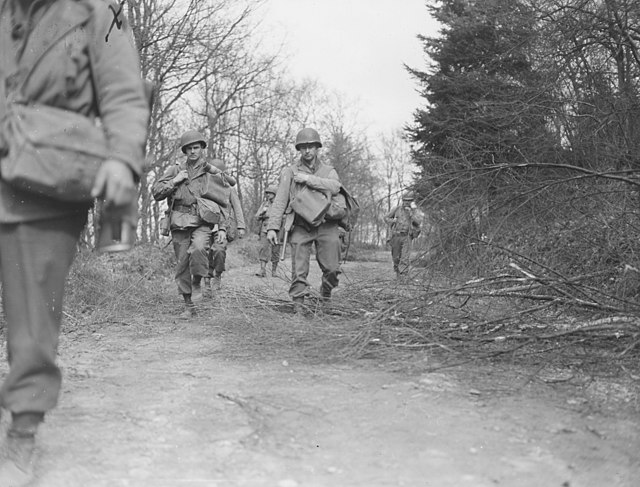 Air War over Europe Air War over EuropeHQ 7th Photographic Group (Reconnaissance) and the 22d Photographic Reconnaissance Squadron move from Mount Farm to Chalgrove, England with F-5s. Units moving from Belgium to Germany: HQ IX Tactical Air Command from Verviers to Bruhl; HQ 48th Fighter Group and the 492d, 493d and 494th Fighter Squadrons from St Trond to Kelz with P-47s. The 72d Liaison Squadron, Ninth AF (attached to Sixth Army Group), moves from Sarreguemines, France to Kaiserlautern, Germany with L-5s. The war weary citizens of the Third Reich were today called upon by Martin Bormann, Hitler's deputy, to become "Werewolf" guerrillas in a last-ditch resistance against the Allies as they invade Germany. Bormann said: "The Werewolf has been born of National Socialism. It makes no allowances and knows no considerations as imposed on regular troops .... Hatred shall be our prayer and revenge our battle-cry ..." 86 RAF Mosquitos to Berlin, 2 each to Erfurt and Paderborn, and 2 which bombed both Berlin and Magdeburg on a 'siren tour'. No aircraft lost. (US Eighth Air Force): 2 missions are flown. Mission 915: 337 B-17s and 527 P-51s are dispatched to attack oil and tank plants in Germany; targets are bombed visually despite poor weather; no aircraft are lost: 1. 185 B-17s are sent to hit the synthetic oil plant at Zeitz (12); 130 others hit the Vomag tank factory at Plauen (130), the secondary; targets of opportunity are Meiningen (25) and Wurzburg (11); 1 B-17 is damaged beyond repair and 25 damaged; 1 airman is KIA and 5 WIA. Escorting are 194 of 238 P-51s. 2. 152 B-17s are sent to hit the Vomag tank factory at Plauen (139); targets of opportunity are Oelsnitz (12) and Markt Erlbach (1); 3 B-17s are damaged beyond repair and 1 damaged; 18 airmen are KIA. 98 of 121 P-51s escort. 3. 110 of 118 P-51s fly a freelance fighter mission for the bombers. 4. 26 of 27 P-51s escort 12 F-5s and 1 Spitfire on photo reconnaissance missions over Germany. 5. 22 of 23 P-51s fly a scouting mission. (US Ninth Air Force): In Germany, around 300 A-20s, A-26s and B-26s hit marshalling yards at Wurzburg, Gemunden, and Flieden, the town of Ruckers, and 2 targets of opportunity; fighters escort the bombers, fly armed reconnaissance, hit special targets and support various ground forces along the front; fighter support is accorded the US 2d, 3d, 7th, and 9th Armored Divisions in the Hachenburg, Montabaur, and Limburg areas, the XII Corps along the Main River from Frankfurt/Main to Aschaffenburg, and Ninth Army elements in the bridgehead area around Gahlen. (US Fifteenth Air Force): 500+ B-17s and B-24s, escorted by P-51s and P-38s attack marshalling yards at Wiener-Neustadt, Strasshof, Bruck an der Leitha, and Neunkirchen, Austria, Bratislava, Czechoslovakia and Szombathely, Hungary; 46 P-38s dive-bomb the bridge at Ybbs, Austria while 26 P-51s, covered by 13 others, strafe rail traffic in the Wiener-Neustadt, Austria-Vienna-Budejovice, Czechoslovakia areas; other P-38s and P-51s fly reconnaissance operations. Battle of the Atlantic 'U-399' (German type VIIC) sunk in the English Channel near Land's End, an unknown depth, in position 49.56N, 05.22W, by depth charges from the British frigate HMS 'Duckworth'. 46 dead and 1 survivor self escaped with Drager gear, PoW. Whilst patrolling off the Dutch coast in company with MTB's 764 and 758, corvette HMS 'Puffin' finds herself in very close proximity to what turned out to be a Biber miniature submarine which she rams aft of the conning tower. This causes the two G7E torpedoes to detonate and 'Puffin' is lifted out of the water by the explosion. Although 'Puffin' was able to make it to port under her own power, she is paid off and not repaired. The only casualty was the operator of the Biber. Italian campaign (US Twelfth Air Force): In Italy, weather grounds the medium bombers and hampers operations in general; during the night of 26/27 Mar, 3 A-20s hit bridges at Cittadella and Verona; fighter-bombers, operating on a reduced scale, hit communications targets in the W Po Valley, cutting a road bridge and several railroads, and attacking several targets of opportunity. Pacific War CHINA (Fourteenth Air Force): In China, 15 B-25s and 80+ fighter-bombers, operating individually or in small flights, continue to disrupt mobility and supply lines throughout S and E China, hitting numerous targets of opportunity chiefly trucks, tanks, supply areas, horses, troops, artillery pieces; several of the fighter-bombers also considerably damage Puchou Airfield. INDIA-BURMA (Tenth Air Force): In Burma, 28 P-47s and 10 B-25s operating over and behind the C Burma battlelines attack artillery positions, troop concentrations, road communications, and supply areas; 522 air supply sorties are being completed throughout the day. GUAM (Seventh Air Force): During the night of 26/27 Mar, 3 B-24s from Guam on individual snooper strikes hit Chichi Jima. 9 Guam-based B-24s pound Marcus in the N Pacific. The capture and occupation phase of the island ends at 0800 hours when Major General James E Chaney becomes Commander. VII Fighter Command: 21 P-51s from Iwo Jima bomb and strafe Susaki Airfield while 16 bomb and strafe weather and radar stations and the town of Kitamura. HQ 21st FG arrives at Central Field, Iwo Jima from Hawaii; the 72d and 531st Fighter Squadrons, 21st FG, move from Mokuleia Field to Iwo Jima with P-51s. SOUTHWEST PACIFIC AREA [Far East Air Force]: B-24s hit Takao, Formosa. The 6th Combat Cargo Squadron, 2d Combat Cargo Group, moves from Biak to Dulag with C-46s. PHILIPPINE CAMPAIGN (1945) TG 78.2 (Captain Albert T. Sprague, Jr.) lands U.S. Army Americal Division (Reinforced) less one RCT, on Talisay Point, Cebu, P.I., covered by TG 74.3 (Rear Admiral Russell S. Berkey), consisting of three light cruisers (including Australian HMAS Hobart) and six destroyers. The landing is made against only slight resistance. U.S. freighter Michael J. Owens Armed Guard gunfire, despite lack of sophisticated fire control equipment, silences Japanese artillery battery on Cebu. Photo: First wave of troops of the 3rd Battalion, 132nd Infantry, Americal Division, crawl ashore under fire during US landing on Cebu Island at point just south of Cebu City (Talisay Beach, north view), 26 March 1945 Photo: First wave U.S. troops from the Americal Division's 3rd Battalion, 132nd Infantry during the landing on Talisay beach, Cebu. Alligator LVTs are visible rolling up in the background, 26 March 1945 Photo: First wave U.S. troops from the Americal Division's 3rd Battalion, 132nd Infantry during the landing on Talisay beach, Cebu. Alligator LVTs are visible rolling up in the background, 26 March 1945 Tank landing craft LCT-1090 is damaged in amphibious operations off Luzon; submarine chaser PC-1133 is damaged by grounding, 10°13'N, 123°51'E. B-24s, B-25s, A-20s, and fighter-bombers bomb Legaspi and targets in the area including a fuel dump at Camalig; fighter-bombers hit numerous targets in the N at Solvec Cove, Baguio, Mankayan, Sante Fe, and other areas; in the SW, A-20s and fighter-bombers support US ground forces, hitting Ternate, and towns in Tayabas and Batangas Provinces. B-24s and A-20s hit Cebu City and E coast targets on Cebu. Map: US Army movement on February 20, 1945 to March 26, 1945 to secure Antipolo and Wawa Dam VOLCANO AND RYUKYU ISLANDS CAMPAIGN On Iwo Jima, the few hundred Japanese troops remaining on the island mount a final suicide attack. They are wiped out by elements of the 5th Marine Division, which have been assigned the task of reducing the last pockets of resistance. About 200 of the Japanese garrison of 20,700 remain alive as prisoners of the marines of US 5th Amphibious Corps. American casualties have been almost 6,000 dead and 17,200 wounded. US naval forces (TF58 and TF52) continue air strikes on Okinawa. US Task Force 54 (Admiral Deyo), with 10 battleships, 10 cruisers and 33 destroyers, begin the main bombardment of Okinawa. The US 77th Infantry Division (General Bruce) lands on Kerama Retto and overruns the small Japanese garrison. The British Pacific Fleet (Admiral Rawlings), also designated Task Force 57, with 4 fleet carriers, 2 battleships, 5 cruisers and 11 destroyers, attacks airfields and other targets on Sakashima Gunto. Japanese submarines make unsuccessful attacks on the Allied ships. Off Okinawa, destroyer Halligan (DD-584) is sunk by mine, 26°10'N, 127°30'E; kamikazes damage battleship Nevada (BB-36), light cruiser Biloxi (CL-80), destroyer Porterfield (DD-682), destroyer escort Foreman (DE-633), high speed minesweeper Dorsey (DMS-1), 26°20'N, 127°18'E; destroyers O'Brien (DD-725), 26°16'N, 127°26'E, and Callaghan (DD-792), 26°20'N, 127°43'E, and minesweeper Skirmish (AM-303), 26°25'N, 127°05'E; destroyer Murray (DD-576) is damaged by dive bomber, 26°20'N, 129°46'E. Photo: Halligan patrolling in vicinity of Okinawa, March 26, 1945, when she struck a mine which caused her forward magazines to explode breaking the ship in two resulting in a high percentage of casualties. Shown: Part of crew in small boat near the wrecked destroyer, March 26, 1945 UNITED STATES NAVY DEPARTMENT COMMUNIQUES, CINCPOA COMMUNIQUÉ NO. 310, MARCH 26, 1945 Carrier aircraft of the U. S. Pacific Fleet attacked airfield and other installations on Okinawa in the Ryukyus on March 26, (East Longitude Date). Shore installations on the island were brought under fire by fast battleships. During these operations our forces were attacked by a small group of enemy aircraft of which six were destroyed. One of our light units suffered some damage. On March 24 Seventh Army Air Force bombers attacked installations on the airfield on Chichi Jima in the Bonins. On the following day targets in the same group were bombed by Mustangs of the Seventh Fighter Command. An enemy air attack was broken up and a number of enemy bombers were destroyed off Iwo Island by Army Black Widow night fighters during the night of March 25-26. No hostile planes reached the island. ALASKA (Eleventh Air Force): In the Kurile s, 2 missions, each by 4 B-25s, attempt to bomb canneries on the Masugawa and the Hayakegawa Rivers; fighters drive off the Masugawa mission and the other mision cannot find the target due to weather. 4 B-24s bomb the Kataoka naval base on Shimushu. PACIFIC Submarine Balao (SS-285) sinks Japanese army stores ship No.1 Shinto Maru, 35°18'N, 123°15'E. British destroyers annihilate Japanese Port Blair-bound convoy east of Khota Andaman. HMS Saumarez, HMS Volage, HMS Vigilant, and HMS Virago sink submarine chasers Ch 34 and Ch 63; HMS Venus, HMS Verulam and HMS Virago sink transport Risui Maru and supply ship Teshio Maru, 10°38'N, 94°42'E. RAF Liberators contribute to Risui Maru's destruction. TF 58 planes sink Japanese auxiliary submarine chaser Nisui Maru east of Fuku Jima, and cargo ship Daia Maru (previously damaged on 1 March) in Kuji Bay, Ryukyus, 20°13'N, 127°16'E. USAAF B-24s complete destruction of Japanese cargo ship I komasan Maru, previously damaged by submarine Spot (SS-413), then run aground, and bombed by USAAF B-25s on 17 March 1945 off Matsu Island 26°07'N, 119°57'E, and sink motor sailships Koun Maru and No.6 Ebisu Maru. USAAF B-24s (Fifth Air Force) bomb Japanese shipping in Takao harbor, sinking cargo vessels Enoura Maru and Kishu Maru, 22°37'N, 120°15'E.
|
|
lordroel
Administrator
Member is Online
Posts: 68,014 
Likes: 49,411
|
Post by lordroel on Mar 27, 2024 3:51:57 GMT
Day 2025 of World War II, March 27th 1945Eastern FrontIn Poland, Soviet forces have penetrated to the final German defense lines at both Gdynia and Danzig. In Hungary and Czechoslovakia, the 2nd and 3rd Ukraine Fronts continue their attacks. The heaviest fighting is along the line of the Raba River where 6th SS Panzer Army suffers heavy casualties in counterattacks. Western Front (1945) - Western Allied invasion of GermanyMap: HQ Twelfth Army Group situation map, March 27th 1945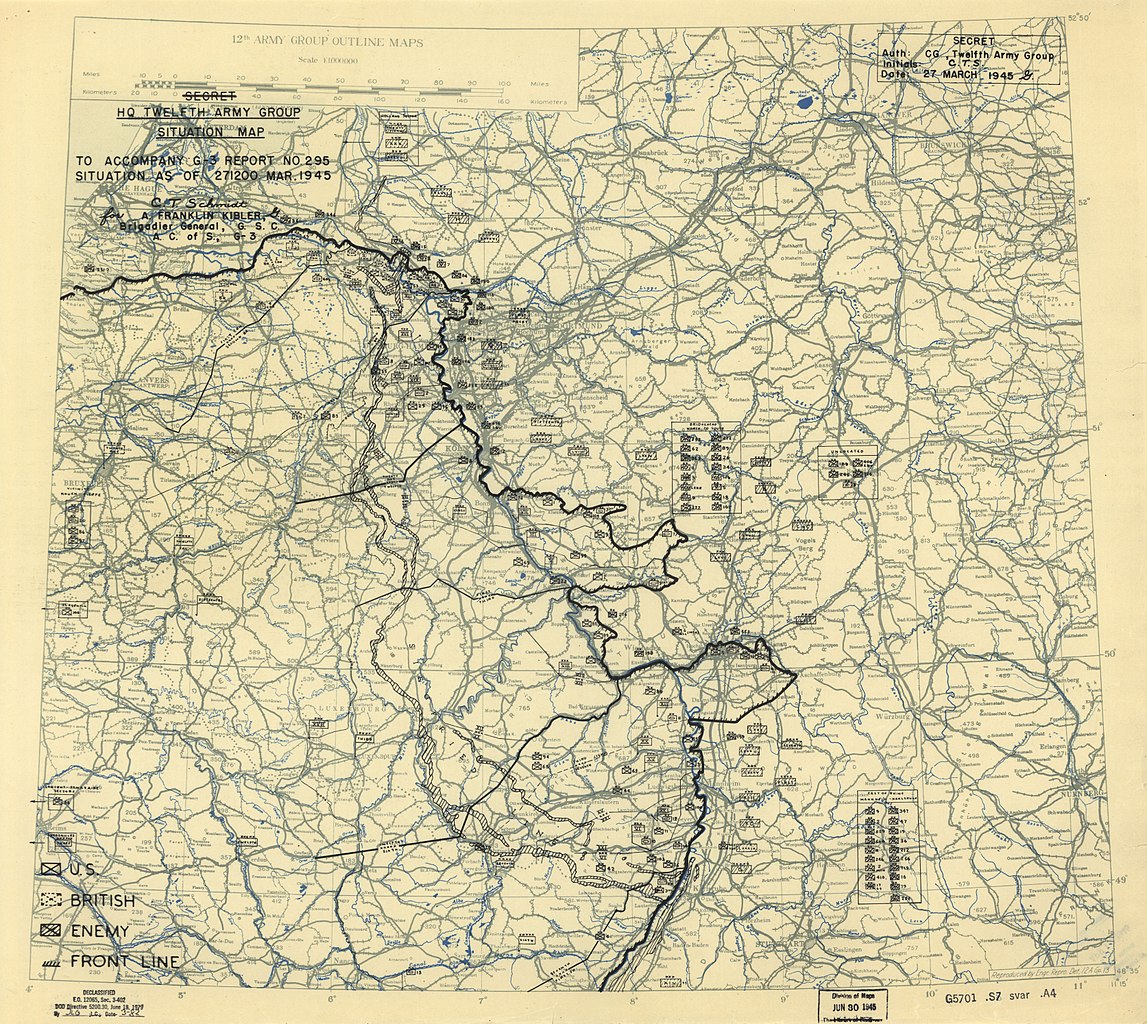 In the northeast sector British 21st Army Group units are advancing along the line of the River Lippe with US 9th Army beginning to penetrate south into the Ruhr industrial area. US 3rd Army has now crossed the Main both west of Frankfurt, where Wiesbaden is attacked, and to the east. Photo: Elements of the 9th Armored Division, 1st U.S. Army, roll through the streets of Limburg, Germany. 27 March, 1945 Photo: Elements of the 9th Armored Division, 1st U.S. Army, roll through the streets of Limburg, Germany. 27 March, 1945 Photo: Elements of the 9th Armored Division, 1st U.S. Army, roll through the streets of Limburg, Germany. 27 March, 1945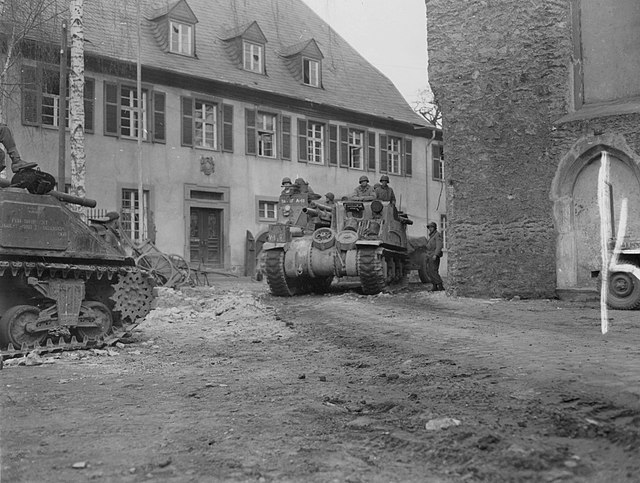 Photo: 1st U.S. Army soldiers stand guard as American vehicles pass over Katzenfurt Bridge over the Dill River, Germany. The bridge was left intact by the fleeing enemy. 27 March, 1945 Photo: 1st U.S. Army soldiers stand guard as American vehicles pass over Katzenfurt Bridge over the Dill River, Germany. The bridge was left intact by the fleeing enemy. 27 March, 1945 Air War over Europe Air War over Europe HQ XII Tactical Air Command moves from France to Germany. The 14th Liaison Squadron, XIX Tactical Air Command (attached to Twelfth Army Group), moves from Luxembourg City, Luxembourg to Oberstein, Germany with L-5s. 268 RAF Lancasters and 8 Mosquitos to attack Paderborn where American troops were attempting to complete the encirclement of the Ruhr. No aircraft lost. The was covered by cloud but the raid was still carried out with almost perfect accuracy and this old town was virtually destroyed in less than a quarter of an hour. 150 RAF Lancasters of No 3 Group carried out G-H raids on 2 benzol plants in the Hamm area. No results were seen, because of cloud, but dense black smoke rose through the cloud from both targets. No aircraft lost. 115 RAF Lancasters of No 5 Group attacked an oil-storage depot (95 aircraft) and a U-boat shelter (20 aircraft of No 617 Squadron) at Farge on the River Weser north of Bremen. Both attacks appeared to be successful. The results of the raid on the oil depot were not known because this target was attacked with delayed-action bombs so that clouds of smoke would not obscure the target. The U-boat shelter was a particularly interesting target. It was a huge structure with a concrete roof 23 ft thick. It was almost ready for use when No 617 Squadron attacked it on this day and penetrated the roof with 2 Grand Slams which brought down thousands of tons of concrete rubble and rendered the shelter unusable. No aircraft were lost in these attacks. 82 Mosquitos to Berlin, 7 to Bremen, 4 to Erfurt and 3 each to Hannover and Magdeburg, 46 RCM sorties, 23 Mosquito patrols, 8 Mosquitos of No 5 Group minelaying in the River Elbe. 4 Mosquitos lost - 3 from the Berlin raid and 1 from the minelaying operation. (US Eighth Air Force): Operations during the day include: 1. 110 of 115 P-47s and P-51s escort 262 RAF Lancasters attacking Paderborn, Germany. 2. 2 F-5s, escorted by 4 P-51s, fly a photo reconnaissance mission over Brunswick and Paderborn. Mission 916: 9 of 10 B-24s drop leaflets in the Netherlands and Germany during the night. Weather cancels 9th Bombardment Division operations. In Germany, IX Tactical Air Command fighters patrol the US First Army front; the XIX Tactical Air Command hits marshalling yards, patrols the Third Army front, flies area cover from Koblenz to Aschaffenburg to Worms, and supports the VIII and XII Corps along the Rhine River in the Wiesbaden area and the Main River in the Frankfurt/Main-Aschaffenburg area. Battle of the Atlantic 'U-905' (type VIIC) is sunk in the Minch Canal in position 58.34N, 05.46W by depth charges from the British frigate HMS 'Conn'. 45 dead (all hands lost). 'U-722' (type VIIC) is sunk near the Hebrides, in position 57.09N, 06.55W, by depth charges from the British frigates HMS 'Fitzroy',' Redmill' and 'Byron'. 44 dead (all hands lost). Italian campaign The 416th Night Fighter Squadron, 62d Fighter Wing, moves from Pisa to Pontedera, Italy with Mosquitos. United Kingdom A German V-2 rocket lands in Deptford, England, killing 52, seriously injuring 32. A German V-2 rocket hits the Hughes Mansions area in Vallance Road, Stepney, England, killing 134, seriously injuring 49. This is the second-highest British death toll by a V-2 rocket, and the second-last to hit England. A V-2 bomb kills 131 people in a London block of flats; 2,745 civilians have been killed by the bombs, and 2,900 aircrewmen have died in the campaign against them. What will be the 1115th and last V-2 rocket to land in England, lands SE of London at Orpington, Kent, killing one and injuring about 70. As well as the 1115 launched at British targets, a further 2050 were aimed at Antwerp, Brussels and Liege. Photo: Ruined flats in Limehouse, East London. Hughes Mansions, Vallance Road, following the explosion of the last German V2 rocket to fall on London, 27 March 1945 German occupied DenmarkPhoto: The sabotage group BOPA places 150 kg. explosives in a train that blew up while it was crossing the bridge, 27 March 1945 German occupied DenmarkPhoto: The sabotage group BOPA places 150 kg. explosives in a train that blew up while it was crossing the bridge, 27 March 1945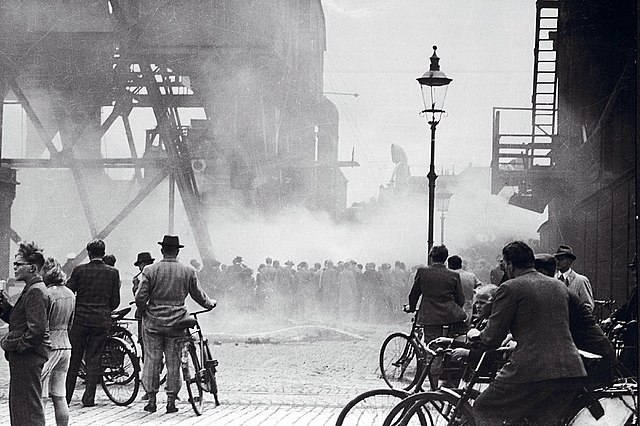 United StatesPhoto: The U.S. Navy repair ship USS Basilan (AG-68) underway in San Francisco Bay (USA), 27 March 1945, after an overhaul United StatesPhoto: The U.S. Navy repair ship USS Basilan (AG-68) underway in San Francisco Bay (USA), 27 March 1945, after an overhaul Pacific War Pacific War CHINA (Fourteenth Air Force): 25 B-25s hit towns, rail, road, and river traffic, and targets of opportunity around Kweilin, Liuchow, Hengyang, Hochih, Kaifeng, Anlu, Ishan, Kiyang, and the Siang Chiang Valley, China and Nanyang, Burma. 44 fighter-bombers hit trucks, trains, sampans, power facilities, and other targets around Nanyo, China and Hongay, Son Tay, Na Cham, Cao Bang, Lang Son, Moc Chau, Muong Hang, and Bac Quang, French Indochina. In China, 28 fighter-bombers knock out a bridge NE of Liuchow, hit the town of Szeenhsien, and attack ammunition dumps and road and river traffic around Hochih, Ishan, Liuchow, Pingnam, Liangfeng, and Kweilin. INDIA-BURMA (Tenth Air Force): In Burma, 80+ fighter-bombers over the battle areas and behind enemy lines in C Burma pound troops and supplies at several locations including the Mong Kung, Man Namkat, Nam-yang, Tonglau, Ho-na, Hkai-wun, Longwai, Monglawng, Laihka, and Namlan areas. Transports are exceptionally active, flying 635 sorties to forward areas. GUAM Seventh Air Force: During the night of 27/28 Mar 5 B-24s, flying individual strikes from Guam , hit Susaki Airfield on Chichi Jima. VII Fighter Command: On Chichi Jima, 16 P-51s from Iwo Jima bomb ammunition stores and the town of Kitamura. PHILIPPINE CAMPAIGN (1945) Cebu City is captured by the US landing force. As on the other islands, the Japanese are beginning to withdraw to inland strongholds where they will be confined and worn down by Filipino forces. Only on Luzon, Mindanao and Negros will the prolonged presence of US troops be necessary. In Manila Bay, an American force lands on Caballo Island, better known to the Americans as Fort Hughes, where they encounter strong Japanese resistance. Photo: U.S. Navy LSM(R) firing rockets in the Kreama Islands in March 1945. The island is described as "Pokishi Shima", which may be Tokashiki island, which was invaded on 27 March by the 306th Regimental Combat Team, U.S. Army. The ships are LSM(R)-196, unknown, LSM(R)-190 and LSM(R)-199 Photo: Landing in the Keramas, made by the 77th Division, met little opposition. Zamani Island (above) was taken by the 1st BLT, 305th Infantry, some soldiers of which are shown just before the started inland. Amtracks were unable to negotiate the seawall and were left at the beach. Below is a scene on a beach at Tokashiki, captured by the 1st BLT, 306th, on 27 March 1945. Soldier (right) seems puzzled by the absence of opposition Photo: Landing in the Keramas, made by the 77th Division, met little opposition. Zamani Island (above) was taken by the 1st BLT, 305th Infantry, some soldiers of which are shown just before the started inland. Amtracks were unable to negotiate the seawall and were left at the beach. Below is a scene on a beach at Tokashiki, captured by the 1st BLT, 306th, on 27 March 1945. Soldier (right) seems puzzled by the absence of opposition B-24s, B-25s, A-20s, and fighter-bombers bomb Legaspi, the Balete area, the Ipo-Siniloan sector, the Batangas area, and several other locations throughout Luzon; fighters support the US amphibious landings on Caballo in Manila Bay. B-24s bomb Negros Airfields while B-25s and P-38s hit the Cebu City area. Other B-25s bomb Kinsui, Formosa, and B-24s lightly attack Sandakan. High speed transport Newman (APD-59), covering the landings on Cebu, sights and attacks a Japanese midget submarine off Talisay, Cebu. She is given credit for a "possible" submersible sunk. VOLCANO AND RYUKYU ISLANDS CAMPAIGN US naval forces, including TF58 and TF52, continue air strikes on Okinawa and TF54 continues bombarding the island. The British Pacific Fleet (Admiral Rawlings), also designated Task Force 57, again attacks airfields and other targets on Sakashima Gunto. A Japanese attack by explosive boats fails. Unsuccessful submarine attacks continue. Photo: The U.S. aircraft carrier USS Hornet (CV-12) operating near Okinawa, Japan, on 27 March 1945. The planes visible on deck belonged to Carrier Air Group 17 (CVG-17). The ship is painted in dazzle pattern Camouflage Measure 33, Design 3A Photo: The U.S. Navy escort carrier USS Makin Island (CVE-93) in the Kerama Retto, Ryukyu Islands, on 27 March 1945. She was the first U.S. aircraft carrier to enter the newly captured anchorage. She is painted Camouflage Measure 32, Design 16A Photo: The U.S. Navy escort carrier USS Makin Island (CVE-93) in the Kerama Retto, Ryukyu Islands, on 27 March 1945. She was the first U.S. aircraft carrier to enter the newly captured anchorage. She is painted Camouflage Measure 32, Design 16A Off Okinawa, an aircraft operational casualty damages carrier Essex (CV-9), 25°10'N, 132°05'E; kamikazes damage light minelayer Adams (DM-27), 26°17'N, 127°40'E. UNITED STATES NAVY DEPARTMENT COMMUNIQUES, N. D. COMMUNIQUÉ NO. 587, MARCH 27, 1945 The submarine USS Albacore is overdue from patrol and is presumed lost. The next of kin of officers and crew have been informed. UNITED STATES NAVY DEPARTMENT COMMUNIQUES, CINCPOA COMMUNIQUÉ NO. 311, MARCH 27, 1945 On March 27, (East Longitude Date) Carrier Aircraft of the U. S. Pacific Fleet continued to attack enemy forces and defense installations in the Ryukyus and surface units attacked coastal objectives with Naval gunfire. Navy search planes of Fleet Air Wing One damaged three small cargo ships in the area around Hachijo Island, 150 miles south of Tokyo on March 26. Liberators of the Seventh Army Air Force bombed the Suzaki airdrome on Chichi Jima in the Bonins on March 25. On the following day storage areas and buildings on Marcus Island were attacked by planes of the same force. Corsair and Hellcat fighters, Helldiver bombers and Avenger torpedo planes of the Fourth Marine Aircraft Wing destroyed buildings and other installations and damaged warehouses, transport and pier facilities on enemy-held islands in the Palaus on March 26 and 27. Marine fighters and torpedo planes strafed and bombed the airstrip on Yap in the Western Carolines on March 27. Search planes of Fleet Air Wing One bombed and strafed small craft and installations at Truk in the Central Carolines on March 26. Navy search Privateers of Fleet Air Wing Two bombed runways, fuel and ammunition dumps and bivouac areas on Wake Island on March 26. Helldiver bombers of the Fourth Marine Aircraft Wing bombed enemy-held bases in Me Marshalls on March 26. PACIFIC Operation STARVATION, the USAAF aerial mining campaign (using Navy-provided mines) commences, as 94 B-29s mine the Shimonoseki Straits and the waters of Suo Nada, Japan. This operation and the six that follow are in support of the Okinawa campaign. Submarine Trigger (SS-237) sinks Japanese cable layer Odate, 200 miles southwest of Kyushu, 30°40'N, 127°50'E. TF 58 planes sink Japanese guardboats No.13 Choun Maru and No.27 Yusen Maru and army cargo ship No.28 Suma Maru, Kuchinoerabu Bay, Osumi-Gunto, 30°30'N, 130°05'E, and No.12 Myojin Maru, west of Tori Jima, 30°00'N, 139°30'E. British submarine HMS Stygian damages Japanese minelayer Wakatake (previously damaged on 25 March 1945 when she encounters a shoal upon leaving Macassar) in Java Sea, south of Kangean Island. Reaching Surabaya on 1 April 1945, Wakatake performs no more active service. USAAF B-24s attack six-ship Japanese convoy off Surabaya, damaging submarine chaser Ch 5 by near-misses. Japanese auxiliary minesweeper Wa.1 is sunk by mine (laid by RAF planes) near the Deli River, Sumatra, 03°52'N, 98°45'E.
|
|
lordroel
Administrator
Member is Online
Posts: 68,014 
Likes: 49,411
|
Post by lordroel on Mar 28, 2024 3:46:39 GMT
Day 2026 of World War II, March 28th 1945Eastern FrontGdynia falls to forces of the Soviet 2nd Belorussian Front. In Hungary, just south of the Danube River, Gyor is captured by troops from the 2nd Ukrainian Front. Western Front (1945) - Western Allied invasion of GermanyMap: HQ Twelfth Army Group situation map, March 28th 1945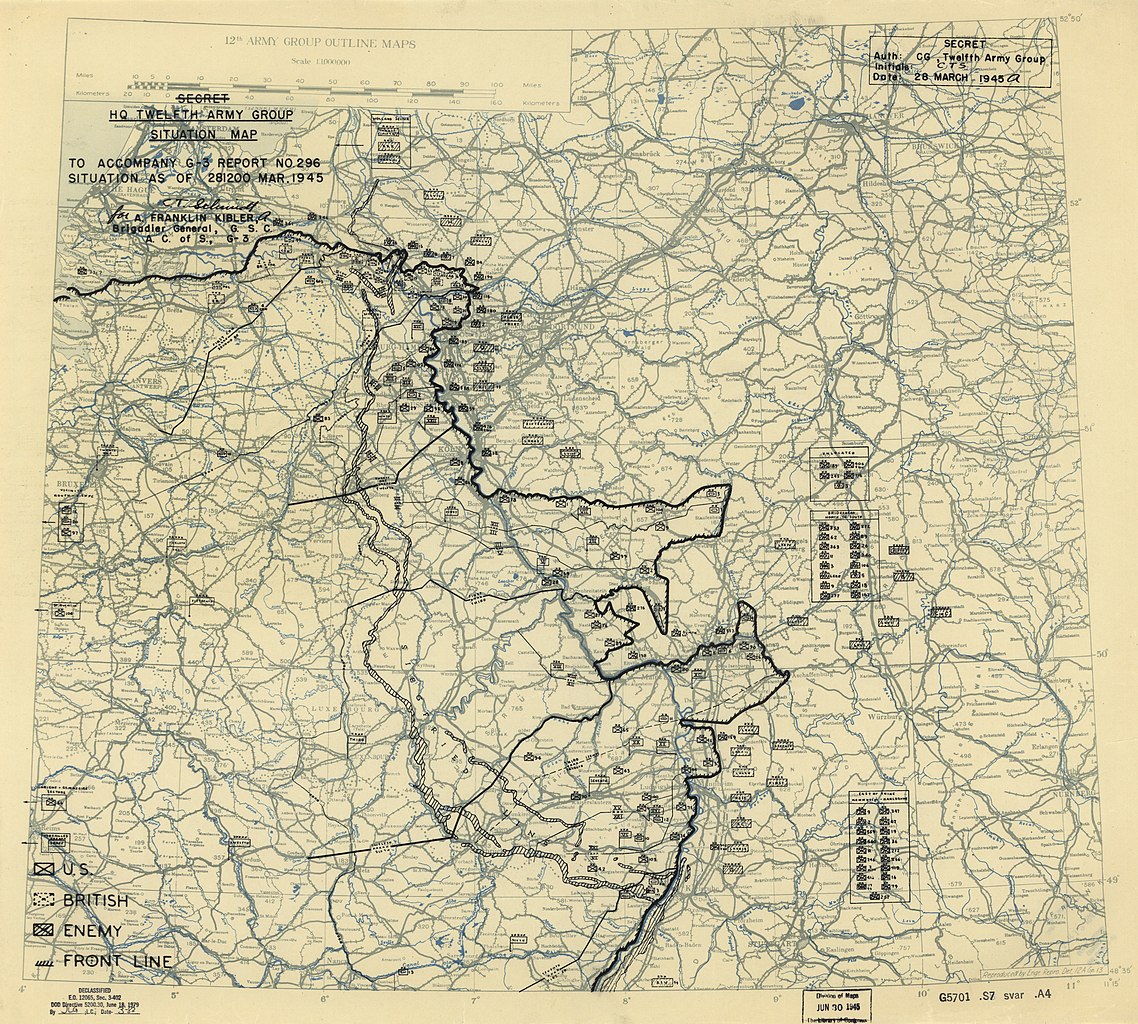 US 1st Army captured Marburg and US 3rd Army captured Limburg am Lahn. Meanwhile, British 2nd Army began an offensive towards the Elbe River. British sappers built another Rhine bridge, "Blackfriars", by noon. Behind the lines, Dwight Eisenhower transferred US 9th Army from Bernard Montgomery's army group to Omar Bradley's army group as Anglo-American objective shifted toward southern Germany and Czechoslovakia. Photo: A Valentine bridgelayer of the 3rd Independent Bridge Building Company, Royal Armoured Corps, spans a damaged bridge near Meiktila, 28 March 1945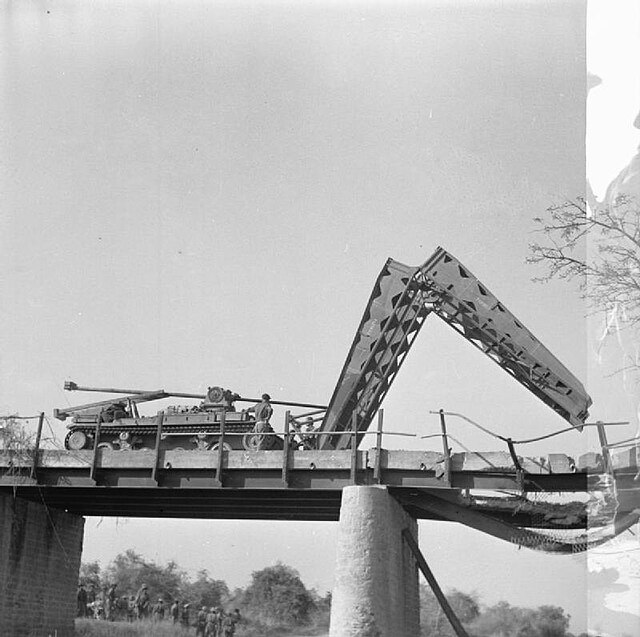 Photo: Men of the 5th Dorsetshire Regiment crossing the Rhine in a Buffalo, 28 March 1945 Photo: Men of the 5th Dorsetshire Regiment crossing the Rhine in a Buffalo, 28 March 1945 Photo: Crouching low for concealment and protection in a DUKW amphibious vehicle, men of the 89th Division, U.S. Third Army, cross the Rhine River at Oberwesel, Germany, 28 March 1945 Photo: Crouching low for concealment and protection in a DUKW amphibious vehicle, men of the 89th Division, U.S. Third Army, cross the Rhine River at Oberwesel, Germany, 28 March 1945  Map: Crossing of the Rhine Map: Crossing of the Rhine Air War over Europe Air War over Europe HQ 36th Fighter Group and the 22d and 23d Fighter Squadrons move from Le Culot, Belgium to Aachen, Germany with P-47s; and the 31st Photographic Reconnaissance Squadron, 10th Photographic Group (Reconnaissance), moves from Jarny, France to Euren, Germany with F-5s. (US Eighth Air Force): Mission 917: 965 B-17s and 390 P-51s are dispatched to hit industrial targets in Berlin and Hannover; 10/10 cloud cover forces the B-17s to bomb using H2X radar; 2 B-17s are lost: 1. 446 B-17s are dispatched to hit the Spandau tank factory (318) and Falkensee armament plant (65) in Berlin; 6 hit Stendal, the secondary; targets of opportunity are Hannover (1) and other (21); 2 B-17s are lost, 5 damaged beyond repair and 133 damaged; 1 airman is KIA, 8 WIA and 19 MIA. Escorting are 245 of 272 P-51s. 2. 519 B-17s are sent to hit the Hanomag tank factory at Hannover (34); 431 hit the secondary, the marshalling yard at Hannover; targets of opportunity are Minden (10) and other (5); 66 B-17s are damaged; 3 airmen are WIA. 86 of 99 P-51s escort. 3. 8 of 9 P-51s escort 3 F-5s on photo reconnaissance missions over Germany. 4. 6 of 10 P-51s fly scouting missions. (US Ninth Air Force): In Germany, 215 A-20s, A-26s and B-26s hit the Neuenheerse and Erbach oil storage depots and 11 targets of opportunity; fighters escort the bombers, fly armed reconnaissance and area cover over wide expanses of German territory, and support the US XII Corps in breakout attacks across the Main River in the Dornigheim area and the 2d and 8th Armored Divisions in the Dorsten area. Italian campaignPhoto: Infantrymen of the Jewish brigade move up to the line. 28 March, 1945 Photo: Artillery of the new Jewish Brigade firing a 25 pounder. 28 March, 1945 Photo: Artillery of the new Jewish Brigade firing a 25 pounder. 28 March, 1945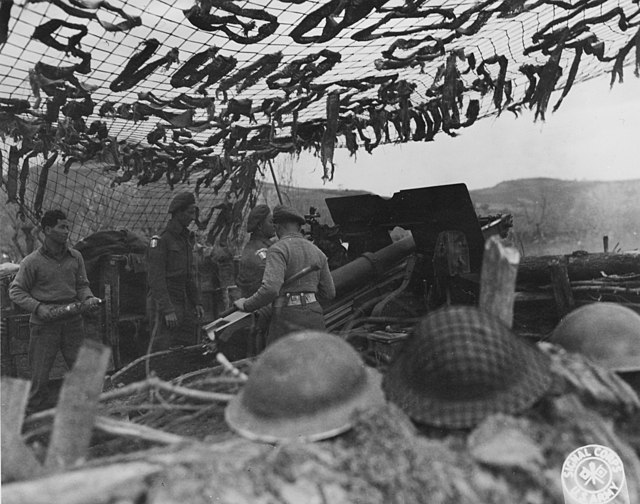 Germany GermanyAfter a heated argument with Hitler, General Guderian is dismissed from his post as Chief of the Army General Staff. His replacement is General Krebs. Soviet Union Stalin receives a personal telegram from General Eisenhower (Supreme Allied Commander of the Allied Expeditionary Force) giving details of his order of battle and saying that he intends to send the main weight of his advance across southern Germany and Austria. The main thrust is to be toward Erfurt and Leipzig and a secondary effort is to go for Nuremberg, Regensburg and Linz. United Kingdom The British protest the signal sent to Stalin, suggesting that decisions of such importance should not be taken by Eisenhower alone and that he also overstepping the authority in communicating directly with the Soviets. Both Churchill and the British Chiefs of Staff would prefer the advance to be directed on Berlin as had been the plan up to now for the political value of this move. However, President Roosevelt, weakened by his illness, leaves most military decisions to General Marshall and the Joint Chiefs of Staff. Marshall confirms his support for Eisenhower in response to the British protest. United StatesPhoto: The U.S. Navy repair ship USS Basilan (AG-68) at San Francisco, California (USA), 28 March 1945. The ship has had many features added since her original conversion. New items (possibly fitted during this overhaul) include the radar test stands (with antennas) on the bow, additional cargo booms, and the landing craft carried above the large ship's boats forward Pacific War Pacific War HQ AAF (Twentieth Air Force): 3 mining missions are flown during the night of 28/29 Mar without loss: Mission 46: 10 of 10 B-29s mine the mouth of the Hwangpoo River and the S channel of the Yangtze River at Shanghai, China. Mission 47: 17 of 18 B-29s mine the waters at Saigon and Camranh Bay, French Indochina. Mission 48: 32 of 33 B-29s mine the Singapore, Malayan States area. INDIA-BURMA (Tenth Air Force): 30+ fighter-bombers operating over and behind the battlelines in C Burma attack troop concentrations, supply areas, elephant transport, and general targets of opportunity at or near Wan Hong, Ho-na, Kyu-sawk, Nawnghkio, and Na-ti; 642 air supply sorties are flown to advanced bases and over the frontlines, where supplies are dropped, throughout the day. BURMA Photo: A scissors bridge laid down over a damaged road bridge near Meiktila by a Valentine bridgelayer of the 3rd Independent Bridge Building Company, Royal Armoured Corps, 28 March 1945 Photo: A Sherman tank crosses a scissors bridge near Meiktila, 28 March 1945 Photo: A Sherman tank crosses a scissors bridge near Meiktila, 28 March 1945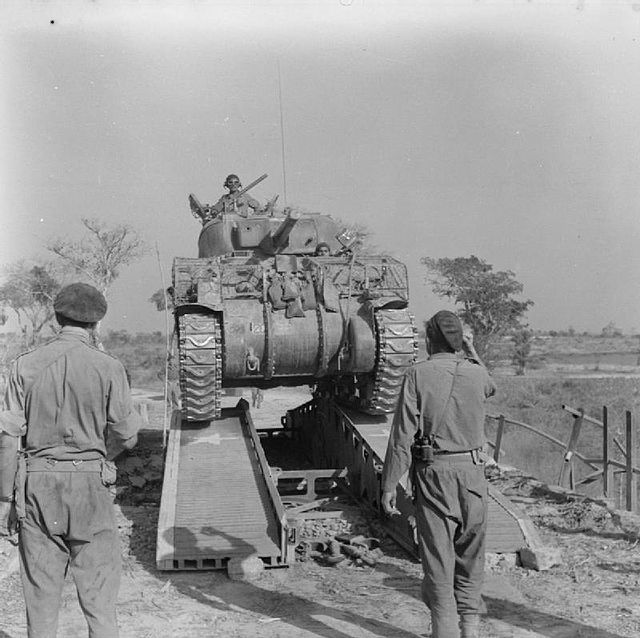 Photo: A Valentine bridgelayer of the 3rd Independent Bridge Building Company, Royal Armoured Corps, picks up a scissors bridge after it was used to cross an estuary near Meiktila, 28 March 1945 Photo: A Valentine bridgelayer of the 3rd Independent Bridge Building Company, Royal Armoured Corps, picks up a scissors bridge after it was used to cross an estuary near Meiktila, 28 March 1945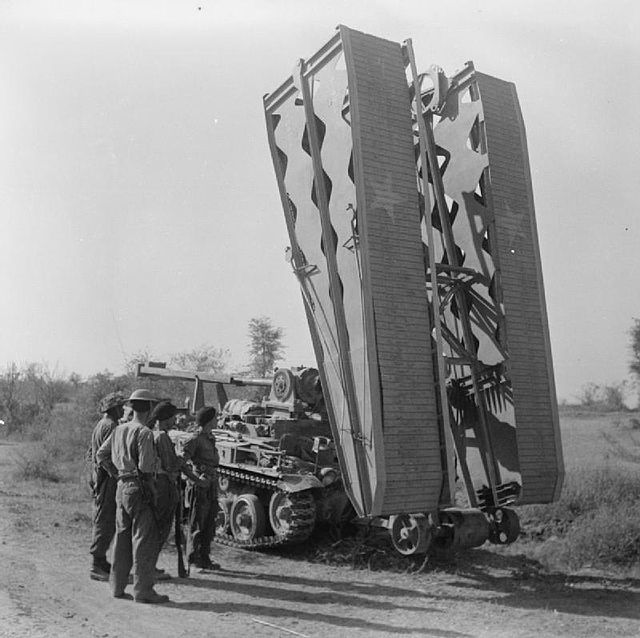 GUAM (Seventh Air Force): 10 Guam based B-24s bomb Truk Atoll flying separate snooper strikes, 5 hit Susaki Airfield during the night of 28/29 Mar. VII Fighter Command: On Chichi Jima 15 P-51s from Iwo Jima hit airfields and defenses. CHINA (Fourteenth Air Force): 6 B-24s bomb Haiphong and Hanoi docks in French Indochina and the Bakli Bay barracks on Hainan . In China, 9 B-25s and 8 P-40s hit rivercraft and other targets from Yanglowtung to Sienning; 9 other B-25s hit junks, storage, and targets of opportunity in the Lushan area and 7 bomb Chingmen; 14 B-25s, operating in groups of 1 to 4 aircraft, hit rivercraft and scattered targets of opportunity at several other points in S and E China; 120+ fighter-bombers over French Indochina and S and E China continue to pound numerous targets of opportunity, mainly river, road, and rail traffic and troop concentrations; rivercraft and airfields in areas around Kai Tek Airfield in Hong Kong and Canton, Hankow, and Wuchang, China are severely hit. In China, the 11th Bombardment Squadron (Medium), 341st Bombardment Group (Medium), based at Yangkai sends a detachment to operate from Chihkiang with B-25s; the 19th Liaison Squadron, 69th Composite Wing, moves from Kunming to Chengkung with L-1s and L-5s. BURMA The Japanese have failed in their efforts to retake Meiktila and while they have been involved in this area, British 33rd Corps has been making important gains to the north. General Kimura, commanding Japanese forces in Burma, decides that with his main line of communications cut, he must try to withdraw his troops to the east of Meiktila. PHILIPPINE CAMPAIGN (1945) B-24s and fighter-bombers hit Balete Pass tracts and ridges, installations at Santa Fe, and ground support targets N of Laguna de Bay and in Cavite and Batangas Provinces and B-25s and A-20s attack troop concentrations at Baguio and Ilagan. Bombers hit the Cebu City area and pound airfields on Negros. B-24s bomb Likanan Airfield on Mindanao. The 39th Troop Carrier Squadron, 317th Troop Carrier Group, moves from Leyte to Clark Field, Luzon with C-47s. VOLCANO AND RYUKYU ISLANDS CAMPAIGN US naval forces, including TF58 and TF52, continue air strikes on Okinawa while TF54 continues bombarding the island. Japanese Kamikaze and submarine attacks continue. Off Okinawa, minesweeper Skylark (AM-63) is sunk by mine, 26°20'N, 127°40'E; attack cargo ship Wyandot (AKA-92) is damaged by near-misses of bombs, 26°00'N, 127°00'E; medium landing ship LSM-188 is damaged by kamikaze; infantry landing craft (gunboat) LCI(G)-588 is damaged by assault demolition boat. Landing craft repair ship Agenor (ARL-3) is damaged in collisions with landing craft off Iwo Jima, 24°46'N, 141°19'E. UNITED STATES NAVY DEPARTMENT COMMUNIQUES, CINCPOA COMMUNIQUÉ NO. 312, MARCH 28, 1945 During the period of March 25 to March 27 inclusive (East Longitude Dates) carrier aircraft of the U. S. Pacific Fleet ranged over the Ryukyu Islands from the Niyako group to Tanega Island, attacking aircraft, shipping and installations. Preliminary reports of damage inflicted on the enemy, in addition to that previously reported, include Ships: Three destroyers or destroyer escorts damaged One large cargo ship damaged Two medium cargo ships damaged Two small cargo ships damaged Many small craft wrecked Eight to ten luggers burned One whaler beached and burned Aircraft: Twenty‑five aircraft shot out of the air Thirteen aircraft burned on the ground Ground installations: Submarine pens at Unten Bay on the west coast of Okinawa heavily hit Gun positions, landing craft, airfields, warehouses, barracks, trucks, and other targets heavily hit at Amami, Tokuno, Okinawa and Kikai Islands. Some of our units suffered damage under enemy air attacks. Hellcat and Corsair fighters, Avenger torpedo planes, and Helldiver bombers, continued their attacks on enemy positions in the Ryukyus and battleships continued to shell shore installations on March 28. On March 27, Navy search Venturas of Fleet Air Wing Four made rocket and machine gun attacks on installations at Tomari Zaki in northeastern Paramushiru in the Kuriles. Liberators of the Eleventh Army Air Force bombed Kataoka on Shimushu on the same date. Mustang fighters of the Seventh Fighter Command and Seventh Army Air Force Liberators attacked Suzaki airdrome on Chichi Jima in the Bonins and struck radar installations on the island on March 26. Fighters also carried attacks on Kitamura Town on Haha Jima on the same date. On March 27 and 28, Mustangs again attacked targets on Chichi Jima and Haha Jima setting fires in ammunition storage areas, buildings and other targets. Neutralizing attacks were made on enemy‑held islands in the Marshalls on March 27 by aircraft of Fleet Air Wing Two. PACIFIC Submarine Blackfin (SS-322) is damaged by depth charges off the southeast coast of French Indochina, and is forced to terminate her patrol. Submarines and USAAF planes begin attacks on Japanese convoy HI-88-J moving up the coast of French Indochina; submarine Bluegill (SS-242) damages tanker Honan Maru (ex-British War Sirdar) off Cape Varella, 12°40'N, 109°30'E; Honan Maru is beached to permit salvage. USAAF B-24 sinks merchant cargo ship Asogawa Maru off Nha Trang, 12°32'N, 109°22'E. Submarine Snook (SS-279) departs Guam for her ninth war patrol; she is contacted by Tigrone (SS-419) on 8 April 1945, but she is never seen again.[8] Submarine Threadfin (SS-410) sinks Japanese escort vessel Mikura off Kyushu, 31°45'N, 131°44'E. Submarine Tirante (SS-420) sinks Japanese fishing boat Nase Maru west of Oniki Cape, southwest coast of Kyushu, 32°15'N, 29°55'E. Submarine Trigger (SS-237) is sunk by Japanese patrol vessel Mikura, Coast Defense Vessel No.33, and Coast Defense Vessel No.59 in Nansei Shoto, 32°16'N, 132°05'E.[9] Floating workshop YR-43, being towed to Kodiak by Army tug LT 373, breaks free from her towline and runs aground two and half miles south of Zaikof Point, Montague Island; rescue tug ATR-68 and Coast Guard lighthouse tender Cedar (WAGL-207) are sent from Kodiak, while tender Bramble (WAGL-392) is dispatched from Seward to assist. Army transport Toloa brings YR-43's crew on board and takes the men to Dutch Harbor. Planes from carrier Hornet (CV-12) sink Japanese Coast Defense Vessel No.33 south of Kyushu, 31°45'N, 131°45'E; USAAF B-24 damages Japanese Coast Defense Vessel No.102 and Coast Defense Vessel No.106 (near-misses) off Keelung, Formosa. USAAF B-24s (Fifth Air Force) sink Japanese army cargo ship Meiho Maru off north coast of Formosa, 25°00'N, 121°00'E. USAAF B-24s (13th Air Force) attack Japanese shipping in the Celebes, sinking minesweeper W.11 off Makassar, 05°06'S, 119°14'E, and Patrol Boat No. 108 off Maniang Island 04°14'S, 121°28'E. Japanese auxiliary submarine chasers Cha 167 and Cha 175 are sunk by aircraft, east of Fukashima. USAAF B-24 damages Japanese cargo ship Seito Maru off North Laut Island 03°14'S, 116°13'E. Japanese auxiliary submarine chaser Cha 178 is sunk by mine, 34°02'N, 130°54'E; cargo ship Tensei Maru is sunk by mine in Wakamatsu harbor.
|
|
lordroel
Administrator
Member is Online
Posts: 68,014 
Likes: 49,411
|
Post by lordroel on Mar 29, 2024 7:04:35 GMT
Day 2027 of World War II, March 29th 1945Eastern Front Soviet troops entered former Czechoslovakian province of Ruthenia. ww2dbase Soviet 1st Byelorussian Front captured Fortress Küstrin in Germany. Western Front (1945) - Western Allied invasion of GermanyMap: HQ Twelfth Army Group situation map, March 29th 1945US Third Army captured Frankfurt and Wiesbaden and US Seventh Army captured Mannheim. British sappers built another Rhine bridge, "Westminster"  Photo: Cromwell tanks of 8th Hussars, the armoured reconnaissance regiment of 7th Armoured Division, massing at Brunen in preparation for the next stage of the advance into Germany, 29 March 1945 Photo: Cromwell tanks of 8th Hussars, the armoured reconnaissance regiment of 7th Armoured Division, massing at Brunen in preparation for the next stage of the advance into Germany, 29 March 1945 Armor of the British 21st Army Group breaks out of the Wesel bridgehead. The US 7th Army captures Mannheim and Heidelberg. Photo: Churchill tanks of 6th Guards Tank Brigade carrying paratroopers of the 17th US Airborne Division, Germany, 29 March 1945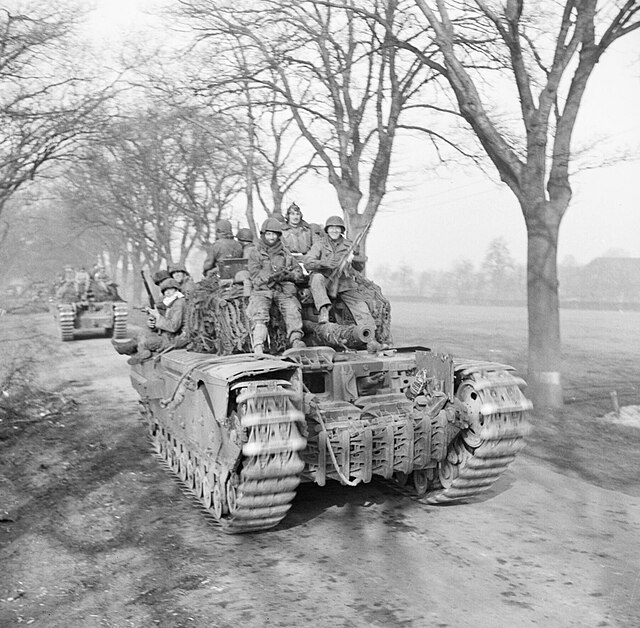 Photo: Churchill tanks of 6th Guards Tank Brigade carrying paratroopers from the American 17th Airborne Division pass through Dorsten, Germany. On the right is an Achilles 17-pdr tank destroyer, 29 March 1945 Photo: Churchill tanks of 6th Guards Tank Brigade carrying paratroopers from the American 17th Airborne Division pass through Dorsten, Germany. On the right is an Achilles 17-pdr tank destroyer, 29 March 1945 Photo: Men of the 9th Durham Light Infantry advance through the ruins of Weseke, 29 March 1945 Photo: Men of the 9th Durham Light Infantry advance through the ruins of Weseke, 29 March 1945 Photo: Men of the 9th Durham Light Infantry clearing resistance in the village of Weseke, 29 March 1945 Photo: Men of the 9th Durham Light Infantry clearing resistance in the village of Weseke, 29 March 1945 Air War over Europe Air War over Europe 130 RAF Lancasters of No 3 Group carried out a G-H raid on the Hermann Goering benzol plant at Salzgitter. No results were seen through the cloud. No aircraft were lost. 48 Mosquitos to Berlin, 7 to Harburg and 3 each to Bremen and Hannover. No aircraft lost. Italian campaign (US Twelfth Air Force): In Italy, clear weather during the night of 28/29 Mar, permits A-20s to hit rail loading points, trains, vehicles, roads, and bridges at many places in the Po Valley as well as river crossings at Borgoforte, Lodi, San Benedetto Po, Ostiglia, and Casalmaggiore, a factory at Brescia, and motor transport movement in the Milan-Piacenza area; bad morning weather cancels medium bomber operations except for a pamphlet mission over Bologna; when the weather clears about 1200 hours, XXII Tactical Air Command fighter-bombers hit dumps at La Spezia and other points near the battle area, the Lavis viaduct, railroad bridges or approaches at Ora, Santa Margherita d' Adige, Nervesa della Battaglia, Rovereto, Ala, and other locations, and many vehicles and train cars and other targets of opportunity throughout the Po Valley and NE Italy; the 16th Troop Carrier Squadron, 64th Troop Carrier Group, based at Rosignano Airfield begins operating from Brindisi with C-47s. Battle of the Atlantic Frigate HMS 'Teme' takes a hit from a Zaunkönig fired by 'U-246' (Kapitanleutnant Ernst Raabe) and loses her stern. She was towed to Falmouth but laid up and not repaired. Location: 6 miles N of Lands End at 50 07N 05 45W. There are 4 casualties. 'U-1106' (type VIIC/41) is sunk north-east of the Faeroes, in position 61.46N, 02.16W, by depth charges from a British Liberator aircraft (Sqdn 224/O). 46 dead (all hands lost). 'U-1169' is sunk in the English Channel south of Lizard Point in position 49.58N 05.25W by depth charges dropped by frigate HMS 'Duckworth'. All 49 of the U-Boat crew are lost. United KingdomSittingbourne, Kent: AA gunners shoot down what is thought to be the last V1 launched against Britain. United StatesFranklin Roosevelt visited Hyde Park, New York, United States and the Franklin D. Roosevelt Library for what would be the last time. Pacific War CHINA (Fourteenth Air Force): 11 B-24s attack shipping in the S China Sea, at Bakli and Samah Bays on Hainan , and at Haiphong, French Indochina, heavily damaging a destroyer and a merchant vessel. In China, 18 B-25s, escorted by 12 P-40s, bomb railroad yards at Yoyang; 4 B-25s claim 6 small steamers sunk and several vessels damaged in the Liuchow area while 2 others hit the town area and railroad targets in the Dong Giao area of French Indochina; single B-25s hit targets of opportunity at or near Loyang, Loning, Neihsiang, Yiyang, and Hsuchang; 90+ fighter-bombers over S and E China and French Indochina attack troops, supplies, transport, and communications targets at several places, concentrating strikes around Hengyang, Chuchou, Isuho, Nanking, and Namyung, and among many targets hit airfields at Amoy and Kai Tek in Hong Kong; the 22d Bombardment Squadron (Medium), 341st BG (Medium), based at Yangkai with B-25s, sends a detachment to operate from Chihkiang. (Twentieth Air Force): Mission 49: 24 of 29 B-29s fly the last mission under the XX Bomber Command, attacking oil storage facilities on Bukum in the Malayan States during the night of 29/30 Mar; 2 other B-29s bomb individual targets on the Malay Peninsula. INDIA-BURMA (Tenth Air Force): Bad weather curtails operations in C Burma; 6 B-25s hit troop concentrations and 8 others attack unsuccessfully 2 bridges immediately behind the enemy lines. Transports complete 560 sorties to forward areas. The 166th Liaison Squadron (Commando), 1st Air Commando Group, moves from Asansol, India to Ondaw, Burma with UC-64s and L-5s. Seventh Air Force: 9 B-24s from Guam bomb Dublon in Truk Atoll. VII Fighter Command: 31 Iwo-based P-51s bomb and strafe Haha Jima. BURMA Photo: The 75mm gun is lifted out of a Sherman tank at 5th Indian Division's tank workshop near Taungtha, 29 March 1945 Photo: A Sherman tank's engine and radiator being repaired at 5th Indian Division's tank workshop near Taungtha 29 March 1945 Photo: A Sherman tank's engine and radiator being repaired at 5th Indian Division's tank workshop near Taungtha 29 March 1945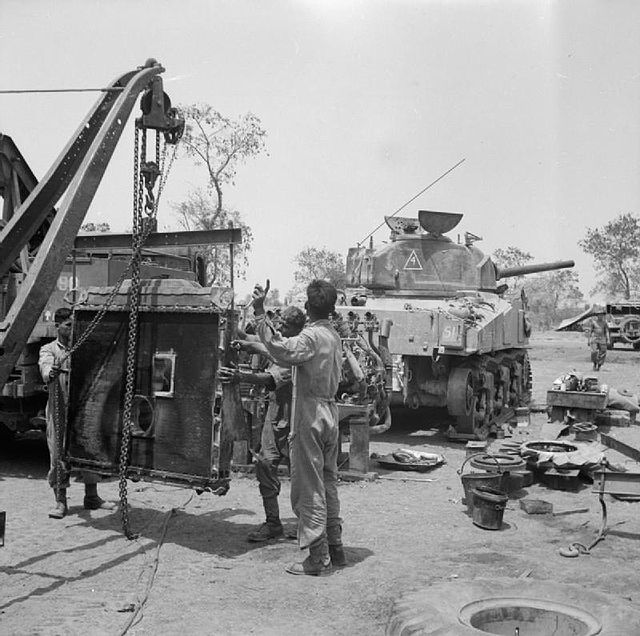 Photo: A Reme welder repairing battle damage on a Sherman tank at 5th Indian Division's tank workshops near Taungtha, 29 March 1945 Photo: A Reme welder repairing battle damage on a Sherman tank at 5th Indian Division's tank workshops near Taungtha, 29 March 1945 TINIAN (Twentieth Air Force): HQ 58th Bombardment Wing (Very Heavy) arrives at West Field, Tinian from India. SOUTHWEST PACIFIC AREA [Far East Air Force]: B-24s and B-25s attack Toshien, Byoritsu, and Eiko, Formosa. B-24s bomb Oelin Airfield in Borneo. PHILIPPINE CAMPAIGN (1945) In an operation associated with the taking of Panay, Army 185th RCT (40th Division), moves from Iloilo to Pulupandan Point, northern Negros, P.I., encountering no opposition. On Luzon, B-24s bomb Camalaniugan, B-24s and P-51s hit Legaspi and the surrounding area, and A-20s and numerous fighters hit various targets in SW Luzon. Cebu is bombed by B-25s in support of ground forces while A-20s support troops landing on Negros. VOLCANO AND RYUKYU ISLANDS CAMPAIGN TG 58.1 (Rear Admiral Joseph J. Clark) and TG 58.3 (Rear Admiral Frederick C. Sherman) attack airfields and Japanese shipping in the Kagoshima Bay area, Kyushu. Carrier-based planes sink auxiliary submarine chasers Cha 200 west of Sata Misaki, 31°05'N, 130°39'E, and Chikuto Maru in Kagoshima Bay, and Cha 205, Kuchinoerabu Jima, 30°30'N, 130°10'E, as well as cargo vessels No.5 Yusen Maru and 11 Ebisu Maru, Holin Maru, Genyo Maru and 8 Seizan Maru and 17 Koshin Maru and 27 Koan Maru and 32 Koan Maru and Taimokuzan Maru in Yamagawa Harbor; merchant vessel No.3 Yamato Maru is damaged at the latter place. ALASKA (Eleventh Air Force): 6 B-24s bomb Kataoka naval base on Shimushu; 8 B-25s weatherabort a mission to Tomari Cape and 1 B-24 flies a radar-ferret mission along the Paramushiru coast. UNITED STATES NAVY DEPARTMENT COMMUNIQUES, N. D. COMMUNIQUÉ NO. 588, MARCH 29, 1945 Philippine Area. 1. The LCS (L) (3)‑7 and LST 577 have been lost in the Philippine Area as the result of enemy action. 2. The next of kin of casualties have been informed. UNITED STATES NAVY DEPARTMENT COMMUNIQUES, CINCPOA COMMUNIQUÉ NO. 313, MARCH 29, 1945 On March 26 and 27 (East Longitude Dates) carrier aircraft of the British Pacific Fleet bombed and strafed installations in the Sakishima group. Twenty enemy aircraft were destroyed on the ground, one small coastal vessel was destroyed and several damaged and the town of Ohama was left in flames. The British Task Force engaged is commanded by Vice Admiral Sir Bernard Rawlings, Royal Navy, with Rear Admiral Sir Philip Vian, Royal Navy, in command of its carriers. It consists of some of the most powerful ships in the British Navy such as HMS King George V and HMS Illustrious. The British Task Force is now under the operational control of Admiral R. A. Spruance, U. S. Navy, Commander, Fifth Fleet. The British Pacific Fleet, of which the task force mentioned is a part, is under the command of Admiral Sir Bruce Fraser, Royal Navy. PACIFIC Submarine and USAAF attacks continue against Japanese convoy HI-88-J; Bluegill (SS-242) further damages tanker Honan Maru off Cape Varella (see 5 April); Hammerhead (SS-264) damages Coast Defense Vessel No. 84 115 miles north of Cape Varella, 14°44'N, 109°16'E; USAAF B-25s (Fifth Air Force) sink Coast Defense Vessel No.18, Coast Defense Vessel No.130 and cargo ship Kaiko Maru, 15°10'N, 109°26'E. Later the same day, PBMs further damage Coast Defense Vessel No. 134 south of Hainan. USAAF B-24 damages Japanese hospital ship Kazura Maru off coast of French Indochina, 15°05'N, 109°23'E. USAAF B-24s (Fifth Air Force) sink Japanese auxiliary submarine chasers Cha 156, Cha 189, Cha 192, and merchant tanker Iwakuni Maru in Takao harbor, 22°40'N, 120°15'E. Japanese auxiliary patrol vessel Pa No.173 is sunk by mine, Wakamatsu, Japan. Japanese submarine chaser Ch 9 is damaged by aircraft, 15°10'N, 109°26'E. Japanese submarine I 47 (equipped with Kaitens) is damaged by 5th Fleet surface ships/craft off Okinawa and forced to return to Kure for repairs.
|
|
lordroel
Administrator
Member is Online
Posts: 68,014 
Likes: 49,411
|
Post by lordroel on Mar 30, 2024 15:06:06 GMT
Day 2028 of World War II, March 30th 1945YouTube (Allies Charge Forward from the Rhine!)Eastern FrontOn the Baltic coast the final German positions in Danzig are overcome by Soviet forces. In Hungary, leading elements of Soviet 3rd Ukrainian Front, advancing beyond the Raba River enter Austria north of Koszeg. To the north of these attacks, 2nd Ukrainian Front is approaching Bratislava in Slovakia. Western Front (1945) - Western Allied invasion of GermanyMap: HQ Twelfth Army Group situation map, March 30th 1945 The US 1st Army advances north out of its salient around Marburg and reaches and crosses the Eder River. US 3rd Army is attempting to strike east and north toward Gotha and Kassel. Commandant of the SS castle of Schloß Wewelsburg in Büren, Germany, Siegfried Taubert, abandoned the castle as US 3rd Armored Division approached. Photo: Churchill tanks of 6th Guards Tank Brigade in Dulmen, Germany, 30 March 1945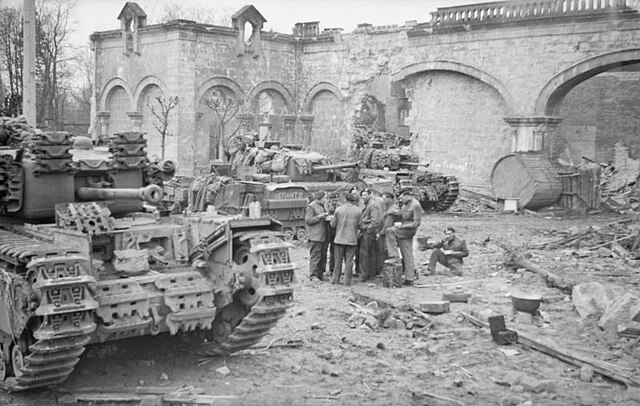 Photo: A Humber scout car and Comet tank of 11th Armoured Division in a devastated German town, 30 March 1945 Photo: A Humber scout car and Comet tank of 11th Armoured Division in a devastated German town, 30 March 1945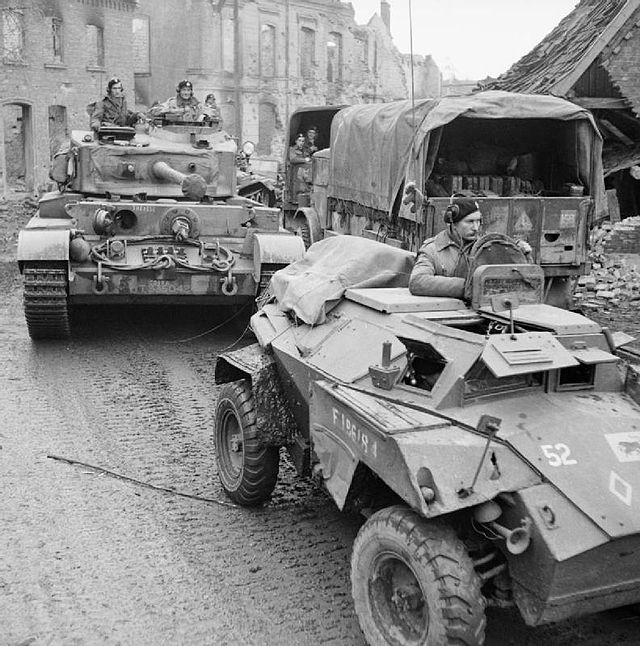 Photo: Comet tanks of 11th Armoured Division drive through a devastated German town, 30 March 1945 Photo: Comet tanks of 11th Armoured Division drive through a devastated German town, 30 March 1945 Photo: Comet tanks of 11th Armoured Division in a devastated German town, 30 March 1945 Photo: Comet tanks of 11th Armoured Division in a devastated German town, 30 March 1945 Photo: Infantry and carriers in Bocholt, 30 March 1945 Photo: Infantry and carriers in Bocholt, 30 March 1945 Photo: Churchill tanks of 6th Guards Armoured Brigade carrying troops of 6th Airborne Division on the advance to Coesfeld, 30 March 1945 Photo: Churchill tanks of 6th Guards Armoured Brigade carrying troops of 6th Airborne Division on the advance to Coesfeld, 30 March 1945 Photo: An Achilles 17-pdr self-propelled gun passes Royal Engineers repairing a bridge during the advance on Coesfeld, 30 March 1945 Photo: An Achilles 17-pdr self-propelled gun passes Royal Engineers repairing a bridge during the advance on Coesfeld, 30 March 1945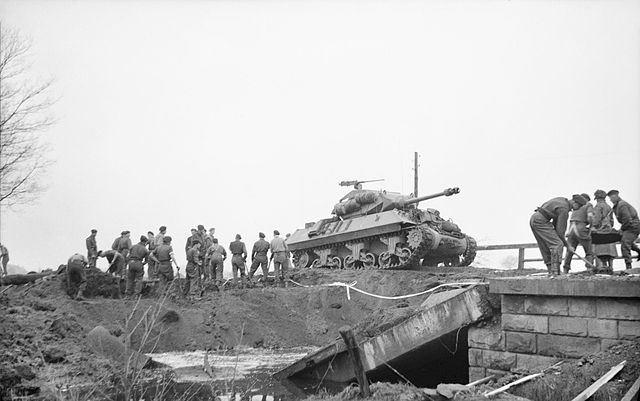 Air War over Europe Air War over Europe (US Eighth Air Force): 2 missions are flown. Mission 918: 1,402 bombers and 899 fighters are dispatched to attack targets connected with U-boat construction or operation; they claim 8-1-12 Luftwaffe aircraft; 5 bombers and 4 fighters are lost: 1. 530 B-17s are sent to hit 2 U-boat yards (64) and an oil depot (169) at Hamburg; 263 bomb the port area at Hamburg, the secondary target; 1 hits Bremen, a target of opportunity; bombing is both visual and using H2X radar; they claim 0-1-3 aircraft; 3 B-17s are lost, 2 damaged beyond repair and 252 damaged; 14 airmen are KIA, 10 WIA and 28 MIA. Escorting are 289 of 304 P-51s; they claim 4-0-7 aircraft in the air and 1-0-1 on the ground; 3 P-51s are lost. 2. 448 B-17s are sent to hit the U-boat yard (318) and rail bridge (109) at Bremen visually and with H2X; 1 B-17 is lost, 1 damaged beyond repair and 225 damaged; 1 airman is KIA, 6 WIA and 11 MIA. The escort is 268 of 287 P-51s; they claim 2-0-1 aircraft. 3. 382 B-24s are dispatched to hit the U-boat yard (273) and Bauhaben port area (85) at Wilhelmshafen both visually and with H2X; 1 B-24 is lost and 56 damaged; 8 airmen are KIA and 1 WIA. 105 P-47s and P-51s escort. 4. 32 of 36 B-17s fly a DISNEY mission to the U-boat yard at Farge; 14 B-17s are damaged. 5. 6 B-17s fly screening missions. 6. 153 of 159 P-51s fly a freelance mission for the bombers; they claim 1-0-0 aircraft. 7. 11 P-51s escort 5 F-5s on photo reconnaissance missions over Germany. 8. 26 of 31 P-51s fly scouting missions. Mission 919: During the night, 13 B-24s drop leaflets in the Netherlands and Germany; 19 B-24s fly CARPETBAGGER missions to Norway; 1 B-24 is lost and 1 crashes in the Orkney Islands. The German cruiser 'Köln' is sunk by aircraft from the US 8th Air Force. 'U-429' (type VIIC) is sunk near Wilhelmshaven in 53.13N 08.40E by US bombs.' U-430' (type VIIC) is sunk near Bremen in position 53.08N 08.46E by US bombs. 'U-348' (type VIIC) is sunk near Hamburg in position 53.33N 09.57E by US bombs. 43 RAF Mosquitos to Berlin, 43 to Erfurt, 4 to Nordingen and 3 each to Hamburg and Kiel, 36 RCM sorties, 31 Mosquito patrols, 6 Mosquitos minelaying in Jade Bay and the River Weser. 1 Mosquito was lost from the Berlin raid. 'U-1167' (type VIIC/41) is sunk near the Deutsche Werke yard in Hamburg due to damage from British bombs. Adolf Hitler issues a decree drafted by Albert Speer, calling for war production to continue until the last possible moment, then for facilities to be crippled if possible, or destroyed otherwise. (US Ninth Air Force): In Germany, 337 A-20s, A-26s and B-26s attack the Bad Oeynhausen tank factory, the Munden ordnance depot, the Ebenhausen oil depot, 2 town areas and 6 targets of opportunity, and drop leaflets; fighters escort the bombers, fly patrols and armed reconnaissance, and support ground forces; fighter support is provided for the US 3d and 7th Armored Divisions near Paderborn and at the Edersee dam on the Eder River, the XII Corps N of Frankfurt/Main, the XX Corps in the Hersfeld and Hanau areas, and the XVI Corps in the Marl-Polsum area. (US Fifteenth Air Force): In Austria, 60+ B-17s and B-24s bomb the Vienna N stations and goods depot, the Graz and Klagenfurt marshalling yards, the Kapfenberg tank works, and several minor targets of opportunity; 28 P-38s and P-51s sweep the Zagreb, Yugoslavia-Graz, Austria area and others fly reconnaissance. HQ 322d Bombardment Group (Medium) and the 449th and 452d Bombardment Squadrons (Medium) from Tille Airfield, Beauvais, France to Le Culot, Belgium with B-26s; HQ 404th Fighter Group and the 506th Fighter Squadron from St Trond, Belgium to Keltz, Germany with P-47s; the 153d Liaison Squadron, IX Tactical Air Command (attached to Twelfth Army Group), from Euskirchen to Bad Godesberg, Germany; the 428th, 429th and 430th Fighter Squadrons, 474th Fighter Group, from Florennes, Belgium to Strassfeld, Germany with P-38s. Italian campaign (US Twelfth Air Force): In Italy during the night of 29/30 Mar, A-20s and A-26s continue to pound Po River crossings, loading points, and other communications in the Po Valley; during the day XXII Tactical Air Command fighters and fighter-bombers fly some 400 sorties against fuel and ammunition dumps, stores, bridges, rail lines, marshalling yards, buildings, motor vehicles, trains, and a variety of targets over wide areas of N Italy; weather forces the medium bombers to attack mainly alternate targets; the B-25s bomb railroad bridges (or bridge approaches) at San Ambrogio di Valpolicella, Rovereto, Chiari, Palazzolo sull'Oglio, Legnago, Ora, and Romano di Lombardia. Photo: A Churchill bridgelayer of 51st Royal Tank Regiment in action during a demonstration in the Mezzano area, 30 March 1945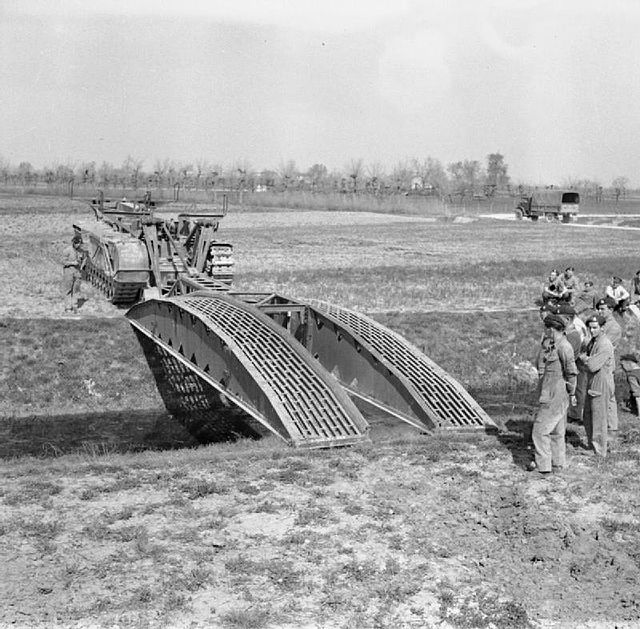 Photo: Members of a 3 inch mortar platoon of the Jewish Inf. Brigade have fried matzo in between German shelling. Pideura area, Italy. 30 March, 1945 Photo: Members of a 3 inch mortar platoon of the Jewish Inf. Brigade have fried matzo in between German shelling. Pideura area, Italy. 30 March, 1945
 Photo: 3 inch mortar crew of the Jewish Inf. Brigade preparing to open fire. 30 March, 1945. Pideura area, Italy Photo: 3 inch mortar crew of the Jewish Inf. Brigade preparing to open fire. 30 March, 1945. Pideura area, Italy
 Battle of the Atlantic Battle of the Atlantic 'U-965' (type VIIC) is sunk north of Scotland, in position 58.19N, 05.31W by depth charges from the British frigates HMS Rupert and HMS Conn. 51 dead (all hands lost). United StatesPhoto: The U.S. Navy destroyer USS Beatty (DD-756) underway off Staten Island, New York (USA), on 30 March 1945 Photo: The U.S. Navy destroyer escort USS Hill (DE-141) off New York City (USA) on 30 March 1945. Hill had been at the New York Naval Shipyard for an overhaul prior to her assignment to the Pacific. The photo was taken by anaircraft from the New York Naval Air Station at Floyd Bennett Field Photo: The U.S. Navy destroyer escort USS Hill (DE-141) off New York City (USA) on 30 March 1945. Hill had been at the New York Naval Shipyard for an overhaul prior to her assignment to the Pacific. The photo was taken by anaircraft from the New York Naval Air Station at Floyd Bennett Field Pacific War Pacific WarCHINA (Fourteenth Air Force): 5 B-24s bomb the Samah Bay area of Hainan . In China, 4 B-25s, supported by 24 P-40s, knock out a bridge at Chungmow; 10 B-25s bomb Hsuchang, 9 bomb Changanyi, and 9 pound the Yanglowtung railroad yards; 15 P-40s fly escort; 2 B-25s bomb Hankow Airfield, 2 bomb Neihsiang, and single B-25s attack targets around Fang-cheng, Nanyang, and Anlu; 100+ fighter-bombers over S and E China hit troops, railroad targets, trucks, tanks, supplies, and rivercraft especially around Hankow, Wuchang, Kanchou, and Hangchow; the airfield area at Kanchou and airfield and railroad yards at Hangchow are hit particularly hard; the 529th Fighter Squadron, 311th Fighter Group, based at Pungchacheng with P-51s, sends a detachment to operate from Hsian. INDIA-BURMA (Tenth Air Force): In the C Burma battle area 41 P-38s and P-47s hit enemy troops and supplies at Loiwing, Pawngleng, and Nawnghkio; 7 B-25s hit personnel, a supply area, and trucks behind the enemy lines in and near Laihka and at Kongleng; 7 other B-25s attack road bridges, knocking out a bridge at Loi Putau; transports complete 612 sorties to forward areas. BURMA Kyaukse is taken by British 20th Indian Division. British forces hold most of the important positions on the road between Mandalay and Meiktila. Japanese forces in central Burma have been brought to battle and defeated exactly as General Slim, commanding British 14th Army, has hoped. The Japanese have not been able to slip away largely intact as they intended, and instead have been compelled to fight the main action with improvised forces against the carefully organized British defense around Meiktila. GUAM (Seventh Air Force): 10 Guam based B-24s bomb the airfield on Marcus in the N Pacific; during the night 5 others individually strike Chichi Jima airfield. (Twentieth Air Force): 2 missions are flown during the night of 30/31 Mar. Mission 48: 12 of 14 B-29s attack the Mitsubishi aircraft engine plant at Nagoya, Japan shortly past 0000 hours without loss. Mission 49: 85 of 94 B-29s mine Shimonoseki Strait between Honshu and Kyushuu s; 2 others drop their mines in other areas; 1 B-29 is lost. PHILIPPINE CAMPAIGN (1945) On Luzon, B-24s bomb the Balete Pass and Solvec Cove areas; P-38s hit artillery positions in the Santa Fe area; B-24s and A-20s hit Legaspi Port and nearby Little Batsan; A-20s and fighter-bombers continue ground support missions in the Laguna de Bay area and W of Ft Stotsenburg. B-24s and A-20s support ground forces on Cebu. B-24s, B-25s, and P-38s hit Bongao, Philippine, and the Sanga Sanga, and Kuching, Borneo area. VOLCANO AND RYUKYU ISLANDS CAMPAIGN US naval forces, including TF58 and TF52, continue air strikes on Okinawa while TF54 continues bombarding the island. A Japanese Kamikaze plane badly damages the Heavy cruiser Indianapolis (CA-35) by kamikaze off Okinawa, 26°25'N, 127°30'E. Unsuccessful submarine attacks continue. British warships including the battleship HMS King George V, under the command of Vice Admiral Sir Bernard Rawlings, and a carrier force led by HMS Illustrious, commanded by Rear Admiral Sir Philip Vian, participated in an attack on the Sakashima Islands, 180 miles south-west of Okinawa, Japan. ALASKA (Eleventh Air Force): 8 B-25s cancel a shipping strike because of weather. UNITED STATES NAVY DEPARTMENT COMMUNIQUES, N. D. COMMUNIQUÉ NO. 589, MARCH 30, 1945 Pacific Area. 1. United States submarines have reported the sinking of 11 enemy vessels, including a large aircraft carrier and two destroyers, as the result of operations in Far Eastern waters. Enemy ships sunk: 1 large carrier 2 destroyers 3 medium cargo vessels 2 escort vessels 1 large tanker 1 medium cargo transport 1 small cargo vessel 2. These actions have not been announced in any previous Navy Department communiqué. UNITED STATES NAVY DEPARTMENT COMMUNIQUES, CINCPOA COMMUNIQUÉ NO. 315, MARCH 30, 1945 Seventeen enemy aircraft were shot out of the air by carrier planes and guns of the U. S. Pacific Fleet operating in the waters off the Ryukyus on March 28 and 29 (East Longitude Dates). In addition, fifteen more enemy planes were destroyed on the ground. Ships' gunfire destroyed four enemy motor torpedo boats on March 29. Shore installations in the Ryukyus were again brought under fire of heavy units of the Pacific Fleet and carrier aircraft continued to attack military installations on March 30. Corsair fighters of the Fourth Marine Aircraft Wing destroyed a building and sank a power boat during attacks on targets in the Palaus on March 30. Marine fighters strafed targets on Sonsoral Island southeast of the Palaus on the same date. PACIFIC Eighty-seven USAAF B-29s mine the Shimonoseki Straits and the waters off Kure, Hiroshima, and Sasebo, Japan. High speed transport Roper (APD-20) is damaged in collision with attack transport Arthur Middleton (APA-25), Philippine Sea, 20°57'N, 132°05'E. Submarine Tirante (SS-420) sinks Japanese guardboat Eikichi Maru off Kagoshima, Japan, 31°11'N, 130°09'E. Attacks against Japanese convoy HI-88-J continue: USAAF B-25s sink auxiliary submarine chaser Shinan Maru and damage Coast Defense Vessel No.26 off Yulin, Hainan Island 18°09'N, 109°42'E. Japanese submarine I 53 is damaged by mine, Suwo-Nada.
|
|
lordroel
Administrator
Member is Online
Posts: 68,014 
Likes: 49,411
|
Post by lordroel on Mar 31, 2024 5:48:17 GMT
Day 2029 of World War II, March 31st 1945Eastern FrontRatibor on the upper Danube is taken by forces of the Soviet 1st Ukrainian Front. Western Front (1945) - Western Allied invasion of GermanyMap: HQ Twelfth Army Group situation map, March 31st 1945 The Allies are poised for the final attack on Germany. Armies are moving round the Ruhr to link up between Munster and Paderborn; Montgomery's 21st Army Group is heading for Germany's Baltic ports; Patton is about to link up with US First Army at Kassel; the US Seventh Army is advancing on Heidelberg while the US Third Army reached Siegen, Germany. The troops of the French First Army crossed the Rhine River near Speyer, Germany, they became the first French troops to attack across the river since Napoleon Bonaparte. Meanwhile, Photo: Tanks of the 11th Armored Division, Third U.S. Army, advance along the Autobahn near Frankfurt, Germany, March 31, 1945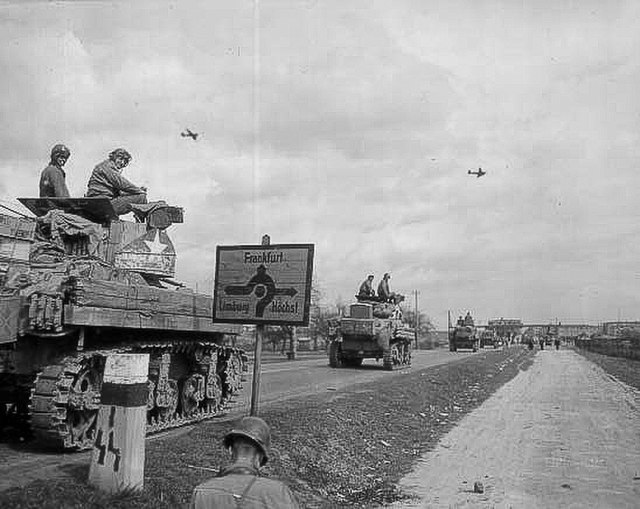 Photo: 9th U.S. Army tanks roll up to the tank near the Rhine River, Germany. 31 March, 1945 Photo: 9th U.S. Army tanks roll up to the tank near the Rhine River, Germany. 31 March, 1945 Photo: Sherman Firefly of 7th Armoured Division near Stadtlohn, 31 March 1945 Photo: Sherman Firefly of 7th Armoured Division near Stadtlohn, 31 March 1945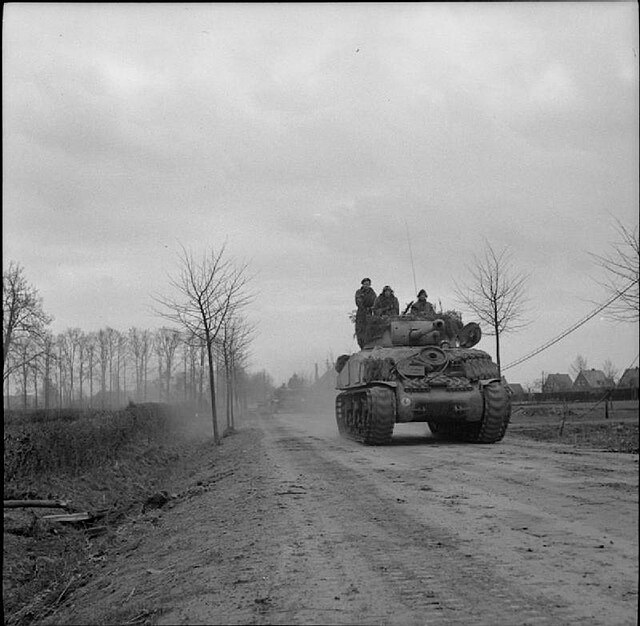 Photo: Ram Kangaroo personnel carriers carrying troops of the 9th Durham Light Infantry near Weske, 31 March 1945 Photo: Ram Kangaroo personnel carriers carrying troops of the 9th Durham Light Infantry near Weske, 31 March 1945 Photo: A Cromwell tank of 7th Armoured Division passes a roadblock in the town of Stadtlohn, 31 March 1945 Photo: A Cromwell tank of 7th Armoured Division passes a roadblock in the town of Stadtlohn, 31 March 1945 Photo: Supply lorries pass burning buildings in Bocholt, 31 March 1945. In the lead is an Austin K5, with a CMP Chevrolet following behind Photo: Supply lorries pass burning buildings in Bocholt, 31 March 1945. In the lead is an Austin K5, with a CMP Chevrolet following behind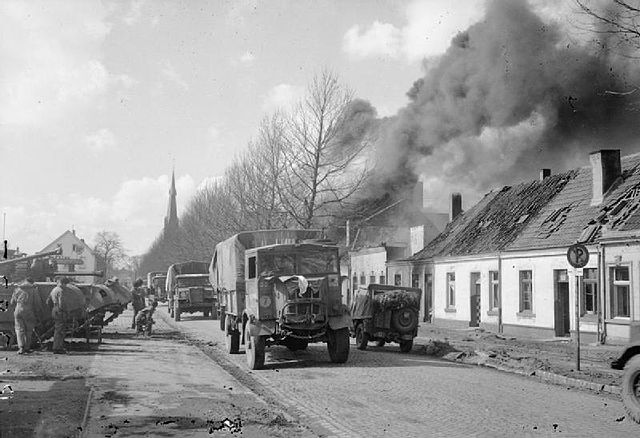 Western Front (1945) - Liberation of the Netherlands Western Front (1945) - Liberation of the NetherlandsGerman forces began withdrawing from the Netherlands. Air War over Europe The 162d Tactical Reconnaissance Squadron, 363d Tactical Reconnaissance Group [attached to Reconnaissance Group (Provisional), XII Tactical Air Command], moves from Azelot to Haguenau, France with F-6s. Hamburg: 469 RAF aircraft - 361 Lancasters, 100 Halifaxes, 8 Mosquitos - of Nos 1, 6 and 8 Groups attempted to attack the Blohm Voss shipyards, where the new types of U-boats were being assembled, but the target area was completely cloud-covered. The local report describes 'considerable damage' to houses, factories, energy supplies and communications over a wide area of southern Hamburg and Harburg. 8 Lancasters and 3 Halifaxes were lost, a number being victims of an unexpected intervention by the Luftwaffe day-fighter force. This was Bomber Command's last double-figure aircraft loss of the war from a raid on one city. (US Eighth Air Force): Mission 920: 1,348 bombers and 889 fighters are dispatched to hit synthetic oil plants, a refinery, munitions plant and tank factory; they claim 9-3-9 Luftwaffe aircraft; 5 bombers and 4 fighters are lost: 1. 229 B-17s are sent to hit the synthetic oil refinery at Zeitz using H2X radar; secondary targets hit are the oil plant at Bad Berka (29) and Gotha (20) visually; targets of opportunity are Erfurt (25) and other (8), hit visually; 3 B-17s are lost, 1 damaged beyond repair and 108 damaged; 1 airman is KIA; 2 WIA and 30 MIA. Escorting are 117 of 120 P-51s; 1 is lost (pilot MIA). 2. 294 B-17s are sent to hit Brandenburg (265); targets of opportunity are Stendal (9) and Salzwedel (9); they claim 0-1-0 aircraft; 1 B-17 is damaged. 207 of 221 P-51s escort claiming 5-0-0 aircraft; 1 P-51 is lost (pilot MIA). 3. 371 of 385 B-24s hit the secondary target, the marshalling yard at Brunswick; they claim 3-2-1 aircraft; 2 B-24s are lost, 3 damaged beyond repair and 3 damaged; 10 airmen are KIA, 1 WIA and 29 MIA. The escort is 253 of 266 P-47s and P-51s; they claim 0-0-7 aircraft; 2 P-51s are lost (pilots MIA). 4. 369 of 432 B-17s attack the secondary, the marshalling yard at Halle; targets of opportunity are Leipzig (8), Weimar (36), Aschersleben (7) and other (1); 37 B-17s are damaged. Escorting are 225 of 233 P-51s. 5. 8 B-17s fly a screening mission. 6. 26 of 30 P-51s fly scouting missions; they claim 1-0-1 aircraft. 7. 19 P-51s escort 8 of 10 F-5s on photo reconnaissance missions. (US Ninth Air Force): In Germany, 550+ A-20s, A-26s and B-26s hit storage depots at Ebrach, Wurzburg, and Marienburg, the marshalling yard at Wurzburg, the town area of Rothenburg ob der Tauber, and a target of opportunity; fighters escort the bombers, hit special targets, fly armed reconnaissance, and support the US 3d and 9th Armored Divisions near Paderborn, the XII Corps as it charges toward Eisenach, the XX Corps along the Fulda and Eder Rivers, and the XVI and XIX Corps S of Haltern and NW of Lippstadt. (US Fifteenth Air Force): 540 B-24s and B-17s bomb the Linz main railroad station and sidings, and the marshalling yards at Villach, Austria and Treviso, Italy and 3 minor targets of opportunity; P-51s and P-38s provide escort; 37 other fighters on sweeps and strafings attack railroad targets in the Munich, Germany-Linz, Austria-Regensburg, Germany area and 43 hit similar targets in the Prague, Czechoslovakia area; still other F-5s, P-38s and P-51s fly extensively reconnaissance and reconnaissance escort. The Me 262s of I and III Gruppen of JG 7, loaded with R4M rockets, intercept the bombers all day, claiming a total of twenty-one bombers destroyed. Double kills go to Oblt. Grunberg, Sturm, Todt, Lt. Schenk, Hptm. Schall and Ehrig. Lt. Weihs and Obfw. Gerhard Reiher also add to their scores. JG 7's Major Ehrler claims a P-51 escorting a bomber formation in a classic 'Herausschuss' maneuver. The 'Herausschuss' tactic acknowledged a pilot's skill in removing an enemy bomber from the collective protection of its formation and shooting it down. Italian campaign (US Twelfth Air Force): In Italy, medium bombers bomb several targets (mostly alternates) in the Po Valley and Brenner area despite bad weather; B-25s hit bridges or bridge approaches at San Michele all'Adige, Crema, Canneto sull'Oglio, Legnago, and Manerbio and Steinach, Austria, and a rail embankment at Salorno; XXII Tactical Air Command A-20s and other aircraft hit Po River crossings during the night of 30/31 Mar at Casalmaggiore, Ostiglia, Borgoforte, and San Benedetto Po, rail facilities at Piacenza and Cittadella, plus nearby ammunition dumps and other targets; fighter-bombers continue to pound communications and dumps at Lavis, Casarsa della Delizia, San Ambrogio di Valpolicella, Legnago, and several other points in the Po Valley and NE Italy; the 97th Bombardment Squadron (Light), 47th Bombardment Group (Light), moves from Grossetto to Pisa with A-20s and A-26s. CanadaCanada's Commonwealth air training program ends. 131,500 aircrew graduated. Photo: The U.S. Navy fleet oiler USS Maumee (AO-2) off the Norfolk Naval Shipyard, Virginia (USA), on 31 March 1945. She is painted in Camouflage Measure 12 Germany GermanyOn Heinrich Himmler's orders, men led by SS-Sturmbannführer Heinz Macher attempted to use tank mines to demolish the SS castle of Schloß Wewelsburg in Büren, Germany. The attempt only damaged the southeast tower, while the rest of the castle, was damaged by fires. The 9,000 SS Ehrenring (SS Honor Rings) stored at the castle were taken away by Macher and were buried at a secret location in nearby woods. ww2dbase Pacific War CHINA (Fourteenth Air Force): In China, 30 B-24s, with an escort of 9 P-51s, blast railroad yards at Shihkiachwang; 12 B-25s bomb railroad yards at Sinyang while 4 hit the Yanglowtung yards; 6 B-25s damage a bridge and hit gun position at Sienning while 6 more knock out a bridge near Ninh Binh, French Indochina and hit storage area at Samah on Hainan Bay; 26 P-51s attack Ningpo Airfield, destroying or damaging several airplanes; 6 of the P-51s are lost; about 125 other fighter-bombers and several B-25s (operating individually) attack numerous targets in French Indochina and S and E China including bridges, troops, supplies, and rail, road, and river traffic. INDIA-BURMA (Tenth Air Force): 12 B-25s hit troop dispersal areas behind enemy lines in C Burma and hit 1 road bridge and 8 P-38s attack supply dump at Namsang Airfield. The 164th Liaison Squadron (Commando), 1st Air Commando Group, moves from Ondaw, Burma to Asansol, Burma with UC-64s and L-5s. Seventh Air Force: During the night of 31 Mar/1 Apr, 5 B-24s from Guam, flying individual harassment strikes, hit Susaki Airfield. VII Fighter Command: 15 P-51s from Iwo Jima bomb and strafe vessels, air installations, and targets of opportunity on Chichi Jima; 16 more follow with attacks on vessels and harbor area. (Twentieth Air Force): Mission 50: 137 of 152 B-29s strike the Tachiarai machine works, which is completely destroyed, and Omura Airfield on Kyushu , Japan; this is a diversionary strike preceding the invasion of Okinawa which begins at 0830 hours local on 1 Apr; the AAF claims 11-5-3 Japanese aircraft; 1 B-29s is lost and 15 damaged. SOUTHWEST PACIFIC AREA [Far East Air Force]: On Formosa, A-20s attack an army camp at Saiatan, P-51s sweep from Babuyan Channel to the SW of the island and B-24s bomb harbors and shipping at Kiirun and Yulin, China. B-24s again bomb Bongao and hit Oelin, Borneo and fighters harass N Borneo airfields. BURMA Northeast of Mandalay, the British 36th Division and units of the Chinese 6th Army take Kyaukme. The Burma Road from Mandalay to Lashio has been cleared of Japanese forces. PHILIPPINE CAMPAIGN (1945) On Luzon, fighters attack targets in the Cagayan Valley and N of Laguna de Bay, blasting bridges and gun positions over wide stretches. B-25s, A-20s, and fighter-bombers hit Cebu targets, several of the strikes being flown in support of ground forces. U.S. freighter John C. Fremont is damaged by mine south of Pier 7, Manila Bay; there are no casualties among the 27-man Armed Guard. VOLCANO AND RYUKYU ISLANDS CAMPAIGN US naval forces, including Task Force 58 and TF52, continue air strikes on Okinawa while TF54 continues bombarding the island. Japanese Kamikaze and submarine attacks continue. Destroyers Morrison (DD-560) and Stockton (DD-646) sink Japanese submarine I 8, 65 miles southeast of Okinawa, 25°29'N, 128°35'E. ULITHI ATOLL Photo: The U.S. Navy escort carrier USS White Plains (CVE-66) at Ulithi Atoll on 31 March 1945, transporting Vought F4U-1D Corsair fighters. The aircraft carrier USS Enterprise (CV-6) is visible in the left background Photo: The U.S. Navy Atlanta-class cruiser USS Flint (CL-97), probably at Ulithi Atoll, 31 March 1945, as the U.S. Fifth Fleet was departing for the Okinawa operation. Flint´s camouflage is Measure 33, Design 22D. Note the two Essex-class carriers in the background, the left one probably being USS Bon Homme Richard (CV-31). USS Tennessee (BB-43) is visible in the background (her sister ship California was under repair at Puget Sound at that time) Photo: The U.S. Navy Atlanta-class cruiser USS Flint (CL-97), probably at Ulithi Atoll, 31 March 1945, as the U.S. Fifth Fleet was departing for the Okinawa operation. Flint´s camouflage is Measure 33, Design 22D. Note the two Essex-class carriers in the background, the left one probably being USS Bon Homme Richard (CV-31). USS Tennessee (BB-43) is visible in the background (her sister ship California was under repair at Puget Sound at that time) UNITED STATES NAVY DEPARTMENT COMMUNIQUES, CINCPOA COMMUNIQUÉ NO. 316, MARCH 31, 1945 During the night of March 27‑28 (East Longitude Dates), barracks, warehouses, radio station, ammunition dump, buildings, and the airdrome on Minami Daito Island were attacked by gunfire of heavy surface forces of the U. S. Pacific Fleet. Fast carrier task forces of the U. S. Pacific Fleet inflicted the following damage on the enemy in and around Kyushu and the Ryukyu Islands on March 28 and 29: Shipping. Sunk: Two destroyer escorts One medium cargo ship Ten small cargo ships Four luggers One motor torpedo boat Probably sunk: Nine medium cargo ships Five small cargo ships Damaged: One destroyer escort Thirteen small cargo ships One medium cargo ship Aircraft: 29 shot out of the air One glider shot out of the air 16 destroyed on the ground 42 damaged or destroyed on the ground Ground installations: Installations on Tokuno and Yaku bombed heavily Hangars and shops at Kanoya, Kagoshima, Kushira, Chiran, Tojimbara, and Ibusuki bombed and burned. Our forces lost twelve planes and six pilots in combat during these actions. On March 30 battleships and light units of the U. S. Pacific Fleet shelled shore installations on Okinawa heavily at close range. Seawalls were breached by gunfire and defenses, gun positions, airfields, and bridges were heavily hit. U. S. carrier aircraft attacked numerous targets on Okinawa destroying four submarine pens and two torpedo boats in the submarine base at Unten Bay on the west coast of the island. Carrier aircraft and heavy units of the Fleet continued their attacks on Okinawa on March 31. On the same date a carrier task force of the British Pacific Fleet struck targets in the Sakishima group. Liberators of the Seventh Army Air Force bombed installations on Marcus Island on March 29. Eleventh Army Air Force Liberators bombed the naval base at Kataoka on Shimushu in the Northern Kuriles on March 30. Corsair fighters of the Fourth Marine Aircraft Wing bombed targets in the Marshalls on March 30. PACIFIC Off Okinawa, heavy cruiser Pensacola (CA-24) is damaged in collision with tank landing ship LST-277, 26°10'N, 127°19'E; kamikazes damage light minelayer Adams (DM-27), 26°12'N, 127°08'E; attack transport Hinsdale (APA-120), 25°54'N, 127°49'E; and tank landing ships LST-724 and LST-884, 25°59'N, 127°50'E. Small seaplane tender Coos Bay (AVP-25) is damaged when rammed accidentally by U.S. merchant ship Matagorda, central Pacific, 12°07'N, 156°27'E. Japanese auxiliary submarine chaser Cha 233 is sunk by aircraft, 32°19'N, 129°50'E. USAAF B-24s attack Japanese convoy off Makassar, sinking small cargo vessels No.3 Hainan Maru, Kanho Maru, Manko Maru, and Nanho Maru and damaging Oshima Maru; attack convoy BASU-05 in Makassar Straits off Balikpapan, damaging submarine chaser Ch 5. USAAF B-24s bomb Japanese convoy in harbor at Keelung, damaging hospital ship Baikal Maru, cargo vessels Nikko Maru and No.3 Yamato Maru, and motor sailship No.47 Suma Maru. Mines damage Japanese destroyer Hibiki off Hime Jima and escort destroyer Inagi off Hesaki. During March 1945 (exact dates indeterminate) carfloats YCF-23 YCF-29, YCF-36, and YCF-37 break up in heavy seas while under tow en route to Eniwetok, Marshall Islands.
|
|
lordroel
Administrator
Member is Online
Posts: 68,014 
Likes: 49,411
|
Post by lordroel on Apr 1, 2024 9:11:02 GMT
Day 2030 of World War II, April 1st 1945Eastern FrontSoviet forces of 3rd Ukrainian Front capture Sopron in western Hungary, to the south of Vienna, in a continuing advance. The 2nd Ukrainian Front, to the north, also continues to advance. On the Oder River, German resistance at Glogau is eliminated by elements of 1st Ukrainian Front. Western Front (1945) - Western Allied invasion of GermanyMap: HQ Twelfth Army Group situation map, April 1st 1945 The US 1st and 9th Armies link up at Lippstadt, cutting off the German forces in the Ruhr which consist of 325,000 men mostly from German 15th Army and 5th Panzer Army of German Army Group B (Field Marshal Model). Other elements of US 1st Army capture Paderborn while US 9th Army units take Hamm. To the north, forces of British 2nd Army have crossed the Mitteland Canal near Munster and are advancing to Osnabruck. Air War over Europe (US Eighth Air Force): Mission 921: 12 B-24s drop leaflets in the Netherlands and Germany during the night without loss. HQ 64th Fighter Wing from Nancy, France to Edenkoben, Germany; HQ 320th Bombardment Group (Medium), from Longvic Airfield, Dijon to Tavaux Airfield, Dole, France. The 72d Liaison Squadron, Ninth AF (attached to Sixth Army Group), moves from Kaiserlautern to Darmstadt, Germany with L-5s. During Apr 45, the following units move: HQ IX Fighter Command from Bruhl to Weimar, Germany; HQ 9th Bombardment Division (Medium) from Reims, France to Namur, Belgium; and HQ 99th Combat Bombardment Wing (Medium) from Beaumont, France to Tirlemont, Belgium. (US Ninth Air Force): No bomber operations due to weather. In Germany, fighters fly patrols, armed reconnaissance, and support the US 3d and 9th Armored Divisions in the Paderborn-Lippstadt and Warburg areas, the XX Corps astride and E of the Fulda River, and the XII Corps which reaches the Werra River W of Meiningen. (US Fifteenth Air Force): Almost 400 B-24s and B-17s bomb the Maribor, Yugoslavia railroad bridge, marshalling yards at Sankt Polten, Selzthal, Zeltweg, Graz, and Villach, Austria, the railroad bridge at Krieglach, Austria, and gun positions on the Adriatic coast near Venice, Italy; 82 P-38s bomb the Ybbs, Austria railroad bridge while 52 P-51s strafe rail traffic in the Prague-Plzen, Czechoslovakia area; other P-38s and P-51s fly reconnaissance and reconnaissance escort. 4 RAF Mosquitos of No 100 Group, operating from a forward airfield in France, patrolled airfields in Southern Germany. 1 Mosquito was lost, hit by flak and seen to crash at Leipheim, a small airfield near Ulm. Seven USAAF bombers fall to the guns of Me 262s from JG 7. But due to the advancing Allies the I Gruppe of JG 7 are ordered evacuate Kaltenkirchen and move further into Germany. 1st Staffel moves to Brandenburg, 2nd Staffel to Burg and 3rd Staffel to Oranienburg. Italian campaign British Guards and Commando units attack over the River Reno between Lake Comachio and the sea. Cesena: In a small cinema here four days ago, the commander of the Eighth Army, Lt-Gen Richard McCreery, summoned all officers over the rank of lieutenant-colonel. His intention, he told them, was to destroy the Germans south of the river Po in what could be the last great battle of the gruelling Italian campaign. Soon the Germans will face a massive assault from armies which include Americans (many of Japanese origin), Britons, Brazilians, Italians, New Zealanders, Poles, Indians, Gurkhas and a Jewish brigade. British commandos began their attack east of Lake Comacchio tonight. (US Twelfth Air Force): In Italy during the night of 31 Mar/1 Apr, A-20s and A-26s on intruder missions over the Po Valley continue to attack road and railroad bridges, motor transport, loading points, and other targets; principal strikes are made at Po River bridges; fighters and fighter-bombers during the day strike rail bridges, dumps, rail lines, marshalling yards, trains, vehicles, gun positions, several buildings (including an ammunition plant and truck factory), and a variety of targets of opportunity in the Po Valley and NE Italy; medium bombers hit railroad bridges at Calcinato, Crema, Mantua, Monselice, Colle Isarco, San Ambrogio di Valpolicella, and Perea. HQ 87th Fighter Wing is disbanded at Florence; HQ 321st Bombardment Group (Medium) moves from Solenzara, Corsica to Falconara. Finland Finnish Air Force changes its national insignia from blue swastika to a white-blue-white roundel. Soviet Union The highest Soviet military command, Stavka, formulates the political goals of the strategic strikes of the coming summer: "to purge our country of fascist invaders and reach the Barents Sea - Black Sea line". France Notre Dame and the Arc de Triomphe are floodlit for the first time since the war broke out. Pacific WarCHINA (Fourteenth Air Force): 4 B-25s attack railroad targets at Ninh Binh and Minh Koi, French Indochina. In China, 7 B-24s bomb the Ft Bayard storage area; 6 B-25s and 6 P-51s attack river shipping and warehouses in the Sienning-Puchi area; 5 B-25s hit warehouses and other buildings at Hsuchang while 3 damage a bridge at Changtuikuan; single B-25s bomb targets of opportunity around Sanshihlitun, Sichuan, Loning, and Suicheng; 23 P-51s pound airfields in the Shanghai area; 70+ other fighter-bombers attack river, road, and rail traffic, storage areas, troops, and general targets of opportunity throughout wide areas of occupied S and E China; the detachments of the 11th and 22d Bombardment Squadrons (Medium), 341st Bombardment Group (Medium), operating from Chihkiang with B-25s, return to base at Yangkai; during Apr 45, the 426th Night Fighter Squadron, Fourteenth AF (attached to 312th Fighter Wing), based at Shwangliu with P-61s, sends detachments to operate from Liangshan and Ankang. INDIA-BURMA (Tenth Air Force): In Burma, 10 B-25s attack roads and bridges behind enemy lines in C Burma; 478 transport flights are made throughout the day; British 36 Division forces begin to push down the railroad from Mandalay to Rangoon. Unit moves In India: 12th Combat Cargo Squadron, 3d Combat Cargo Group, from Moran to Tulihal with C-47s; detachments of the 24th Combat Mapping Squadron, 8th Photographic Reconnaissance Group, operating from Tulihal and Cox's Bazar with F-7s, return to base at Guskhara. SAIPAN (Seventh Air Force): The detachment of the 28th Photographic Reconnaissance Squadron, VI Air Service Area Command (attached to VII Fighter Command), operating from Peleliu with F-5s, joins the detachment operating from Saipan. TINIAN HQ AAF (Twentieth Air Force): During Apr 45, the 25th Bombardment Squadron (Very Heavy), 40th Bombardment Group (Very Heavy), the 676th, 677th and 678th Bombardment Squadrons (Very Heavy), 444th BG (Very Heavy), and the 768th, 769th and 770th Bombardment Squadrons (Very Heavy), 462d BG move from Chakulia, Dudhkundi and Piardoba, India respectively to West Field, Tinian Island, Mariana Islands with B-29s. MIDWAY Photo: Aerial of the U.S. Navy Naval Air Station Midway, with Sand Island in the foreground, 1 April 1945 Photo: Aerial of Eastern Island, Naval Air Station Midway, 1 April 1945 Photo: Aerial of Eastern Island, Naval Air Station Midway, 1 April 1945 SOUTHWEST PACIFIC AREA [Far East Air Force]: B-24s attack Giran Airfield on Formosa while B-25s and P-47s sweep wide areas. On Luzon Island, B-24s, A-20s, and fighter-bombers hit the Legaspi area (where a US amphibious landing is taking place), targets N of Balete Pass, the Batangas area, and support troops over parts of S and NW Luzon. Unit moves during Apr 45: HQ Fifth Air Force from Mindoro Island, Philippine Islands to Clark Field, Luzon; 4th Photographic Charting Squadron, 311th Photographic Wing (Mapping and Charting) [attached to 4th Photographic Group (Reconnaissance)], based at Hollandia, New Guinea with F-7s, sends a detachment to operate from Zamboanga, Mindanao Island, Philippine Islands, to map areas of the SW and W Pacific (another detachment is operating in Australia). PHILIPPINE CAMPAIGN (1945) The US 158th Regiment (General MacNider) lands at Legaspi in the southeast of Luzon and takes the town and nearby airfield. Elsewhere on Luzon American forces are beginning to advance toward the southeast of Manila after much hard fighting against the Japanese forces of the Shimbu Group (General Yokoyama). Forces of the Japanese 14th Army (General Yamashita), in the north of the island, have also engaged by American and Filipino forces. On Luzon Island, Far East Air Forces B-24s, A-20s, and fighter-bombers hit the Legaspi area in support of the landings above, targets north of Balete Pass, the Batangas area, and support troops over parts of southern and northwestern Luzon. In the central Philippine Islands, B-25s and A-20s support ground forces near Cebu City on Cebu Island and on Negros Island. VOLCANO AND RYUKYU ISLANDS CAMPAIGN On Okinawa, American forces launch Operation Iceberg, the invasion of Okinawa. YouTube (Invasion of Okinawa Begins - 1945)Two corps of the US 10th Army (General Buckner) land in the area of Hagushi, in the southwest of the island. US Task Force 51 (Admiral Turner) provides the 1,200 transports and landing ships with over 450,000 Army and Marine Corps personnel embarked. The troops landed are from US 3rd Amphibious Corps (Geiger) with US 6th and 1st Marine Divisions, on the left or northern flank, and 24th Corps (Hodge) with US 7th and 96th Infantry Divisions, on the right or southern flank. Map: Map shows location of the Hagushi landing beaches (Green, Red, Blue, Yellow, Purple, Orange, White and Brown) on Okinawa 1 April 1945 On land, US forces encounter almost no resistance on the first day and establish a beachhead three miles deep and nine miles wide. (Okinawa is 70 miles long and a maximum of 10 miles wide.) Kadena and Yontan airfields are captured. Japanese forces on the island, consisting of the 130,000 troops of the Japanese 32nd Army (General Ushijima), are entrenched in concealed positions and caves, mostly to the south of the American landing area along the Shuri Line. (There are also 450,000 civilians on the island.) Photo: The U.S. Navy destroyer USS Hutchins (DD-476) operating off Okinawa on 1 April 1945, during the landings there. Other destroyers are in the background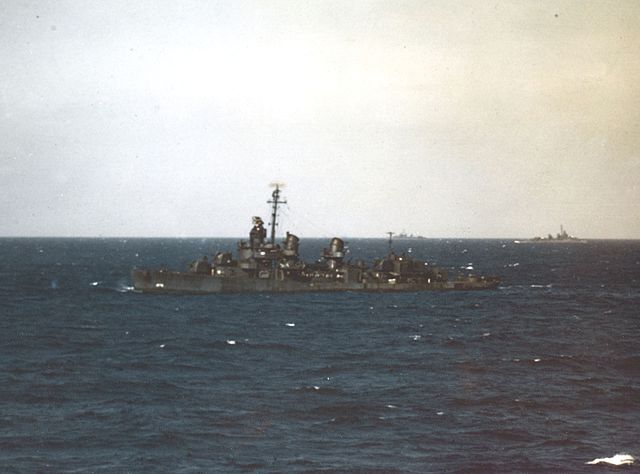 Photo: USS Tennessee (BB-43) bombarding Okinawa with her 14"/50 main battery guns, as Landing Vehicle Tracked(LVT) in the foreground carry troops to the invasion beaches, 1 April 1945 Photo: USS Tennessee (BB-43) bombarding Okinawa with her 14"/50 main battery guns, as Landing Vehicle Tracked(LVT) in the foreground carry troops to the invasion beaches, 1 April 1945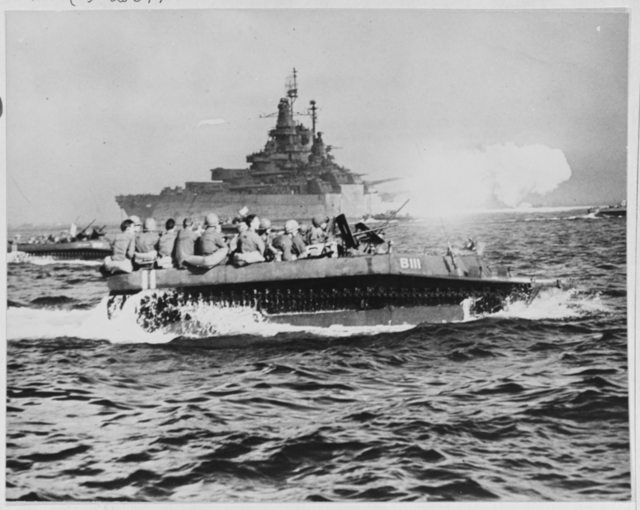 Photo: Troops of 7th Infantry Division land on Orange Beach 2, Okinawa, in swarms of alligators, 1 April 1945 Photo: Troops of 7th Infantry Division land on Orange Beach 2, Okinawa, in swarms of alligators, 1 April 1945 Photo: Amphibious tractors land on the beach, 1 April 1945 Photo: Amphibious tractors land on the beach, 1 April 1945 Photo: Infantrymen disembark from landing craft after hitting beach at Okinawa, Ryukyu Islands, 1 April 1945 Photo: Infantrymen disembark from landing craft after hitting beach at Okinawa, Ryukyu Islands, 1 April 1945 Photo: An Infantryman of the U.S. Tenth Army advances cautiously on a Jap pillbox during the first day of the attack on Okinawa, 1 April 1945 Photo: An Infantryman of the U.S. Tenth Army advances cautiously on a Jap pillbox during the first day of the attack on Okinawa, 1 April 1945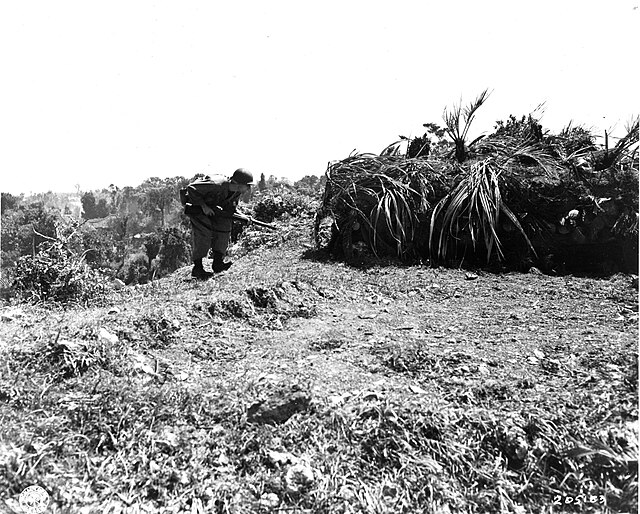 Photo: Troops of 96th Division pause at the pass leading to Chatan village, Okinawa, while amphibious tanks move up in support, 1 April 1945 Photo: Troops of 96th Division pause at the pass leading to Chatan village, Okinawa, while amphibious tanks move up in support, 1 April 1945 Photo: Assault troops of the 96th Division, first American soldiers to land on Okinawa, climb the sea wall on the western shore of the island, 1 April 1945 Photo: Assault troops of the 96th Division, first American soldiers to land on Okinawa, climb the sea wall on the western shore of the island, 1 April 1945 At sea, US TF58 and TF54 as well as the British Pacific Fleet conduct air and naval bombardments. Japanese conventional and Kamikaze air strikes hit the battleship USS West Virginia, and the carrier, HMS Indomitable, along with eight other ships. UNITED STATES NAVY DEPARTMENT COMMUNIQUES, CINCPOA COMMUNIQUÉ NO. 317, APRIL 1, 1945 The United States Tenth Army, whose principal ground elements include the Twenty‑Fourth Army Corps and the Marine Third Amphibious Corps, invaded the west coast of the island of Okinawa in the Ryukyus in great force on the morning of April 1 (East Longitude Date). This landing is the largest amphibious operation of the war in the Pacific to date. Admiral R. A. Spruance, USN, Commander Fifth Fleet, is in overall tactical command of the operation. The amphibious phase of the operation is under command of Vice Admiral Richmond Kelly Turner, USN, Commander Amphibious Forces, Pacific Fleet. The Tenth Army is under command of Lieutenant General Simon Bolivar Buckner, Jr., U.S.A. The landings were made by ships and landing craft of the United States Fifth Fleet supported by the guns and aircraft of that fleet. The attack on Okinawa has also been covered and supported by attacks of a strong British carrier task force under Vice Admiral Sir Bernard Rawlings against enemy positions in the Sakishima group. Troops of the Twenty‑Fourth Army Corps are commanded by Major General John R. Hodge, U.S.A., and the Marines of the Third Amphibious Corps are commanded by Major General Roy S. Geiger, USMC. The attack on Okinawa was preceded by the capture of the islands of the Kerama group west of the southern tip of Okinawa which commenced on March 26. The amphibious phases of this preliminary operation were commanded by Rear Admiral I. N. Kiland, USN The troops consisted of the Seventy‑Seventh Army Division under command of Major General Andrew D. Bruce, U.S.A. The capture of these outposts was completed prior to the main landings on Okinawa and heavy artillery is now emplaced there and in support of the Okinawa attack. The amphibious support force is under command of Rear Admiral W. H. P. Blandy, USN, who was also present at the capture of the Kerama group of islands and in general charge of those operations. The battleships which form the principal gunfire support element are commanded by Rear Admiral M. L. Deyo, USN. Fast Carrier Task Forces of the U. S. Pacific Fleet which are participating in the attack are under command of Vice Admiral Marc A. Mitscher, USN The escort carriers which are supporting the attack are under command of Rear Admiral C. T. Durgin, USN. More than 1,400 ships are involved in the operation. The landings were preceded by and are being covered by heavy gunfire from battleships, cruisers and light units of the U. S. Pacific Fleet. U. S. carrier aircraft are providing close support for the ground troops. Strategic support is being given by the shore‑based air forces of the Southwest Pacific Area, the Pacific Ocean Areas, and by the Twentieth Air Force. The operation is proceeding according to plan. The troops who went ashore at (1830, Tokyo time, advanced inland rapidly and by 1100 had captured the Yontan and Kadena airports with light losses. The capture of Iwo Island gave us an air base only 660 miles from Tokyo and greatly intensified our air attacks on Japan. The capture of Okinawa will give us bases only 325 miles from Japan which will greatly intensify the attacks by our fleet and air forces against Japanese communications and against Japan Itself. As our sea and air blockade cuts the enemy off from the world and as our bombing increases in strength and proficiency our final decisive victory is assured. UNITED STATES NAVY DEPARTMENT COMMUNIQUES, CINCPOA COMMUNIQUÉ NO. 318, APRIL 1, 1945 United States forces on Okinawa advanced inland rapidly throughout the first day of the assault and by 1800 on April 1 (East Longitude Date) forward elements of the Twenty‑Fourth Army Corps and Marine Third Amphibious Corps had expanded the beachhead to a three mile depth at several points. Enemy resistance continued to be light. Sporadic mortar and artillery fire fell on the beaches early in the day. The landing beaches were made secure against small arms fire as our forces deepened their positions behind the beaches. Heavy units of the Fleet continued to shell enemy installations on the island and carrier aircraft gave close support to the ground troops throughout the day. Four enemy planes attacking our surface forces were destroyed. Unloading of supplies on the beaches has begun. Installations on Ishigaki and Miyako Islands in the Sakishima group were heavily hit by carrier aircraft of the British Pacific Fleet on March 31 and April 1. Of 20 Japanese aircraft which landed in the Sakishimas during these attacks, 14 were destroyed and 6 damaged by British aircraft. Mustangs of the Seventh Fighter Command bombed Susaki airfield and harbor installations at Chichi Jima and other targets on Haha Jima in the Bonins on March 31. Corsair and Hellcat fighters bombed supply areas in the Palaus on March 31. One of our fighters was destroyed but the pilot was rescued. On the same date, Marine fighters bombed the airstrip on Yap in the western Carolines. PACIFIC In the third of six mine drops carried out in support of Iceberg, six USAAF B-29s mine the waters off Kure, Japan. Mines sink merchant cargo ship Karikawa Maru off Tsushima, and damage escort vessel Inagi southeast of Hesaki, and auxiliary submarine chaser Cha 226 in Kii Channel, Japan, 30°04'N, 130°54'E. Submarine Queenfish (SS-393) inadvertantly sinks Japanese relief ship Awa Maru in Formosa Straits, 25°25'N, 120°07'E. Awa Maru, a cartel ship, is carrying Red Cross supplies earmarked for distribution to Allied POWs in Singapore. Guaranteed safe conduct by the U.S. government, Awa Maru is properly marked and lighted, but Queenfish's commanding officer, Lieutenant Commander Charles E. Loughlin, does not discern the markings in the foggy weather in which his boat encounters the enemy vessel. Loughlin is relieved of his command for the mistake, and is court-martialed. B-24s (Far East Air Force) bomb Japanese shipping at Keelung, irreparably damaging Taiga Maru.
|
|
lordroel
Administrator
Member is Online
Posts: 68,014 
Likes: 49,411
|
Post by lordroel on Apr 2, 2024 2:47:25 GMT
Day 2031 of World War II, April 2nd 1945Eastern FrontIn southeast Hungary, Magykanizsa falls to the Soviet advance while in Slovakia, Kremnica is captured. The 3rd Ukrainian Front and Bulgarian forces capture Nagykanizsa, thereby gaining control of the main Hungarian oil production region. The 2nd Ukrainian front under conquers the industrial area of Mosonmagyarovar and reaches the Austrian border between Dounau and the Neusiedler Lake. Western Front (1945) - Western Allied invasion of GermanyMap: HQ Twelfth Army Group situation map, April 2nd 1945 The British 2nd Army continues its advance north of the Ruhr River. Munster is taken. The Canadian 1st Army also begins to move north and east from between Nijmegen and Emmerich. Photo: A long column of German POWs captured on the outskirts of Munster, 2 April 1945 Ruhr: General Kurt Student was forced to postpone his planned counter-attack against the US Ninth Army in the Ruhr today because he has no fuel for his tanks. The shortage of fuel caused by Allied air attacks on synthetic fuel plants and the Red Army's occupation of the Romanian and Hungarian oil fields has crippled Germany's forces. The occupation by the Russians of Nagykanisza, the heart of the Hungarian oilfields, today shuts off the last tap. Western Front (1945) - Liberation of the NetherlandsYouTube (Liberation of Enschede & Hengelo (1 — 3 April 1945)Air War over Europe(US Eighth Air Force): 2 missions are flown. Mission 922: 1. 447 B-17s, 261 B-24s and 572 P-47s and P-51s are dispatched against 6 airfields in Denmark but are recalled because of bad weather in the target area; 1 B-17 and 1 P-47 (pilot MIA) are lost and 1 P-47 is damaged beyond repair. 2. 26 of 27 P-51s fly a scouting mission without loss. 3. 15 P-51s escort 7 F-5s on photo reconnaissance missions over Germany. Mission 923: During the night of 2/3 Apr, 9 of 10 B-24s drop leaflets in the Netherlands, France and Germany without loss and 10 B-24s fly CARPETBAGGER missions to Denmark without loss. HQ 358th Fighter Group from Toul, France to Sandhofen, Germany; HQ 69th Tactical Reconnaissance Group and 22d and 111th Tactical Reconnaissance Squadrons from Nancy and Azelot, France respectively to Haguenau, France with F-6s; 441st, 442d, 443d and 444th Bombardment Squadrons (Medium), 320th Bombardment Group (Medium), from Longvic Airfield, Dijon to Tavaux Airfield, Dole, France with B-26s. 12th Tactical Reconnaissance Squadron, 10th Photographic Group (Reconnaissance) (attached to 67th Tactical Reconnaissance Group) from Euren to Ober Olm, Germany with F-6s; 30th Photographic Reconnaissance and 109th Tactical Reconnaissance Squadrons, 67th Tactical Reconnaissance Group, from Vogelsang to Limburg, Germany with F-5s and F-6s respectively; 39th Photographic Reconnaissance Squadron, Ninth AF [attached to 9th Tactical Reconnaissance Group (Provisional)] from Jarny, France to Maastricht, the Netherlands with F-5s. In Germany, the IX and XIX Tactical Air Commands fly patrols and armed reconnaissance over wide expanses of Germany claiming 17 airplanes downed and the IX Tactical Air Command supports the US 9th Armored Division at the Diemel River bridgehead near Warburg. (US Fifteenth Air Force): Almost 600 B-24s and B-17s, with fighter escorts, bomb communications targets in Austria including the marshalling yards at Graz, Sankt Polten, and Krems, and a railroad bridge on the Sulm River; 38 P-38s dive-bomb a railroad bridge at Wildon; 71 P-38s and 55 P-51s strafe Vienna-Munich, Germany and Wiener-Neustadt-Maribor, Yugoslavia rail traffic; others carry out photo and weather reconnaissance and reconnaissance escort flights. 59 RAF training aircraft on a sweep over the North Sea, 54 Mosquitos to Berlin, 50 to Magdeburg, 8 to Lüneburg and 1 each to Hamburg and Lübeck, 55 RCM sorties, 26 Mosquito patrols. 1 Mosquito lost from the Berlin raid. Italian campaign Major General Benjamin W Chidlaw takes command of the Twelfth Air Force and will shortly take over command of the Mediterranean Allied Tactical Air Force (MATAF) also. (Twelfth Air Force): In Italy, A-20s and A-26s continue intruder missions during the night of 1/2 Apr concentrating on Po River crossings and other Po Valley communications targets; B-25s bomb railroad bridges at Fornovo di Taro, Drauburg, San Michele all' Adige, Matrei am Brenner, Steinach, and Colle Isarco, and a railroad fill at Vo Sinistro; fighters and fighter-bombers again hit communications in the Po Valley but divert sizeable effort to attacks on methane plants in the C Po area; the P-47s are attacked by about 40 fighters during the day, 13 are claimed destroyed; HQ 340th Bombardment Group (Medium) moves from Alesan, Corsica to Rimini. United StatesPhoto: The U.S. Navy destroyer USS Allen M. Sumner (DD-692) at the San Francisco Naval Shipyard, California (USA), on 2 April 1945. Allen M. Sumner was reparied after being hit by kamikazes in Lingayen Gulf, Philippines, on 6 January 1945. She is painted in Camouflage Measure 22. The battleship USS Pennsylvania (BB-38) is visible in the background. She was in the yard for an overhaul Germany GermanyFolke Bernadotte met Heinrich Himmler at the SS Hohenlychen sanatorium in Lychen, Germany; Himmler was unsuccessful in convincing Bernadotte to help seek a peace between Germany and the Western Allies. Pacific WarCHINA (Fourteenth Air Force): In French Indochina, 28 B-25s knock out a bridge SE of That Khe, bomb the town area of Vinh, damage the bridge approaches at Kep, hit shipping and other targets of opportunity along the coast of the Gulf of Tonkin, and blast the town area of Luc Nam. In China, 25 B-25s attack trucks, tanks, rivercraft, and targets of opportunity at Sichuan, Neihsiang, Sinyang, Mingkiang, Siangtan, Kweiping, Nanning, and Hengshan; 4 B-24s bomb the Kowloon Docks in Hong Kong and hit shipping at Bakli and Samah Bays on Hainan Island; 32 P-51s pound airfields in the Shanghai area; 140+ other fighter-bombers attack numerous targets scattered throughout S and E China, including troops, trucks, horses, river shipping, bridges, gun positions, airfields, rail traffic, and town areas. INDIA-BURMA (Tenth Air Force): In Burma, bad weather cancels all offensive missions; air supply missions continue with 469 sorties being flown to forward areas. GUAM (Seventh Air Force): 12 Guam Island, Mariana Islands-based B-24s bomb Marcus Island in the N Pacific. (Twentieth Air Force): 3 missions are flown. Mission 51: 115 of 121 B-29s bomb the Nakajima aircraft factory at Tokyo; they claim 1-1-0 Japanese aircraft; 6 B-29s are lost. Mission 52: During the night of 1/2 Apr, 6 B-29s mine the harbor at Kure between 0000 and 0400 hours local without loss. Mission 53: During the night of 2/3 Apr, 9 of 10 B-29s mine the harbor at Hiroshima without loss. SOUTHWEST PACIFIC AREA [Far East Air Force]: B-24s bomb the harbor at Hong Kong. B-24s hit Sandakan shipyards and Tawau Airfield, Borneo. PHILIPPINE CAMPAIGN (1945) Preceded by USMC air strikes (First Marine Aircraft Wing), Army 163rd RCT (Reinforced) of the 41st Division, supported by three destroyers, land on Sanga Sanga, Sulu Archipelago, P.I., without encountering any resistance. Filipino guerrillas had cleared the island the month before. On Luzon Island, B-25s and fighter-bombers attack the Bamban bridges, Balete Pass-Baguio area and Penablanca. Troops at Cebu City and on Negros Island are bombed by B-25s and fighter bombers. B-24s bomb the Sarangani Bay area on Mindanao Island. Bongao Island, Philippine Islands, is hit by B-24s. VOLCANO AND RYUKYU ISLANDS CAMPAIGN On Okinawa, forces of the US 10th Army easily advance across the island to the east coast and make some progress to the north and south. At sea, in addition to the bombardment and air support missions performed by the US naval forces, there are attacks by the British carriers on Skashima Gunto Island. In Japanese Kamikaze attacks four US transports are badly damaged with many casualties among the troops aboard. Photo: Cpl. H. Jones, Escondido, Cal., left, and Pfc. Jake Longman, Norman, Oklahoma, blast Japanese positions on Okinawa with a 105-mm howitzer, 2 April 1945 Photo: These dummy planes are two of many decoys placed near airfield in Kadena, Okinawa, to lure machine gun fire from Allied pilots. 2 April, 1945 Photo: These dummy planes are two of many decoys placed near airfield in Kadena, Okinawa, to lure machine gun fire from Allied pilots. 2 April, 1945 Off Okinawa, destroyer Franks (DD-554) is damaged in collision with battleship New Jersey (BB-62), 25°49'N, 130°01'E; destroyer Prichett (DD-561), by bomb, 27°17'N, 127°51'E; destroyer Borie (DD-704), by collision with carrier Essex (CV-9), 23°36'N, 131°40'E; and destroyer escort Foreman (DE-633), by bomb, 26°10'N, 127°11'E. Kamikazes damage attack transports Henrico (APA-45), 25°59'N, 127°17'E, and Goodhue (APA-107) and Telfair (APA-210), 25°56'N, 127°17'E; attack cargo ships Achernar (AKA-53), 26°07'N, 127°45'E, and Tyrrell (AKA-80), 26°21'N, 127°45'E; and high speed transport Dickerson (APD-21). Attack transport Chilton (APA-38) is damaged by near-miss of kamikaze, 25°59'N, 127°17'E; attack cargo ship Lacerta (AKA-29) is damaged by friendly fire, 26°21'N, 127°43'E. Photo: A Japanese kamikaze crashes some 20 metres near the U.S. Navy tank landing ship LST-735 off Kerama Retto, on 2 April 1945. The photo was taken from the escort carrier USS Lunga Point (CVE-94 ALASKA (Eleventh Air Force): A B-24 on weather reconnaissance returns early due to mechanical trouble; another B-24 investigates radar jamming on Kresta Point in the Aleutian Islands. UNITED STATES NAVY DEPARTMENT COMMUNIQUES, N. D. COMMUNIQUÉ NO. 590, APRIL 2, 1945 Pacific Area. 1. The LCI (G) 974 has been lost in the Philippine Area as the result of enemy action. 2. Next of kin of casualties have been informed. UNITED STATES NAVY DEPARTMENT COMMUNIQUES, CINCPOA COMMUNIQUÉ NO. 319, APRIL 2, 1945 Elements of Twenty Fourth Army Corps moved across the island of Okinawa on April 2 (East Longitude Date) to a point on the east coast near the village of Tobara. Advances averaging several thousand yards were made along the entire Tenth Army line against scattered resistance. In the center of the island in rugged terrain increasing enemy activity was being encountered by some of our troops. In the northern sector advances were made throughout the day by the Marines of the Third Amphibious Corps. The ground troops were supported in their drive by carrier aircraft, by gunfire from heavy units of the U. S. Pacific Fleet, and by field artillery. Observation planes began operation from Yontan and Kadena airfields. During the night of April 1 and 2, five enemy aircraft were shot down. The unloading of supplies is proceeding satisfactorily. Corsair and Hellcat fighters and Avenger torpedo planes of the Fourth Marine Aircraft Wing attacked houses, a causeway, and a bridge and set a supply dump afire in the Palaus on April 2. Liberators of the Seventh Army Air Force bombed runways on Susaki airfield on Chichi Jima in the Bonins on March 31. UNITED STATES NAVY DEPARTMENT COMMUNIQUES, CINCPOA PRESS RELEASE NO. 56, APRIL 2, 1945 Major General James E. Chaney, U. S. Army, has assumed duty as Island Commander of Iwo Island. Brigadier General Ernest M. Moore, U. S. Army, commanding general of the VII Fighter Command of the Seventh Air Force has also been assigned duty in command of all aircraft of all services based at Iwo Island. PACIFIC Ten USAAF B-29s mine the waters off Kure and Hiroshima, Japan. TG 58.4 planes sink Japanese Coast Defense Vessel No.186, fast transport T.17, and landing ship T.145, and damage submarine chaser Ch 49 and landing ship T.146, near Amami-Oshima, 28°07'N, 129°09'E Destroyer Shaw (DD-373) is damaged by grounding, Leyte, P.I., 09°36'N, 123°53'E. Submarine Hardhead (SS-365) lays mines off Cape Camau, French Indochina. Submarine Sea Devil (SS-400) attacks Japanese convoy TAMO-51 in the central Yellow Sea, sinking auxiliary vessel Edogawa Maru, army cargo ship Nisshin Maru, and merchant cargo ship Daijo Maru, 34°18'N, 124°04'E, and damaging merchant cargo ship Yamaji Maru, 34°02'N, 124°00'E. British submarine HMS Stygian sinks Japanese coaster south of Kangean Island 07°02'S, 115°32'E. USAAF P-51s damage Japanese river gunboat Katata at Shanghai. USAAF aircraft sink small Japanese cargo vessel No.1 Taisei Maru off Cape St. Jacques, French Indochina, 10°10'N, 106°35'E. USAAF B-24s bomb Japanese shipping at Hong Kong, sinking merchant cargo ship Yokai Maru.
|
|
lordroel
Administrator
Member is Online
Posts: 68,014 
Likes: 49,411
|
Post by lordroel on Apr 3, 2024 2:56:24 GMT
Day 2032 of World War II, April 3rd 1945Eastern FrontIn Austria, the Soviet forces take Wiener Neustadt. Almost all of Hungary is now clear of Axis troops while in Czechoslovakia Bratislava is besieged. Western Front (1945) - Western Allied invasion of GermanyMap: HQ Twelfth Army Group situation map, April 3rd 1945 British Second Army arrived at Münster, Germany while the US Ninth Army captured Recklinghausen. US First Army captured Fulda and Kassel, Germany. The US 76th Division reassembles at Homberg to mop up German rearguard resistance. Photo: A Comet tank of 11th Armoured Division rolls past German civilians during the advance to Osnabruck, 3 April 1945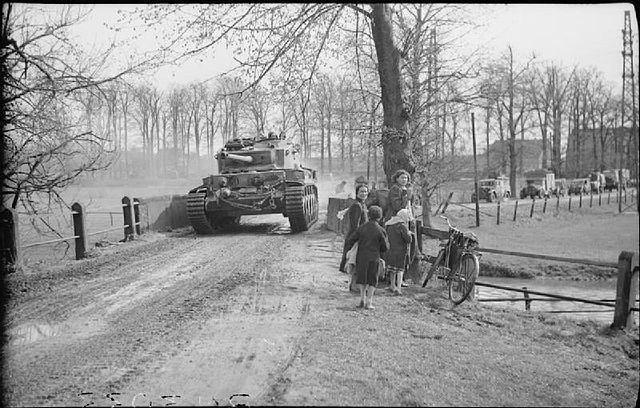 Photo: Humber scout car of 11th Armoured Division, during the advance to Osnabruck, 3 April 1945 Photo: Humber scout car of 11th Armoured Division, during the advance to Osnabruck, 3 April 1945 Photo: Infantry of 53rd (Welsh) Division in a Kangaroo personnel carrier on the outskirts of Ochtrup, 3 April 1945 Photo: Infantry of 53rd (Welsh) Division in a Kangaroo personnel carrier on the outskirts of Ochtrup, 3 April 1945 Photo: Troops of the 7th Cameronians use a small boat to cross a canal in the town of Rheine, 3 April 1945 Photo: Troops of the 7th Cameronians use a small boat to cross a canal in the town of Rheine, 3 April 1945 Western Front (1945) - Liberation of the Netherlands Western Front (1945) - Liberation of the NetherlandsAllied troops captured Hengelo, the Netherlands. Photo: British combat action in Hengelo, 3 April 1945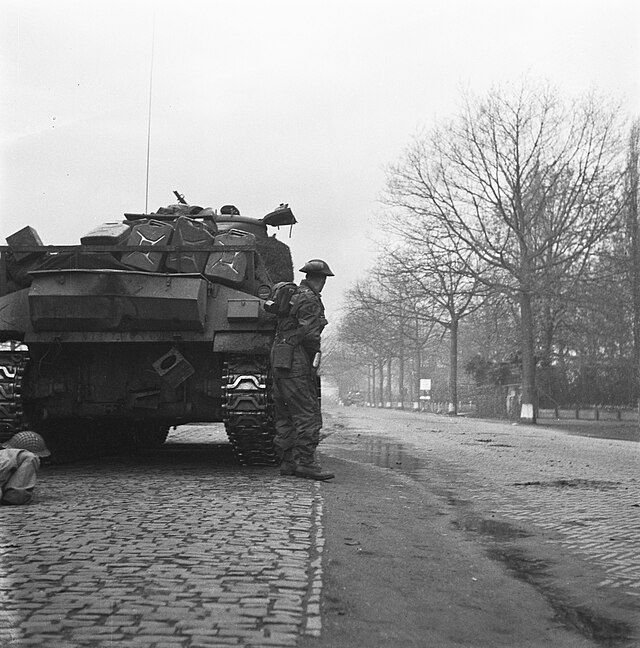 Photo: British armored vehicles (Guards Armored Division) on the way to Hengelo, April 3, 1945 Photo: British armored vehicles (Guards Armored Division) on the way to Hengelo, April 3, 1945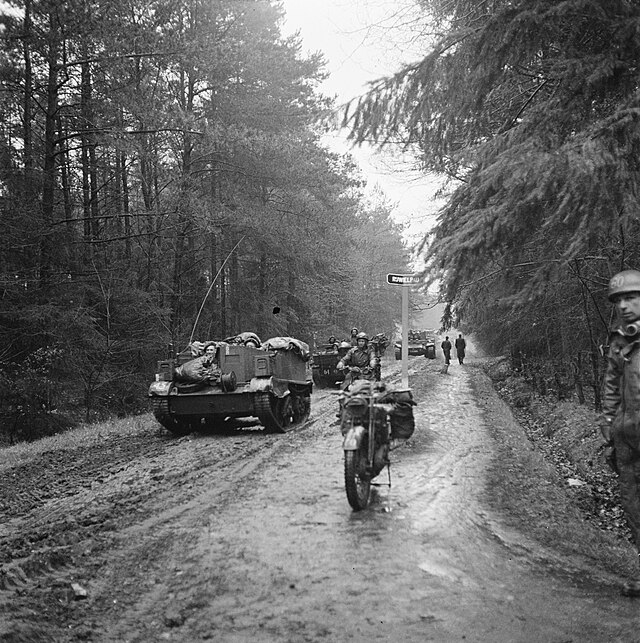 Air War over Europe Air War over Europe10th Tactical Reconnaissance Squadron, 69th Tactical Reconnaissance Group, from Nancy to Haguenau with F-6s (first mission is 17 Apr); 34th Photographic Reconnaissance Group, XII Tactical Air Command (attached to Provisional Reconnaissance Group), form Azelot to Haguenau with F-5s. HQ XXIX Tactical Air Command (Provisional) to Haltern; HQ 84th and 303d Fighter Wings from Munchen-Gladbach to Haltern; 14th Liaison Squadron, XIX Tactical Air Command (attached to Twelfth Army Group), from Oberstein to Berkersheim with L-5s; 15th Tactical Reconnaissance Squadron, 10th Photographic Group (Reconnaissance), from Trier to Ober Olm with F-6s; 507th and 508th Fighter Squadrons, 404th Fighter Group, from St Trond, Belgium to Keltz with P-47s. (US Eighth Air Force): 2 missions are flown. Mission 924: 752 B-17s and 569 P-51s are dispatched to hit U-boat yards at Kiel; they claim 1-0-0 Luftwaffe aircraft; 2 bombers and 4 fighters are lost: 1. 693 of 752 B-17s hit the Deutsche U-boat yard and 24 hit the Howardts U-boat yard; 2 B-17s hit Flensburg Airfield a target of opportunity; 2 B-17s are lost and 121 damaged; 1 airman is WIA and 20 MIA. Escorting are 517 of 569 P-51s; they claim 1-0-0 aircraft; 2 P-51s are lost and 2 damaged beyond repair. 2. 98 of 100 P-51s fly a sweep of the Kiel area; 1 is damaged beyond repair. 3. 4 P-51s escort 1 F-5 on a photo reconnaissance mission over Germany. 4. 17 of 18 P-51s fly a scouting mission; 2 P-51s are lost. Mission 925: 1 B-17 and 10 B-24s are dispatched to drop leaflets in the Netherlands, France and Germany during the night; 1 returns to base. (US Ninth Air Force): In Germany, about 230 B-26s, A-20s and A-26s attack Holzminden and Hameln marshalling yards, the town of Gottingen, 2 targets of opportunity, and fly a leaflet mission; fighters fly escort, fly patrols and armed reconnaissance, support the US 9th Armored Division in the Warburg area, the XX Corps E of the Werra River toward Muhlhausen and in the Kassel area, the XII Corps in the Gotha and Suhl areas, and the 2d and 8th Armored Divisions in the Teutoburger Forest and Neuhaus (US Fifteenth Air Force): 95 P-38s divebomb the Tainach- Stein railroad bridge in Austria; other P-38s and P-51s fly reconnaissance and escort missions; bad weather prevents bomber operations. HQ 325th Fighter Group and the 317th, 318th and 319th Fighter Squadrons move from Rimini to Mondolfo, Italy with P-51s. 247 RAF Lancasters and 8 Mosquitos of Nos 1 and 8 Groups to attack what were believed to be military barracks near Nordhausen. Unfortunately, the barracks housed a large number of concentration-camp prisoners and forced workers of many nationalities who worked in a complex of underground tunnels where various secret weapons were made. The camp and the tunnel workshops had been established immediately after Bomber Command attacked the rocket-research establishment at Peenemünde in August 1943. The bombing was accurate and many people in the camp were killed; the exact number is not known. The men working in the tunnels were unhurt. 2 Lancasters lost. 95 RAF Mosquitos to Berlin, 8 to Plauen and 5 to Magdeburg, 17 Mosquito patrols. 9 Lancasters sent to lay mines in the Kattegat were recalled because of weather conditions. 1 Mosquito lost from the Magdeburg raid. Italian campaign Troops of British Special Boat Service and Italian 28th Garribaldi Brigade captured islands in Lake Comacchio in northern Italy. (US Twelfth Air Force): In Italy during the night of 2/3 Apr A-20s bomb the marshalling yard at Mantua, several Po River crossings and other communications targets in the Po Valley; weather hampers operations during the day; medium bombers cancel most missions, but manage to bomb the Po Valley bridges at Camposanto, Usigliano, and Modena; the XXII Tactical Air Command [including Brazilian and South African Air Force (SAAF) units] blast communications, fuel dumps, methane plants, trains, motor transport at numerous points in N Italy (mainly in the Po Valley), including Parma, Modena, Fidenza, Lodi, Bergamo, Reggio Emilia, and Piacenza. The detachment of the 414th Night Fighter Squadron, XXII Tactical Air Command, operating from Florennes, Belgium with Beaufighters, moves to Strossfeld, Germany. Pacific War CHINA (Fourteenth Air Force): 17 B-25s bomb Pinglo, China railroad yards and in French Indochina, the Ninh Binh railroad yards, knock out a bridge at Thinh Duc, and damage bridges at Gian Khau and Mon Cay. In China, 60+ fighter-bombers knock out bridges at Hsitu and between Chuting and Hengyang, destroy pontoon bridges in the Kanchou area, hit Yangtong airfield, pound the Hai Duong, French Indochina railroad yards, and hit river traffic and other targets of opportunity at several locations including Hongay, and Cao Bang, French Indochina, and Tayu, Hankow, Kanchou, Yoyang, and the Ishan- Hwaiyuanchen, areas of China. INDIA-BURMA (Tenth Air Force): In Burma, bad weather again causes cancellation of most scheduled strikes; a few fighter-bombers hit a Japanese held wooded area near Kenglong; transports complete 383 sorties to forward areas. (Twentieth Air Force): 4 missions are flown during the night and early morning hours of 3/4 Apr. Mission 54: 9 B-29s mine the waters off Hiroshima without loss. Mission 55: In the early morning, 48 of 49 B-29s hit the aircraft plant at Shizuoka, Japan without loss. Mission 56: 43 of 78 B-29s attack the Koizumi aircraft factory and 18 hit the urban areas in Tokyo as a target of opportunity; they claim 1-0-0 Japanese aircraft. Mission 57: 61 of 115 B-29s strike the aircraft plant at Tachikawa and 49 hit the urban area of Kawasaki as a target of opportunity; 1 B-29 is lost. PHILIPPINE CAMPAIGN (1945) Part of the US 40th Division lands on Masbate to assist Filipino guerrillas who have controlled part of it for several days. Photo: USS LST-457 and USS LST-922 along with several other LSTs unloading at a pier that was built in one day by Army Engineers at Cebu City, P.I., 3 April 1945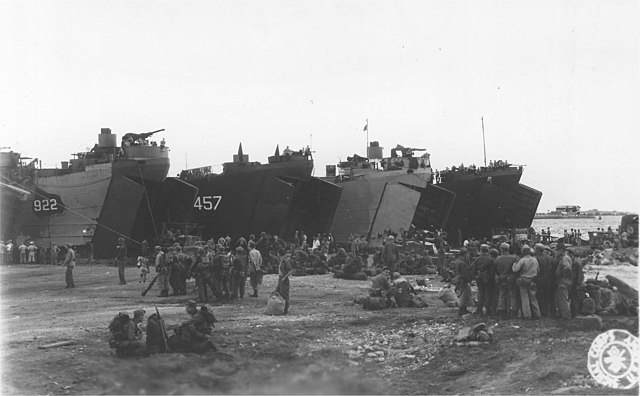 Photo: Members of the mortar squad of K Co., 3rd Bn., 15th Regt., Philippine Army, watching a mortar shell fall on the enemy lines, 3 April 1945 Photo: Members of the mortar squad of K Co., 3rd Bn., 15th Regt., Philippine Army, watching a mortar shell fall on the enemy lines, 3 April 1945 On Luzon Island fighter-bombers and A-20s hit the Balete Pass-Baguio-Naguilian area N of the Cagayan Valley supply targets, the Laguna deBay area, and Infanta, also, Miri Airfield, troops in the Cebu City area. Lost is B-25J 44-31504. Also, targets on Tarakan are bombed. VOLCANO AND RYUKYU ISLANDS CAMPAIGN On Okinawa, American artillery spotter planes begin operating from Kadena airfield. Photo: Men of an antitank company keep on the alert for enemy action atop a hill in Okinawa, 3 April 1945 Off Okinawa, escort carrier Wake Island (CVE-65) is damaged by near-miss of kamikaze, 26°05'N, 128°57'E, as is high speed minesweeper Hambleton (DMS-20), 27°00'N, 127°00'E; a kamikaze damages tank landing ship LST-599, 26°10'N, 127°16'E; tank landing ship LST-554 is damaged by storm, 26°20'N, 127°45'E. Photo: A flotilla of small rescue boats gathers around an LST to help combat fire caused by a suicide dive onto the deck by a Jap zero. Okinawa. 3 April, 1945 UNITED STATES NAVY DEPARTMENT COMMUNIQUES, CINCPOA COMMUNIQUÉ NO. 320, APRIL 3, 1945 The Marine Third Amphibious Corps and the Twenty‑Fourth Army Corps made rapid gains in all sectors of the lines on Okinawa Island on April 3 (East Longitude Date). In the north, the Marines advanced generally from 4,000 to 6,000 yards reaching the East Coast near Katchin Peninsula and cutting it off. Units of the Seventh Infantry Division which had reached the eastern shore of Okinawa the previous day moved southward along the shore of Katsurin Bay on the east coast from a point near the town of Takaesu to Kuba Town. Our front lines in the southern sector at nightfall of April 3, approximated a line from Kuba Town in the east to Chiyunna in the west. Resistance throughout the day was negligible. The advancing troops were supported by gunfire from heavy units of the Fleet. Ships' guns and carrier aircraft shot down 11 enemy planes during the day. Unloading of supplies continues satisfactorily. Fast carriers of the U. S. Pacific Fleet attacked targets in the Sakishima Group on April 3. On March 30‑31, Corsair and Hellcat fighters, Helldiver bombers, and Avenger torpedo planes from carriers of the U. S. Pacific Fleet supporting the Okinawa operation inflicted the following damage on enemy forces in the Ryukyus: Aircraft: Seventeen shot out of the air. Five destroyed on the ground. Nineteen damaged in the air and on the ground. Shipping: Sunk: Three motor torpedo boats. Two small cargo ships. Nine small craft. Probably Sunk: One small cargo ship. Four small craft. Damaged: One motor torpedo boat. Four small cargo ships. One lugger. Fourteen small craft. Installations: Six submarine pens at Unten Bay, Okinawa, destroyed and another heavily damaged. Mills, barracks, bridges, radio stations, pillboxes, buildings, docks, gun positions and covered revetments destroyed or damaged on Okinawa. Other installations on Tokuno, Amami, Kikai and Minami, Daito Islands, heavily hit. Installations on Marcus Island were bombed on April 2 by Army Liberators of the Strategic Air Force. Planes of the Fourth Marine Aircraft Wing attacked buildings, vehicles and barges in and around the Palau Islands on April 3. During the week ending March 31, 69 Japanese were killed and 13 taken prisoner by U. S. patrols on Saipan, Tinian and Guam in the Marianas. Navy Search Aircraft of Fleet Air Wing Two made neutralizing attacks on enemy‑held bases in the Marshalls on April 2. PACIFIC Nine USAAF B-29s mine the waters off Kure and Hiroshima, Japan. Motor minesweeper YMS-71 is sunk by mine off Sanga Sanga, 04°59'N, 119°47'E. TF 58 planes sink Japanese guardboat No.1 Taijin Maru and damage guardboat No.2 Hosei Maru southeast of Japan, 30°00'N, 137°30'E; and sink cargo ship Imari Maru off southwestern Kyushu, 33°45'N, 129°42'E. Coast Defense Vessel No.32 is damaged at 31°51'N, 124°47'E. USAAF B-24s (Far East Air Force) bomb Japanese shipping in Hong Kong harbor, sinking cargo vessels Heikai Maru and Shozan Maru, and damaging escort vessel Manju, 22°17'N, 114°10'E. USN land-based planes sink Japanese tanker No.30 Nanshin Maru (the only surviving ship of the ill-starred convoy HI-88-I) (see 20-21 March) in Nha Trang Bay, French Indochina, 12°15'N, 109°10'E.
|
|
lordroel
Administrator
Member is Online
Posts: 68,014 
Likes: 49,411
|
Post by lordroel on Apr 4, 2024 2:51:37 GMT
Day 2033 of World War II, April 4th 1945Eastern FrontThe Russian 2nd and 3rd Ukrainian Fronts complete the liberation of Hungary. Troops of the 2nd Ukrainian front capture Bratislava. The Germans forces counterattack in Moravska-Ostrava and Nitra. At Kosice in the Slovak Republic, the Soviet Union set up a provisional Czechoslovakian government. Western Front (1945) - Western Allied invasion of GermanyMap: HQ Twelfth Army Group situation map, April 4th 1945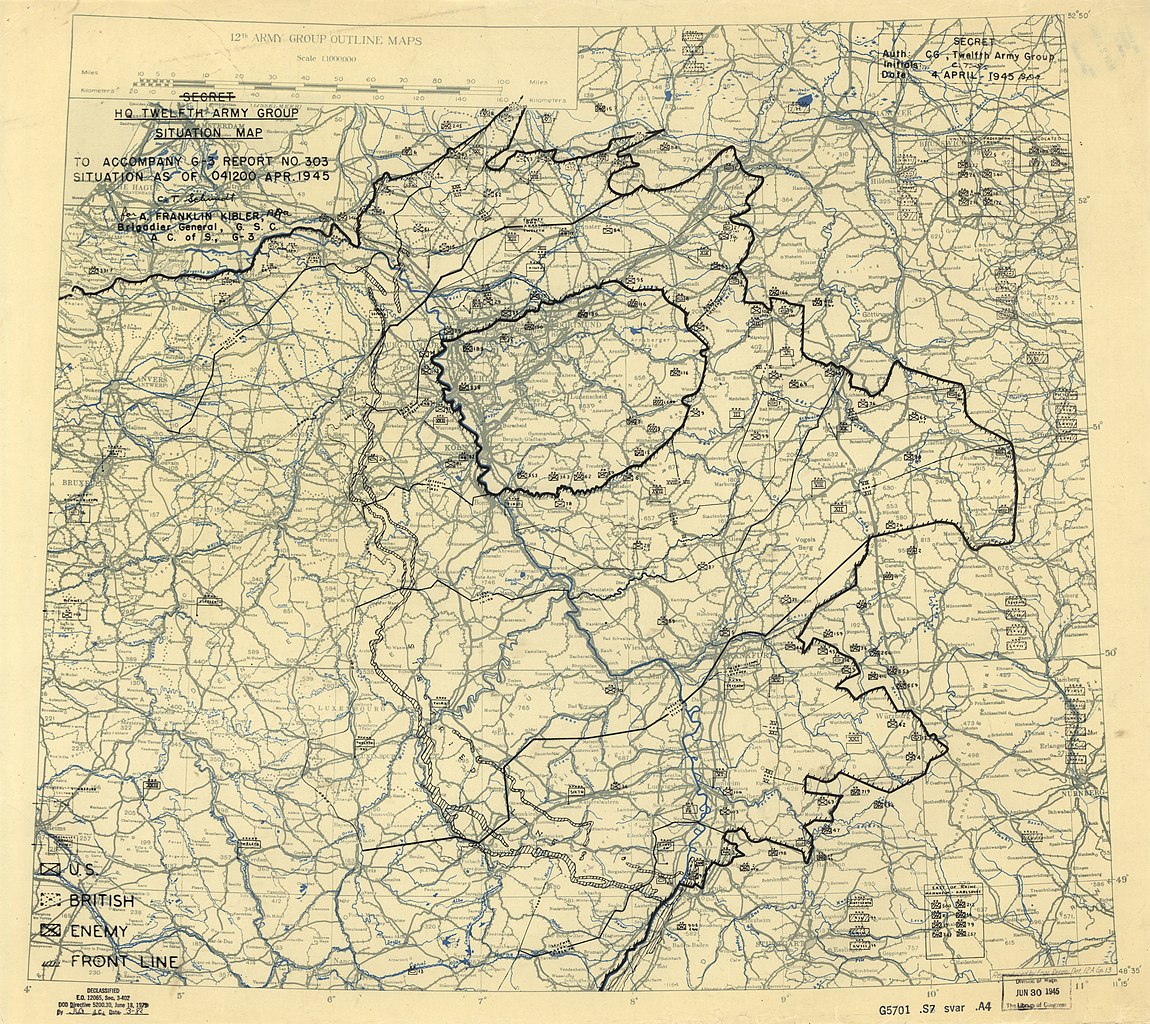 British and Canadian units take Osnabruck. The US 9th Army reaches the River Weser at Hameln. The US 3rd Army captures Kassel. The army also frees the slave labour camp at Ohrduf near Gotha when elements of the 4th Armored and 89th Inf. Divisions enter the slave-labour camp which is an "aussenlager" or subsidiary camp of KZ Buchenwald, near Weimar. It is the first camp to be overrun on German territory by the Western Allies. The notorious KZ Natzweiler-Struthof in Alsace had been overrun by US forces in Nov.1944, but was previously evacuated by the SS. French Units take Karlsruhe. Gotha falls to US forces as US aircraft smash the naval bases at Kiel and Hamburg. The Nazi gold reserves are captured in the salt mine at Merkers. General Dwight Eisenhower transferred the US 9th Army from Field Marshal Bernard Montgomery's 21st Army Group to General Omar Bradley's 12th Army Group, thus making Bradley the first American general to command four field armies simultaneously. Photo: 1st Special Service Brigade, 4 April 1945 Photo: Armor and infantry of the 6th Armored Division, 3rd U.S. Army, advance to take town of Oberdorla, Germany. 4 April, 1945 Photo: Armor and infantry of the 6th Armored Division, 3rd U.S. Army, advance to take town of Oberdorla, Germany. 4 April, 1945 Photo: Tanks and infantry of the 6th Armored Division, 3rd U.S. Army, advance cautiously to take the town of Oberdorla, Germany. 4 April, 1945 Photo: Tanks and infantry of the 6th Armored Division, 3rd U.S. Army, advance cautiously to take the town of Oberdorla, Germany. 4 April, 1945 Photo: Infantry troops of Combat Command "A", 6th Armored Division, Third U.S. Army, move cautiously through the outskirts of Muhlhausen, Germany. 4 April, 1945 Photo: Infantry troops of Combat Command "A", 6th Armored Division, Third U.S. Army, move cautiously through the outskirts of Muhlhausen, Germany. 4 April, 1945 Photo: A Sherman tank of the Royal Scots Greys, 7th Armoured Division, crossing the Dortmund-Ems Canal, 4 April 1945 Photo: A Sherman tank of the Royal Scots Greys, 7th Armoured Division, crossing the Dortmund-Ems Canal, 4 April 1945 Photo: A Universal carrier of the 6th Cameronians, 52nd (Lowland) Division, crossing the Dortmund-Ems Canal, 4 April 1945 Photo: A Universal carrier of the 6th Cameronians, 52nd (Lowland) Division, crossing the Dortmund-Ems Canal, 4 April 1945 Photo: A Churchill tank crew and US Airborne troops in Munster, 4 April 1945 Photo: A Churchill tank crew and US Airborne troops in Munster, 4 April 1945 Air War over Europe Air War over EuropeThe 405th Fighter Squadron, 371st Fighter Group, moves from Metz, France to Eschborn Airfield, Frankfurt, Germany with P-47s. Ninth Air Force: HQ XXIX Tactical Air Command (Provisional) returns to the operational control of HQ Ninth AF (from the RAF Second Tactical AF) as the US Ninth Army reverts to control of the Twelfth Army Group (from the Twenty First Army Group); the British ground and air HQ have operationally controlled the XXIX Tactical Air Command and Ninth Army since shortly after the Ardennes breakthrough and the Battle of the Bulge. 107th Tactical Reconnaissance Squadron, 67th Tactical Reconnaissance Group, from Vogelsang to Limburg, Germany with F-6s; the 125th Liaison Squadron, IX Fighter Command (attached to Twelfth Army Group), from Munchen-Gladen to Haltern, Germany with L-5s; the 155th Photographic Reconnaissance Squadron, 67th Tactical Reconnaissance Group, from Le Culot, Belgium to Maastricht, the Netherlands with F-3s; the 355th Fighter Squadron, 354th Fighter Group, from Rosieres-en-Haye, France to Ober Olm, Germany with P-51s; and the 494th, 495th and 496th Bombardment Squadrons (Medium), 344th Bombardment Group (Medium), from Cormeilles-en-Vexin, France to Juzaine Airfield, Florennes, Belgium with B-26s. (US Eighth Air Force): 2 missions are flown. Mission 926: 1,431 bombers and 866 fighters are dispatched to hit airfields, a shipyard and a U-boat shipyard in Germany; they claim 30-4-30 Luftwaffe aircraft; 10 bombers and 4 fighters are lost. 1. 438 B-24s are sent to hit Parchim (33) and Perleberg (29) Airfields; 97 hit Wesendorf Airfield, the secondary; attacks are visual; they claim 6-4-6 aircraft; 6 B-24s are lost, 1 damaged beyond repair and 76 damaged; 1 airman is KIA and 59 MIA. Escorting are 324 P-47s and P-51s; the P-47s claim 14-0-20 aircraft and the P-51s claim 9-0-3 aircraft; 1 P-47 and 3 P-51s are lost. 2. 443 B-17s are sent to hit Fassberg Airfield (149); secondary targets hit are Hoya (37) and Dedelsdorf (13) Airfields; targets of opportunity are Unterluss (39) and other (24); bombing is visual; 1 B-17 is lost, 2 damaged beyond repair and 58 damaged; 1 airman is KIA, 6 WIA and 4 MIA. The escort is 220 of 232 P-51s; 1 is lost. 3. 505 of 526 B-17s hit the Deutsche shipyard at Kiel using H2X radar; 2 others hit Eggebeck Airfield, a target of opportunity; 3 B-17s are lost and 50 damaged; 27 airmen are MIA. 208 of 223 P-51s without loss. 4. 22 of 24 B-17s fly a DISNEY mission attacking the Finkenwarder U-boat yard at Hamburg without loss. 5. 19 P-51s fly a scouting mission and claim 0-0-1 aircraft. 6. 25 P-51s escort 8 F-5s and 2 P-38s on photo and radar reconnaissance missions over Germany, claiming 1-0-0 aircraft. 7. 16 P-51s escort 1 OA-10 and 2 B-17s on air-sea-rescue patrols. (US Ninth Air Force): In Germany, 330+ B-26s, A-20s and A-26s hit the Ebrach oil depot, Crailsheim marshalling yard and barracks area, Grossaspach supply depot, the town of Ellswangen, Backnang rail and road junction, and 2 targets of opportunity; fighters escort the bombers, fly patrols, sweeps, and armed reconnaissance, attack special targets, and support the US 104th Infantry Division at Scherfede and Hardehausen, the 9th Armored Division in the Warburg area, the XX Corps in the Muhlhausen-Kassel areas, the 2d and 5th Armored Divisions in the Hameln and Minden areas on the Weser River, and the 8th Armored Division as it assaults the Ruhr pocket in the Lippstadt area. (US Fifteenth Air Force): Again bad weather prevents bomber operations and limits efforts to reconnaissance and escort missions and to strafing attacks by 94 P-51s on rail traffic in the Munich and Regensburg, Germany; Plzen, Czechoslovakia; and Linz, and Gmunden, Austria areas. 243 RAF Lancasters and 1 Mosquito of No 5 Group, with 8 Pathfinder Mosquitos, attacked the barracks and the town of Nordhausen, which was severely damaged. 1 Lancaster lost. 327 RAF Lancasters and 14 Mosquitos of Nos 3, 6 and 8 Groups attacked the synthetic-oil plant at Leuna. The target was cloud-covered, the bombing was scattered and only minor damage was caused. 2 Lancasters lost. 327 RAF aircraft - 277 Halifaxes, 36 Lancasters, 14 Mosquitos - of Nos 4, 6 and 8 Groups attacked the Rhenania oil plant, Harburg. The target was easily identified and severe damage was caused to it. 2 Lancasters and 1 Halifax lost. 258 RAF Lancasters and 14 Mosquitos of Nos 1 and 8 Groups attacked the oil refinery at Lützkendorf. Bomber Command claimed 'moderate damage'. 6 Lancasters lost. 35 RAF Mosquitos to Berlin and 31 to Magdeburg, 70 RCM sorties, 66 Mosquito patrols, 30 Lancasters minelaying in the Oslo Fjord and the Kattegat. 5 aircraft lost. 12 Mosquitos from the Magdeburg raid and 3 Lancasters of No 1 Group from the Kattegat minelaying operation. The 136 aircraft dispatched by No 100 Group on this night were that group's largest effort of the war. Italian campaign (US Twelfth Air Force): In Italy, B-25s continue to blast communications along the Brenner rail line, ranging from the railroad bridge at Drauburg to the Camposanto railroad bridge; the B-25s also inflict considerable damage on the Merano methanol plant; P-47s concentrate on enemy movement, rail lines, and ammunition and fuel dumps throughout the Po Valley. The 489th Bombardment Squadron (Medium), 340th Bombardment Group (Medium), moves from Alesan, Corsica to Rimini, Italy with B-25s. HQ 90th Photographic Wing (Reconnaissance) begins a movement from San Severo, Italy to the US. Pacific WarCHINA (Fourteenth Air Force): In French Indochina, 2 B-25s sink a junk in the Gulf of Tonkin and 6 P-38s strafe trucks around Dien Bien Phu, Moc Chau, and Son La. INDIA-BURMA (Tenth Air Force): Combat operations are restricted to attacks on a troop concentration and rice and fuel supplies behind enemy lines in C Burma; transports operate on steady basis throughout the day. BURMA Photo: A Grant tank crew of 146th Regiment, Royal Armoured Corps repair one of the tracks of their vehicle on the outskirts of Taungup, 4 April 1945 PALAU (Seventh Air Force): 24 B-24s from Angaur Airfield Island hit a building at Bunawan, Mindanao. TINIAN (Twentieth Air Force): HQ 40th and 462d Bombardment Groups (Very Heavy) arrive at West Field, Tinian Island from India. SOUTHWEST PACIFIC AREA [Far East Air Force]: On Formosa, B-24s bomb Toyohara Airfield, Mako harbor, and Tokichito Island and A-20s hit Shinchiku factories and rail yards. PHILIPPINE CAMPAIGN (1945) B-24s bomb the harbor at Hong Kong. P-38s and P-51s pound various targets in C Luzon Island while A-20s and P-38s hit the Calauag area. A-20s pound NW Negros Island and B-24s bomb targets on C Mindanao. The 17th Reconnaissance Squadron (Bombardment), 71st Tactical Reconnaissance Group, moves from San Jose, Mindoro Island to Lingayen Airfield with B-25s. Photo: Pfc. Thomas Powell, North Flatte, Nebr., 5th Cav., guards the main street of San Pablo, Luzon, P.I, with his machine gun, and covers himself completely with his poncho in the tropical rain, 4 April 1945 VOLCANO AND RYUKYU ISLANDS CAMPAIGN On Okinawa, the forces of US 10th Army begin to meet the first real Japanese resistance on the ground. Troops of US 24th Corps are brought to a halt on a line just south of Kuba while the forces of 3rd Amphibious Corps have reached the Ishikawa Isthmus. A storm damages many landing craft and hampers further reinforcement. Photo: The beaches appear to be centers of activity, piled high with men and equipment. Landing ships, Tank are pulled up to the coral reef, discharging their cargo into smaller craft to be taken ashore. 4 April 1945 Photo: Heavy machine guns of 96th Division fire on Jap positions on the southern front of Okinawa, 4 April 1945 Photo: Heavy machine guns of 96th Division fire on Jap positions on the southern front of Okinawa, 4 April 1945  Off Okinawa, high speed transport Dickerson (APD-21), irreparably damaged by kamikaze on 2 April 1945, is towed out to sea and scuttled by salvage crew off Kerama Retto; infantry landing craft LCI-82 is sunk by assault demolition boat; destroyer Norman Scott (DD-690) is damaged in collision with oiler Cimarron (AO-22), 23°46'N, 129°25'E; kamikaze damages destroyer Wilson (DD-408) off southern end of Kerama Retto; destroyer Sproston (DD-577) is damaged by near-miss by bomb, 26°30'N, 127°30'E. Oiler Cowanesque (AO-79) is damaged in storm; medium landing ship LSM-12 founders in heavy weather. Groundings account for damage to tank landing ships LST-70, LST-624, LST-675, and LST-756, 26°21'N, 127°45'E; LST-166, LST-689, and LST-736, 26°20'N, 127°45'E; LST-343, 26°00'N, 128°00'E; LST-570, 26°21'N, 127°44'E, and LST-781, 26°23'N, 127°44'E. Tank landing ship LST-399 is damaged in collision with salvage vessel Gear (ARS-34), 26°20'N, 127°45'E. UNITED STATES NAVY DEPARTMENT COMMUNIQUES, CINCPOA COMMUNIQUÉ NO. 321, APRIL 4, 1945 The East Coast of Okinawa Island from Yaka in the north to Kuba Town in the south was brought under the control of the Tenth Army on April 4 (East Longitude Date). Elements of the Marine Third Amphibious Corps pushing north and east simultaneously established their front line on the Isthmus of Okinawa about 3,000 to 4,000 yards north of Ishikawa and captured all sections of the east coast in their zone of action. In the south, the Twenty‑Fourth Army Corps advanced steadily and at nightfall were holding a line between Uchi Tomari on the West Coast, Kamiyama in the center of the island, and a point just north of Nakagusuku on the east coast. The enemy offered scattered resistance to the advances of our troops. Concentrations of troops and vehicles fn the southern part of the island were brought under fire by the guns of surface units of the fleet and by carrier aircraft supporting the attack. The unloading of supplies for the Expeditionary Forces ashore continues satisfactorily. The enemy made several small air attacks against our surface forces early in the morning of April 4. Four of his aircraft were shot down. Aircraft from a carrier task group commanded by Rear Admiral Frederick C. Sherman, U. S. Navy, attacked aircraft, airfields, and other installations in the Amami Group on April 3. The following damage was inflicted on the enemy: Forty‑five aircraft shot out of the air. Two aircraft destroyed on the ground. Nine aircraft damaged on the ground. Twenty‑five small craft damaged or destroyed. Two small cargo ships damaged. One motor torpedo boat damaged. Fuel dumps and buildings set afire. Corsair and Hellcat fighters of the Fourth Marine Aircraft Wing bombed warehouse and supply areas in the Palaus on April 4. On the same date, Marine fighters struck piers at Yap in the western Carolines. On April 3, Fourth Marine Aircraft Wing planes continued neutralizing attacks on enemy‑held bases in the Marshalls. PACIFIC Japanese escort vessel Mokuto is sunk by USAAF mine laid by B-29 (20th Bomber Command) in Shimonoseki Strait, 33°53'N, 131°03'E. Japanese merchant cargo ship Hozan Maru is sunk by mine, 33°45'N, 131°44'E. Submarines RO 64, 34°14'N, 132°16'E, and RO 67, 34°00'N, 133°00'E, are damaged by USAAF B-29-sown mines in the Inland Sea.[10] Japanese guardboat No.12 Kotoshiro Maru is sunk by U.S. aircraft off Torishima, 30°00'N, 140°00'E. USAAF B-24s (Far East Air Force) bomb Japanese shipping at Mako, Pescadores, sinking merchant tanker No.2 Kinyu Maru and cargo vessel Horei Maru, 23°32'N, 119°34'E. Japanese ship No.1 Manyu Maru is sunk by aircraft off Tajin Island. Japanese hospital ship Arimasan Maru is damaged by mine, while en route to Singapore. British submarine HMS Spark attacks Japanese light cruiser Isuzu without success, in the Flores Sea.
|
|
lordroel
Administrator
Member is Online
Posts: 68,014 
Likes: 49,411
|
Post by lordroel on Apr 5, 2024 8:04:26 GMT
Day 2034 of World War II, April 5th 1945Eastern Front Soviet 3rd Ukrainian Front cut the rail line from Linz to Vienna, occupied Austria. On the fifth day of the Soviet artillery bombardmen on Königsberg, East Prussia, Germany, a break in the weather allowed Soviet aircraft to join in on the attack. By this point, German defenses could offer little opposition to enemy aircraft. Western Front (1945) - Western Allied invasion of GermanyMap: HQ Twelfth Army Group situation map, April 5th 1945 In the West, the French First Army (de Tassigny) captures Karlsruhe on the upper Rine. The US 304th Infantry Regiment reaches the Wehre River and takes the bridge at Niederhone. Allied forces cross the Weser River at several points. Western Front (1945) - Liberation of the Netherlands4th Canadian Armoured Division captures Almelo in north-east Holland. Photo: Personnel of the [13th or 19th] Field Regiment, Royal Canadian Artillery (R.C.A.), examining a damaged German V-1 flying bomb launching ramp, Almelo, Netherlands, 5 April 1945. (L-R): Gunners L.J. Armitage and J. Raffle, Lance-Corporal Don Stover, Signalman R.N. Clarke Air War over Europe Air War over Europe HQ 27th Fighter Group and 522d and 524th Fighter Squadrons from Ochey, France to Biblis, Germany with P-47s; 406th Fighter Squadron, 371st Fighter Group from Metz, France to Eschborn Airfield, Frankfurt, Germany with P-47s; 417th Night Fighter Squadron, 64th Fighter Wing [attached to First Tactical AF (Provisional)] from La Vallon to St Dizier, France with Beaufighters. HQ 10th Photographic Group (Reconnaissance) and the 31st Photographic Reconnaissance Squadron from Evren Airfield, Trier to Ober Olm, Germany with F-5s; HQ 344th Bombardment Group (Medium) and the 497th Bombardment Squadron (Medium) from Cormeilles-en-Vexin, France to Juzaine Airfield, Florennes, Belgium with B-26s; the 153d Liaison Squadron, IX Tactical Air Command (attached to Twelfth Army Group) from Bad Godesberg to Marburg, Germany with L-5s; the 167th Liaison Squadron, Ninth AF (attached to Sixth Army Group) from Vittel, France to Kaiserslautern, Germany with L-5s; the 450th Bombardment Squadron (Medium), 322d Bombardment Group (Medium), from Tille Airfield, Beauvais, France to Le Culot, Belgium with B-26s. (US Eighth Air Force): 2 missions are flown. Mission 928: 1,358 bombers and 662 fighters attack marshalling yards, ordnance depots, armament works and airfields in Germany; they claim 8-0-6 aircraft; 10 bombers and 1 P-51 are lost: 1. 436 B-17s are dispatched to hit munitions dumps at Ingolstadt (211) and Grafenwohr (94), and the marshalling yard at Bayreuth (73); targets of opportunity are Weiden (30) and Nurnberg (1); the attacks are made visually; 1 B-17 is lost, 2 damaged beyond repair and 2 damaged; 11 airmen are KIA and 2 WIA. Escorting are 182 of 201 P-51s; they claim 0-0-1 aircraft in the air and 7-0-3 on the ground. 2. 397 B-24s are sent to hit the marshalling yard at Plauen (151) and the munitions dump at Bayreuth (39); targets of opportunity are the munitions dump at Grafenwohr (1) and munitions plant at Ingolstadt (1); bombing is with H2X radar; 5 B-24s are lost and 5 damaged; 1 airman is WIA and 44 MIA. 280 P-47s and P-51s escort; they claim 1-0-2 aircraft in the air; 1 P-51 is lost (pilot MIA). 3. 521 B-17s are sent to hit the Unterschlauersbach Airfield (59), an aircraft parts factory (13) and munitions depot (54) at Furth, and the Nurnberg S marshalling yard (37); 271 bombers hit the Nurnberg Station marshalling yard, the secondary; bombing is visual; 4 B-17s are lost, 2 damaged beyond repair and 112 damaged; 8 airmen are KIA, 7 WIA and 39 MIA. The escort is 91 of 104 P-51s. 4. 4 B-17s fly scouting missions. 5. 18 P-51s escort 5 F-5s on photo reconnaissance missions over Germany. 6. 35 P-51s fly a scouting mission. Mission 929: 12 B-24s drop leaflets in France, the Netherlands and Germany during the night. (US Ninth Air Force): Weather prevents operations by the 9th Bombardment Division. In Germany, fighters fly patrols, sweeps, and armed reconnaissance, and support the US 7th Armored Division's attack on the Ruhr pocket SW of Brilon, the XX Corps' drive E in the Muhlhausen area, the XII Corps' advance in the Meiningen area, the 2d Armored Division bridgehead astride the Weser River S of Hameln, the 8th Armored Division (preparing for an assault on Soest), and the 5th Armored Division near Minden. (US Fifteenth Air Force): 457 B-24s and B-17s attack a railroad bridge at Dravograd, Yugoslavia, marshalling yards and locomotive depots at Brescia, Alessandria, and Turin, Italy, and the airfield at Udine, Italy; 96 P-38s dive-bomb the Radovljica, Yugoslavia railroad bridge, 27 P-51s with 13 flying top cover, strafe rail communications in the Munich, Regensburg, and Passau, Germany, and Linz, Austria areas; 20+ P-38s fly reconnaissance missions; around 300 fighter sorties are flown to escort transport, reconnaissance, and bomber missions (including an RAF raid on the Monfalconei, Italy shipyards). Italian campaignOn the west coast, American units from US 5th Army begin to attack north near Massa, south of La Spezia. (US Twelfth Air Force): B-25s bomb 5 bridges in N Italy and Austria, at Steinach, Austria, and Matrei am Brenner, Modena, Salorno, and San Michele all'Adige, and blast gun positions at La Spezia, Italy; these attacks follow night raids by A-20s and A-26s on bridges at Lavis, Ala, San Michele all'Adige, San Ambrogio di Valpolicella, Piazzola sul Brenta, Cittadella, and Montebello, Italy and other targets; fighters and fighter bombers devote their largest effort to close support of ground forces, blasting occupied areas and gun positions in the Massa Lombarda area, and also attack communications and dumps in the Po Valley. Battle of the AtlanticU.S. tanker Atlantic States is torpedoed by German submarine U-857 off Cape Cod, 42°07'N, 70°00'42"W; there are no casualties to either the merchant crew or the 12-man Armed Guard. Auxiliary Guinevere (IX-67) rescues the crew (with the exception of five men, including the Armed Guard officer, who remain on board to keep the ship trimmed) while destroyer escort Richard S. Bull (DE-402) stands by to render assistance. Later, old tug Wandank (ATO-26), assisted by rescue tugs ATR-14 and ATR-89, tow the damaged ship to Boston where she is repaired. GermanyThe Schwarze Korps, Himmler's respected Nazi publication, has conceded that Germany is on the verge of "absolute collapse". In an unprecedented admission, the magazine today says that the German people are "being forced to acknowledge that it may be possible to defeat us militarily". The piece goes on to say, however, that they will never stop fighting and that "our belief in the rightness of our cause hasn't changed by a single letter." Ferdinand Schörner is promoted to Field Marshal. Soviet Union Molotov, the Soviet Commissar for Foreign Affairs, tells the Japanese ambassador that the the Soviet Union does not intend to renew the 1941 non-aggression pact: Soviet Denunciation of the Pact with Japan The American Ambassador at Moscow transmitted to the Secretary of State, by a telegram dated April 5, 1945, the following statement, as received from the press section of the Foreign Office, regarding Soviet denunciation of the U.S.S.R.-Japanese neutrality pact: " Today at 3 p.m. People's Commissar for Foreign Affairs of the USSR Mr. V. M. Molotov, received the Japanese Ambassador, Mr. N. Sato, and made the following statement to him in the name of the Soviet Government: 'The neutrality pact between the Soviet Union and Japan was concluded on April 13, 1941, that is, before the attack of Germany on the USSR and before the outbreak of war between Japan on the one hand and England and the United States on the other. Since that time the situation has been basically altered. Germany has attacked the USSR, and Japan, ally of Germany, is aiding the latter in its war against the USSR. Furthermore Japan is waging a war with the USA and England, which are allies of the Soviet Union. In these circumstances the neutrality pact between Japan and the USSR has lost its sense, and the prolongation of that pact has become impossible. On the strength of the above and in accordance with Article Three of the above mentioned pact, which envisaged the right of denunciation one year before the lapse of the five-year period of operation of the pact, the Soviet Government hereby makes know [sic] to the Government of Japan its wish to denounce the pact of April 13, 1941.' The Japanese Ambassador Mr. N. Sato, promised to inform the Japanese Government of the statement of the Soviet Government." German occupied NorwayPhoto: A Mosquito of the Banff Strike Wing in action in the Kattegat on 5 April 1945. There the Mosquitos discovered a convoy of seven ships evacuating Germans troops back to the Fatherland. In the ensuing attack a flak ship and a trawler were sunk, but one No 235 Squadron Mosquito struck a mast and spun into the sea, killing its crew. Losses among the embarked German troops were heavy Yugoslav/Soviet relations Yugoslav/Soviet relationsPartisan leader Josip Broz, Alias "Tito" signs a "friendship treaty" with the Soviet Union. The agreement permits "temporary entry of Soviet troops into Yugoslav territory." As part of the agreement Tito secure a proviso that the Soviets would leave Yugoslavia once its "Operational task" was completed. United StatesIt is announced that General MacArthur will take control of all army forces in the Pacific theater of operations and Admiral Nimitz will command all naval forces in preparation for the invasion of Japan. Photo: The U.S. Navy destroyer escort USS LeHardy (DE-20) underway in Puget Sound, Washington (USA), on 5 April 1945 Photo: The U.S. Navy destroyer escort USS Charles R. Greer (DE-23) underway in Puget Sound, Washington (USA), on 5 April 1945. She is painted in Camouflage Measure 22 Photo: The U.S. Navy destroyer escort USS Charles R. Greer (DE-23) underway in Puget Sound, Washington (USA), on 5 April 1945. She is painted in Camouflage Measure 22 Pacific War Pacific WarCHINA (Fourteenth Air Force): 27 fighter-bombers on armed reconnaissance attack troops, horses, and river, road, and rail traffic at Son La, French Indochina and Shanhsien and Shihkiachwang, and in the Tehsien and Loyang-Pinglo area of China. INDIA-BURMA (Tenth Air Force): In Burma, bad weather cancels scheduled strikes; transports continue large-scale operations to forward areas. The 166th Liaison Squadron (Commando), 1st Air Commando Group, moves from Ondaw to Meiktila, Burma with UC-64s and L-5s. BURMA Photo: Men of the 17th Division inspect a Japanese Mk 9 75mm anti-tank gun captured at Kandaugn, 5 April 1945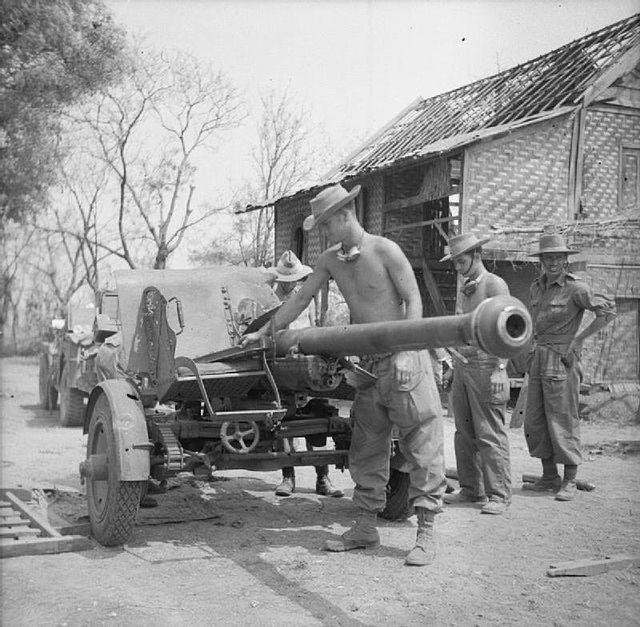 Photo: A soldier of the 17th Division inspects a Japanese armoured recovery vehicle "Ri-Ki" M1935 (Type 95) captured at Meiktila, 5 April 1945 Photo: A soldier of the 17th Division inspects a Japanese armoured recovery vehicle "Ri-Ki" M1935 (Type 95) captured at Meiktila, 5 April 1945 GUAM (Seventh Air Force): 18 B-24s from Guam hit targets on Eten and Dublon at Truk Atoll, Caroline Islands. 22 B-24s from Angaur Airfield pound a bivouac area at Bunawan, Mindanao. (Twentieth Air Force): HQ 315th Bombardment Wing (Very Heavy) arrives at Northwest Field from the US. PHILIPPINE CAMPAIGN (1945) On Luzon, south and west of Manila, the US forces on either side of Laguna de Bay are beginning to make significant gains in their attacks. In Manila Bay, on Caballo Island, American troops pour thousands of gallons of a diesel/gasoline mixture into Fort Hughes and set it on fire but fail to entirely eliminate Japanese resistance. Photo: The pack is all on the pack trains which consist of both Philippines & GI who carry ammo & water and rations to the front over a road that is impassable by vehicles, 5 April 1945 180+ sorties in support of ground forces are flown on Luzon. A-20s and patrolling P-61s support troops on Cebu and Negros. P-38s hit Tarakan and Tawau, Borneo. HQ 58th Fighter Group moves from San Jose Airfield to Mangaldan. VOLCANO AND RYUKYU ISLANDS CAMPAIGN Off Okinawa, battleship Nevada (BB-36) is damaged by shore battery, 26°13'N, 127°40'E; a dud aerial torpedo damages light minelayer Harry F. Bauer (DM-26), 26°30'N, 127°30'E. Collisions account for damage to seaplane tender (destroyer) Thornton (AVD-11) and oiler Escalante (AO-70), 24°24'N, 128°58'E; landing craft repair ship Agenor (ARL-3) and tank landing ship LST-646, 24°46'N, 141°19'E; tank landing ships LST-273 and LST-810, 26°25'N, 127°42'E; tank landing ship LST-923 (with tank landing ship LST-20); tank landing ship LST-940 [with attack cargo ship Diphda (AKA-59)], 26°21'N, 127°43'E; and tank landing ship LST-1000 (with tank landing ship LST-20), 26°21'N, 127°44'E; tank landing ship LST-698 is damaged by grounding, 26°24'N, 127°45'E. U.S. shore battery sinks Japanese auxiliary minelayer No.2 Shinto Maru and damages auxiliary minelayer Taian Maru in Naha Harbor, Okinawa, 26°30'N, 128°00'E. Destroyer Hudson (DD-475) sinks Japanese submarine RO 41 west of Okinawa, near Kerama Retto, 26°22'N, 126°30'E. Map: Battle of Okinawa 1945 April 1-5 JAPAN General Koiso and his cabinet resign. Admiral Suzuki forms the new government. Togo is Foreign Minister and Hiranuma, President of the Privy Council. There is less military influence in this Cabinet than in Koiso's and all its members are agreed that no reasonable offer of peace should be turned down. Some even go as far as to think that any offer should be accepted if this is the only way that invasion can be avoided. UNITED STATES NAVY DEPARTMENT COMMUNIQUES, N. D. COMMUNIQUÉ NO. 591, APRIL 5, 1945 Pacific Area. 1. The LCI (G) 474 was lost in the Iwo Jima area as the result of enemy action. 2. The next of kin of casualties have been informed. UNITED STATES NAVY DEPARTMENT COMMUNIQUES, CINCPOA COMMUNIQUÉ NO. 322, APRIL 5, 1945 Our troops in both the northern and southern sectors of Okinawa continued to advance on April 5. By 1800 on that date, Marines of the Third Amphibious Corps had moved forward generally 8,000 to 9,000 yards on Ishikawa Isthmus, the southern end of their line being in the neighborhood of Kin Town. Japanese opposition in the north continued to be ineffective. Army troops in the south made advances up to about 3,000 yards. In this sector, elements of the Twenty Fourth Army Corps moved into areas organized for defense by the enemy and at nightfall resistance to the advance was increasing. Our advancing troops were supported throughout the day by gunfire from units of the U. S. Pacific Fleet and by carrier aircraft. During the period of April 1 to 1800 on April 5, 65 enemy aircraft have been destroyed over our forces attacking Okinawa. During the Okinawa operation as of midnight April 4‑5, 175 soldiers and Marines had been killed in action. Figures as to Naval personnel are not available. Seven hundred and ninety eight soldiers and Marines had been wounded in action during the same period. Organization for military government in the area of Okinawa under our control has been established and is functioning satisfactorily. About 9,000 civilians have surrendered to our forces. Considerable stocks of enemy foodstuffs have been captured and are available for civilian use. On April 5, Hellcat and Corsair fighters and Avenger torpedo planes of the Fourth Marine Aircraft Wing attacked targets in the Palaus. A warehouse was destroyed and barges and vehicles were damaged. PACIFIC Naval Advanced Air Base, Iwo Jima, is established. Submarine Besugo (SS-321) twice attacks Japanese light cruiser Isuzu in the Flores Sea. Boarding party from submarine Bluegill (SS-242) completes destruction of beached and abandoned fleet tanker Honan Maru with demolition charges and incendiaries, near Nha Trang, French Indochina. Submarine Hardhead (SS-365) attacks unescorted Japanese convoy SASI-45, damaging cargo ship Araosan Maru in the Gulf of Siam, 09°37'N, 102°48'E. PBMs attack Japanese convoy, sinking merchant cargo ship No.2 Tokai Maru in Pinghai Wan, 22°45'N, 116°10'E; USAAF B-24s, B-26s, and P-38s (5th Air Force) attack same convoy, sinking cargo ship Kine Maru, 22°24'N, 115°28'E. USAAF B-24s (Far East Air Force) bomb Japanese shipping at Hong Kong, damaging Coast Defense Vessel No.52 and Coast Defense Vessel No.1, submarine chasers Ch 9 andCh 20, 22°45'N, 116°10'E, and fleet oiler Kamoi. Mine laid by USAAF B-29 (20th Bomber Command) sinks Japanese merchant cargo ship No.13 Nichinan Maru two miles southeast of Hesaki Light, 33°58'N, 131°02'E,. Cargo ship Iki Maru is damaged by mine, 33°54'N, 130°53'E. Japanese cargo ship Jozan Maru is damaged by mine, 01°23'N, 104°01'E.
|
|
lordroel
Administrator
Member is Online
Posts: 68,014 
Likes: 49,411
|
Post by lordroel on Apr 6, 2024 14:10:18 GMT
Day 2035 of World War II, April 6th 1945YouTube (The Battle of Okinawa Begins)Eastern FrontIn the East, after eliminating the Heiligenbeil pocket, the Soviet 3rd Belorussian Front (Vassilevsky) reaches the Baltic coast in East Prussia, separating communications between 2.Armee (von Tippelkirch) defending besieged Königsberg and 4. Armee (Hossbach) holding the Vistula delta N of Marienbrg. In the Southeast, Tito partisans occupy Sarajevo in Bosnia. Soviet forces of 3rd Ukrainian Front capture Sopron in western Hungary, to the south of Vienna, in a continuing advance. The 2nd Ukrainian Front, to the north, also continues to advance. On the Oder River, German resistance at Glogau is eliminated by elements of 1st Ukrainian Front. Western Front (1945) - Western Allied invasion of GermanyMap: HQ Twelfth Army Group situation map, April 6th 1945 The US 1st and 9th Armies link up at Lippstadt, cutting off the German forces in the Ruhr which consist of 325,000 men mostly from German 15th Army and 5th Panzer Army of German Army Group B (Field Marshal Model). Other elements of US 1st Army capture Paderborn while US 9th Army units take Hamm. To the north, forces of British 2nd Army have crossed the Mitteland Canal near Munster and are advancing to Osnabruck. With the prisoner figure already touching 100,000, they reckon the final total will be well over 300,000 when the final pockets of resistance from Field Marshal Walter Model's Army Group B have been eliminated. Simpson's US Ninth Army came down from the north to join up with Hodge's First at Lippstadt, east of the Rühr valley. In this area, Warburg was captured after German civilians armed with bazookas, put up token resistance to the First Army. The Ninth is now clearing up Hamm, a railway centre and industrial town on the northern edge of the Rühr and a regular RAF target over the years. Some German units lodged in the many wooded areas in this region are apparently unaware of Allied movements. When fatigue parties came out to collect ammunition from a dump near Marburg they found Allied troops awaiting them. Photo: Infantry and carriers in the German town of Lingen, 6 April 1945 Photo: A street in the German town of Lingen crowded with lorries, carriers and armoured cars, 6 April 1945 Photo: A street in the German town of Lingen crowded with lorries, carriers and armoured cars, 6 April 1945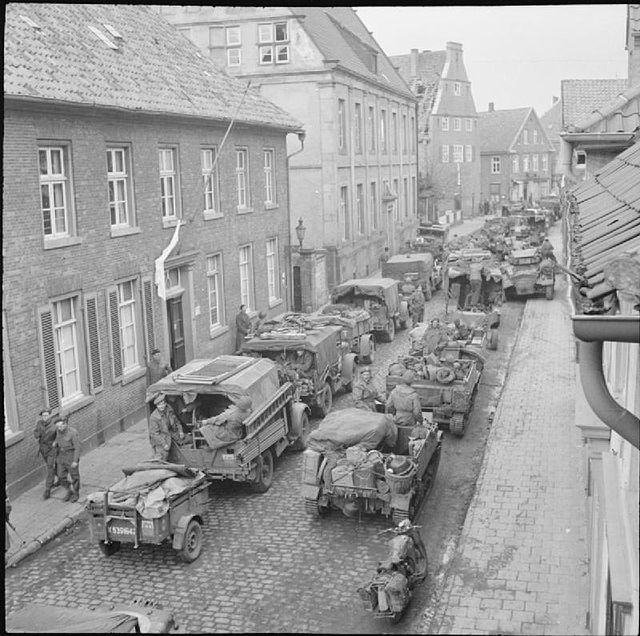 Photo: Sherman tank of the 1st Coldstream Guards, fitted with 60-pound aircraft rockets on the turret sides, crossing a pontoon bridge over the Dortmund-Ems Canal, 6 April 1945 Photo: Sherman tank of the 1st Coldstream Guards, fitted with 60-pound aircraft rockets on the turret sides, crossing a pontoon bridge over the Dortmund-Ems Canal, 6 April 1945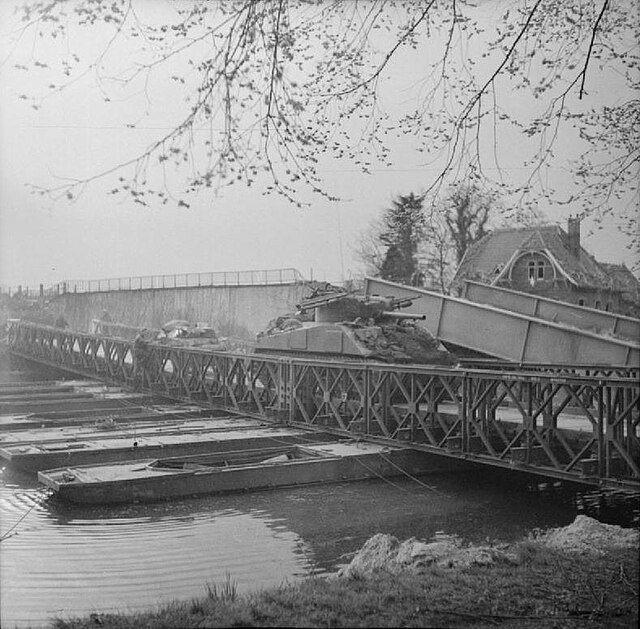 Western Front (1945) - Liberation of the Netherlands Western Front (1945) - Liberation of the Netherlands3rd Canadian Division takes Zutphen in north-east Holland. On the Island of Texel off the Dutch coast, the Georgian troops serving as volunteers with the German army mutinied. Air War over Europe British Bomber Command is directed to discontinue area-bombing unless specifically directed. 54 RAF Lancasters and 1 Mosquito of No 5 Group to attack a ship or ships which had broken the naval blockade around that large part of Western Holland where German forces were cut off. The raid was abandoned because of bad weather. Italian campaign British Guards and Commando units attack over the River Reno between Lake Comachio and the sea. GermanyJoseph Goebbels announced that a German victory was to come during this month and only Adolf Hitler knew the moment. He obtained this information from astrology. Adolf Hitler read Wilhelm Canaris' diary in which Hitler he learned of Canaris' involvement in anti-Nazi activities. Pacific WarCHINA (Fourteenth Air Force): 3 B-24s hit targets of opportunity in the Bakli Bay area on Hainan Island and 4 P-38s knock out a bridge in the Dien Bien Phu area of French Indochina. In China, 8 P-51s blast railroad targets of opportunity, troops, horses, and boat landings in the Chenghsien area and along the Lung Hai railroad and Yellow River. INDIA-BURMA (Tenth Air Force): With improving weather conditions combat strikes in the C Burma battle area increase; 70+ fighter-bombers attack troop concentrations, artillery positions, tanks, trucks, fuel dumps, and general targets of opportunity along and immediately behind enemy lines; targets are located in several areas including Paklu, Nawnghkio, Loilem, Takaw, Mong Hko, Kongleng, Nawnghsan Pu, and Indaw; air supply sorties continue on a steady basis throughout the day. GUAM (Seventh Air Force): 11 B-24s from Guam Island pound positions and airfield on Marcus Island; 23 from Angaur Airfield bomb barracks and a wharf at Bunawan, Mindanao. 400 Kamikaze planes make an all-out effort against Okinawa shipping and beachheads; 2 destroyers, 2 ammunition ships, a mine sweeper and an LST are sunk; other vessels are damaged; nearly 300 Japanese planes are expended. The 163d Liaison Squadron, AAFPOA (attached to Tenth Army) begins a movement from Schofield Barracks, Hawaii to Okinawa with L-5s. TINIAN (Twentieth Air Force): HQ 468th BG (Very Heavy) arrives at West Field, Tinian Island from India. JAPAN The Japanese battleship Yamato sails from the Inland Sea with a cruiser and 8 destroyers on a Kamikaze mission to Okinawa. The battleship only has enough fuel to reach the island and it is intended to beach the Yamato off Okinawa and fight any American forces nearby. US submarines sight the Yamato several times and report its position during the day. Photo: The Yamato in the morning of 6 April 1945, photographed at 09:47, shortly before departure on her final mission; above to the left is Mashima, part of Ōzushima, above a little to the right Sukumo-jima, then the southern arm of Tokuyama Bay Photo: The Yamato in the morning of 6 April 1945, photographed at 09:47, shortly before departure on her final mission Photo: The Yamato in the morning of 6 April 1945, photographed at 09:47, shortly before departure on her final mission SOUTHWEST PACIFIC AREA [Far East Air Force]: B-25s bomb the town of Hokko on Formosa. PHILIPPINE CAMPAIGN (1945) US Army Forces, Pacific (AFPAC) is established at Manila under General of the Army Douglas MacArthur. On Luzon Island, ground support sorties continue in areas around Balete Pass, W of Ft Stotsenburg, N, NE, and S of Laguna de Bay, and around Legaspi and fighters hit Carabao and Infanta. B-24s bomb a town N of Cebu City while fighters support ground units on Cebu. A-20s support ground forces on Negros Island. B-25s pound Bunawan on Mindanao. B-24s bomb Jolo defenses and ammunition and supply dumps. The 310th Fighter Squadron, 58th Fighter Group, moves from San Jose, Mindoro Island to Mangaldan with P-47s. VOLCANO AND RYUKYU ISLANDS CAMPAIGN On Okinawa, the US 3rd Amphibious Corps continues to advance in the north, but the US 24th Corps is held by Japanese forces along the first defenses of the Shuri Line. Photo: Men of U.S. Tenth Army make their way through a mine field, detonating mines with their own cannon. Okinawa. April 6, 1945 Photo: Supported by a tank, infantrymen advance through heavy fire on the southern front on Okinawa, 6 April 1945 Photo: Supported by a tank, infantrymen advance through heavy fire on the southern front on Okinawa, 6 April 1945 Japanese kamikaze onslaught against U.S. ships off Okinawa begins: destroyer Bush (DD-529) is sunk, 27°16'N, 127°48'E; four kamikazes irreparably damage destroyer Colhoun (DD-801), 27°16'N, 127°48'E, which is then scuttled by destroyer Cassin Young (DD-793). High speed minesweeper Emmons (DMS-22) is damaged by five suiciders, 26°48'N, 128°04'E; destroyer Mullany (DD-528) is damaged by two, 26°24'N, 128°10'E; as is destroyer escort Witter (DE-636), 26°04'N, 127°52'E. Other kamikazes damage destroyers Morris (DD-417), 25°55'N, 127°52'E [while high speed transport Daniel T. Griffin (APD-38) is damaged by collision with Morris as she fights fires alongside] 25°57'N, 127°57'E, Leutze (DD-481) and Newcomb (DD-586), 26°38'N, 127°28'E; Howorth (DD-592), 26°32'N, 127°40'; Haynesworth (DD-700), 26°55'N, 129°29'E; minesweepers Facility (AM-233), 26°00'N, 127°00'E; Defense (AM-317), 26°38'N, 127°31'E; and Devastator (AM-318), 26°26'N, 127°40'E; destroyer escort Fieberling (DE-640), high speed minesweeper Rodman (DMS-21), and minesweeper Ransom (AM-283), 26°48'N, 128°04'E; motor minesweepers YMS-311, 26°38'N, 127°48'E, and YMS-321, 26°00'N, 128°00'E; and tank landing ship LST-447, 26°09'N, 127°18'E. Near-misses by kamikazes damage small carrier San Jacinto (CVL-30), 26°46'N, 129°43'E, and destroyer Harrison (DD-573), 27°05'N, 129°22'E. Destroyer Hyman (DD-732) is damaged by kamikaze and torpedo, 26°45'N, 27°42'E; destroyer Taussig (DD-746) is damaged by near-miss of bombs, 27°07'N, 128°39'E; high speed minesweeper Harding (DMS-28) is damaged by horizontal bomber, 26°00'N, 127°00'E. Friendly fire accounts for damage to battleship North Carolina (BB-55), 26°41'N, 129°32'E; light cruiser Pasadena (CL-65), 27°00'N, 129°00'E; destroyer Hutchins (DD-476) [from destroyer Heywood L. Edwards (DD-663)], 26°00'N, 128°00'E; attack transport Barnett (APA-5) and attack cargo ship Leo (AKA-60), 26°21'N, 127°43'E; attack transport Audrain (APA-59), 26°22'N, 127°43'E; tank landing ships LST-241, 26°20'N, 127°45'E, and LST-1000, 26°21'N, 127°44'E; and submarine chaser PCS-1390, 26°00'N, 128°00'E. U.S. freighter Logan Victory, carrying 7,000 tons of ammunition, is irreparably damaged by kamikaze off Kerama Retto, 26°10'N, 127°16'E. Survivors are rescued by minesweeper Strategy (AM-308) and small craft; 3 (including its commander) of the 42-man Armed Guard are killed. The burning merchantman is then scuttled. U.S. freighter Hobbs Victory, also carrying ammunition, is attacked by two kamikazes northwest of Kerama Retto. Armed Guard gunners shoot down one and damage the second, but the latter manages to crash the freighter and start uncontrollable fires that lead to her abandonment, 26°05'N, 125°14'E. Minesweeper Success (AM-310) rescues survivors, transferring them later to attack transport Gosper (APA-170). Hobbs Victory explodes and sinks the following morning. Photo: The heavily damanged U.S. Navy destroyer USS Leutze (DD-481) alongside of the landing craft repair ship USS Egeria (ARL-8) at Kerama Retto anchorage, in April 1945. Leutze had been hit by four kamikaze aircraft off Okinawa on 6 April 1945. The destroyer USS Bennett (DD-473) is visible in the background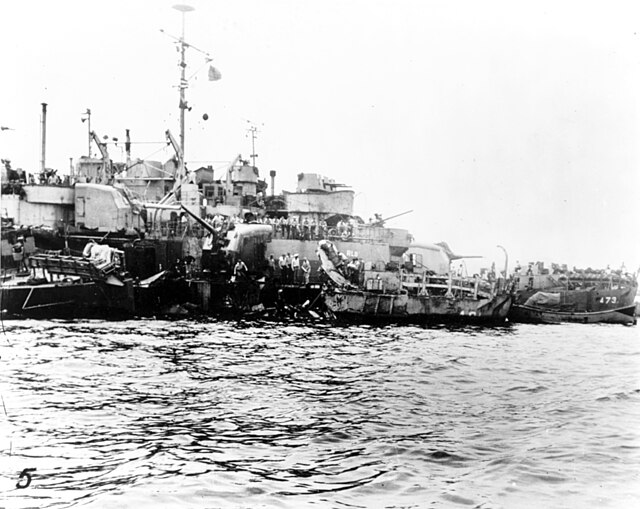 Photo: The U.S. Navy destroyer USS Leutze (DD-481) showing damage suffered after coming the assistance of USS Newcomb (DD-586) off Okinawa on 6 April 1945. A kamikaze glanced off Newcomb and exploded in the narrow space between the two ships. Leutze got much the worse of this, the upward force of the explosion damaging both propeller shafts and ripping her side open adjacent to mount 55. The damage is seen nearly a month later from both sides of her stern Photo: The U.S. Navy destroyer USS Leutze (DD-481) showing damage suffered after coming the assistance of USS Newcomb (DD-586) off Okinawa on 6 April 1945. A kamikaze glanced off Newcomb and exploded in the narrow space between the two ships. Leutze got much the worse of this, the upward force of the explosion damaging both propeller shafts and ripping her side open adjacent to mount 55. The damage is seen nearly a month later from both sides of her stern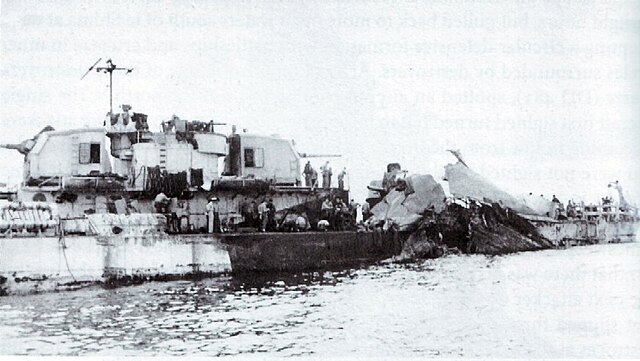 Photo: USS LST-447 being hit by a Japanese kamikaze pilot, 6 April 1945, off the Okinawa beachhead, Fortunately, LST-447 was empty after discharging her cargo on the beach, on D-day, 1 April 1945 Photo: USS LST-447 being hit by a Japanese kamikaze pilot, 6 April 1945, off the Okinawa beachhead, Fortunately, LST-447 was empty after discharging her cargo on the beach, on D-day, 1 April 1945 ALASKA (Eleventh Air Force): In the Kurile Islands, 8 B-24s attack and photograph Kurabu on Paramushiru Island, especially the airfield, while 8 B-25s hit radar installations in an all-out attack on Hayakegawa, Kotani Island, and Minami Cape, dropping napalm-filled incendiaries for the first time; buildings and shipping in N part of Hayakegawa are hit especially hard; another B-25 flies weather reconnaissance. UNITED STATES NAVY DEPARTMENT COMMUNIQUES, CINCPOA COMMUNIQUÉ NO. 323, APRIL 6, 1945 By late afternoon on April 6 (East Longitude Date), Hellcat and Corsair fighters from two fast carrier task groups of the U. S. Pacific Fleet commanded by Rear Admirals Frederick C. Sherman and J. J. Clark, USN, had shot down about 150 enemy aircraft which were attempting to attack fleet surface units in the area of the Ryukyus. This tally of damage is preliminary and incomplete. Some ships of our forces received minor damage but all remain fully operational. United States troops on Okinawa continued to attack in both the northern and southern sectors. At midday the Marine Third Amphibious Corps had advanced 3,000 to 5,000 yards against small scattered groups of the enemy on Ishikawa Isthmus. In the south, the Twenty Fourth Army Corps was encountering stiffened enemy resistance in areas organized by the enemy for defense and supported by enemy artillery. Our forces were being supported continuously by ships' gunfire and by carrier aircraft. During the night of April 5‑6, nine enemy planes were shot down near our forces around Okinawa. In capturing the Kerama group of islands preliminary to the attack on Okinawa, U. S. forces killed 539 of the enemy and captured 166 prisoners of war. Search aircraft of Fleet Wing One shot down two enemy aircraft in the Ryukyus area on April 6. PACIFIC Submarine Besugo (SS-321) sinks Japanese minesweeper W.12 in Saeku Strait, N.E.I., 08°13'S, 119°14'E. Submarine Hardhead (SS-365) again attacks unescorted Japanese convoy SASI-45, sinking merchant cargo ship Araosan Maru in Gulf of Siam, 09°37'N, 102°48'E USAAF B-25s on China coast shipping strike attack Japanese convoy HOMO-03, sinking Coast Defense Vessel No.1 and Coast Defense Vessel No.134 south-southwest of Amoy, 23°55'N, 117°40'E, and irreparably damaging destroyer Amatsukaze five miles east of Amoy, 24°30'N, 118°10'E; while Amatsukaze's crew manages to beach the ship at the entrance to Amoy harbor, she will perform no more wartime service. Mines sink Japanese merchant cargo ships Koun Maru in Yangtze near Chinkiang, Kabuto Maru at 32°02'N, 119°59'E, and (laid by USAAF planes on 4 March) Hsing Yun Maru in Yangtze, near Chinkiang, 32°05'N, 119°56'E. Japanese merchant cargo ship Fushimi Maru is sunk by USAAF mine in Shimonoseki Straits, 33°59'N, 130°52'E. Dutch Mitchells (which claim two hits) and RAAF Liberators (which claim many near misses) attack Japanese light cruiser Isuzu off Flores, N.E.I.
|
|
lordroel
Administrator
Member is Online
Posts: 68,014 
Likes: 49,411
|
Post by lordroel on Apr 7, 2024 7:34:23 GMT
Day 2036 of World War II, April 7th 1945Eastern Front Army Group Centre, under General Schörner, continues with its attacks against the 2nd and 4th Ukrainian Fronts. Western Front (1945) - Western Allied invasion of GermanyMap: HQ Twelfth Army Group situation map, April 7th 1945 In the West, the US Ninth Army captures Hameln and Eisenach on the road to Leipzig. There is heavy fighting by US 1st and 9th Armies around the Ruhr pocket. The German army in the west is disintegrating under the impact of Allied columns racing for Bremen. Hamburg, Hanover, Magdeburg and the Elbe. The roads are filled with long columns of prisoners trudging westwards into Allied prison camps. The British are closing on Hanover on the Autobahn to Berlin, while another spearhead is driving for Bremen. In the south, the Americans have broken through to Wurzburg. The devastation of the Rhine battle zone has been left behind and the Allied forces are passing through towns apparently untouched by war, except for empty shelves in shops and white flags hanging outside houses. Among the gains in the Allied advance to the east is Gottingen. Photo: Comet tanks of the 2nd Fife and Forfar Yeomanry, 11th Armoured Division, crossing the Weser at Petershagen, Germany, 7 April 1945 Photo: A Comet tank of 11th Armoured Division in the Weser bridgehead, Germany, 7 April 1945 Photo: A Comet tank of 11th Armoured Division in the Weser bridgehead, Germany, 7 April 1945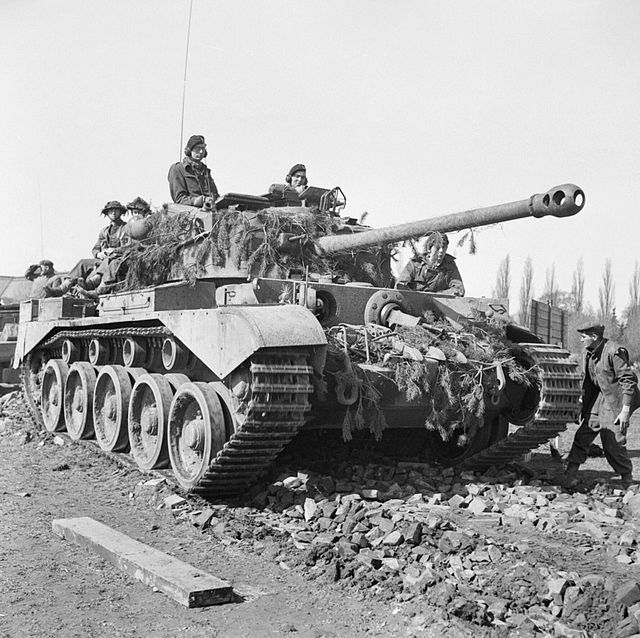 Photo: Sherman tanks of Guards Armoured Division crossing a bridge discovered intact over the River Ems, 6 April 1945 Photo: Sherman tanks of Guards Armoured Division crossing a bridge discovered intact over the River Ems, 6 April 1945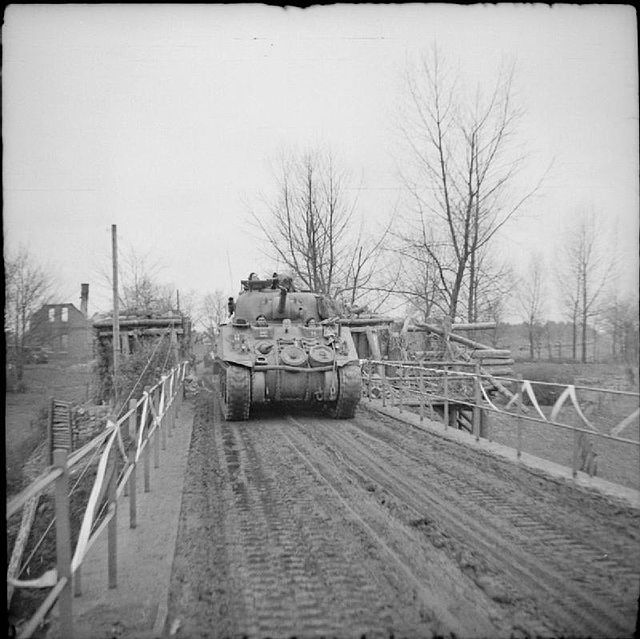 The Reichs gold reserve is captured when the 282nd Combat Engineer Battalion of Patton's 3d Army, discovers the Reichsbank gold reserve cache in the Kaiseroda potassium mine at Merkers. The haul includes 8,198 bars of gold bullion; 55 boxes of crated gold bullion; hundreds of bags of gold items; over 1,300 bags of gold Reichsmarks, British gold pounds, and French gold francs; 711 bags of American twenty-dollar gold pieces; hundreds of bags of gold and silver coins; hundreds of bags of foreign currency; 9 bags of valuable coins; 2,380 bags and 1,300 boxes of Reichsmarks (2.76 billion Reichsmarks); 20 silver bars; 40 bags containing silver bars; 63 boxes and 55 bags of silver plate; 1 bag containing six platinum bars; and 110 bags from various countries. The enormity of this hoard is such that Eisenhower appoints Colonel Bernard D. Bernstein, deputy chief, Financial Branch, G-5 Division of SHAEF to be responsible for its disposition. Western Front (1945) - Liberation of the NetherlandsFree French paratroops are dropped north of Zuider Zee in Holland. Air War over Europe The Eighth Air Force flies Mission 931: 1,314 bombers and 898 fighters are dispatched to hit airfields, oil and munitions depots and explosive plants in central and northern Germany; all primary targets are bombed visually; they meet 100+ conventional fighters and 50+ jets; the German fighters attack fiercely and in the ensuing air battle down 15 heavy bombers; the AAF claims 104-13-32 aircraft including a few jets. These Luftwaffe attacks are by the hastily formed Schulungslehrgang Elbe unit - Unternehmen Werewulf. 120 Bf-109s engage by ramming, destroying at most 13 bombers at a cost of 53 German fighters. Many of the poorly trained pilots never even engaged the US formation. 143 B-17s bomb airfields at Kaltenkirchen and 134 hit Parchim; 36 attack an oil depot at Buchen while 104 bomb a munitions depot at Gustrow; secondary targets hit are the marshalling yards at Neumunster by 37 B-17s and Schwerin by 48 B-17s; 1 other hit Salzwedel Airfield, a target of opportunity; they claim 26-10-10 aircraft; 14 B-17s are lost. Escorting are 317 P-51s; they claim 31-1-8 aircraft; 3 P-51s are lost. 128 B-24s bomb an explosive plants at Krummel while 168 bomb a plant at Duneburg; 26 others hit the marshalling yard at Neumunster; they claim 14-2-6 aircraft; 3 B-24s are lost. The escort is 252 P-47s and P-51s; they claim 30-0-7 aircraft; 2 P-51s are lost. 107 B-17s attack the airfield at Wesendorf , 93 hit Kohlenbissen Airfield and 115 bomb an oil depot at Hitzacker; 92 hit Lundeburg, the secondary; 25 others bomb targets of opportunity; they claim 0-0-1 aircraft. 209 P-51s escort without loss. The Ninth Air Force dispatches 268 A-20s, A-26 Invaders and B-26 Marauders to strike marshalling yards at Northeim and Gottingen, plus 2 town areas; fighters fly escort, patrols, and armed reconnaissance, and support the US 7th Armored Division at Schmallenberg, the 3d and 9th Armored Divisions along the Weser River east of Warburg, the VIII, XII, and XX Corps in the Muhlhausen, Eisenach, and Meiningen areas (including strong air support against a counterattack on the XII and XX Corps at Struth), the 2d Armored Division along the Sarstedt-Hildesheim road, and the XVI Corps between the Lippe and Ruhr Rivers in the Essen area. A small number of Fifteenth Air Force bombers attack marshalling yards at Innsbruck, Sankt Veit an der Glan, and Klagenfurt. 82 P-38s bomb the Tainach-Stein railroad bridge while 74 others sent against a bridge in southern Austria abort due to weather. RAF Mosquito bombers raid Berlin from bases on the continent, for the first time. 15 RAF Lancasters (No 617 Squadron) and 2 Mosquitos of No 5 Group carried out an accurate attack on ships at Ijmuiden. No aircraft lost. 175 RAF Lancasters and 11 Mosquitos of No 5 Group attacked the benzol plant at Molbis, near Leipzig. The weather was clear and the bombing was so effective that all production at the plant ceased. No aircraft lost. Italian campaign During the night of 6/7 April, Twelfth Air Force A-20s and A-26s bomb bridges at Lavis, Ala, Rovereto, and San Ambrogio di VaIpolicella, and several Po River crossings; during the day weather grounds the medium bombers; XXII Tactical Air Command fighters and fighter bombers, operating on a limited scale, hit the Montechino oil field, ammunition dumps and communications targets north of the battle area, and gun positions in the Monte Belvedere-Strettoia area in which US Fifth Army forces push north. 128 Fifteenth Air Force B-17s and B-24s attack the Mezzocorona railroad bridge and nearby road bridge, and the Verona-Parona di VaIpolicella railroad bridge while 500+ bombers return to base without bombing because of multi-layer clouds. Battle of the Atlantic The destroyer escort USS 'Gustafson' (DE-182) sinks German submarine 'U-857' off Cape Cod, Massachusetts. 'U-1195' (German) 96' Depth charged; 9 of 10 self escape from after hatch even with 40 degree list on bottom, one without Drager gear, PoWs. U.S. freighter James W. Nesmith is torpedoed by German submarine U-1024 off Holyhead, England 53°23'N, 04°53'W; Canadian corvette HMCS Belleville tows the ship to safety, beaching her off Holyhead the next evening. There are no casualties to either the merchant complement or the 41-man Armed Guard; the ship is later repaired and returned to service. Germany Wilhelm Canaris was sentenced to death by a special SS tribunal. United StatesPhoto: The U.S. Navy heavy cruiser USS Louisville (CA-28) off the Mare Island Navy Yard, California (USA), 7 April 1945, while wearing camouflage Measure 22. Louisville had arrived on 6 February 1945 to receive repairs for damage inflicted by one kamikaze on 5 January 1945 and one kamikaze on 6 January 1945 Pacific War Pacific WarCHINA (Fourteenth Air Force): In China, 14 B-25s hit town areas and targets of opportunity at Sichuan, Hsihhsiassuchi, Neihsiang, Shaoyang, and Nanchang and 24 P-51s attack river, road and rail traffic in the Yellow River area, S of Anyi, at Yuncheng, and at Tengfeng. 4 B-24s bomb harbors and dock areas at Bakli and Samah Bays on Hainan Island and at Haiphong, French Indochina; and 8 P-38s hit targets of opportunity around Dien Bien Phu and along the Nam Hon area in French Indochina. INDIA-BURMA (Tenth Air Force): 95 fighter-bombers operating over and behind Japanese lines in C Burma pound troop concentrations, trucks, and supply areas, and sweep roads S of bomb line. The 3d Combat Cargo Squadron, 1st Combat Cargo Group, moves from Tulihal to Hathazari, India with C-47s. PALAU Seventh Air Force: 24 B-24s from Angaur Airfield bomb the barracks area at Bunawan on Mindanao. VII Fighter Command: Mission 1: 91 of 108 P-51s escort B-29s to Tokyo; they claim 21-5-7 Japanese aircraft; 2 P-51s are lost. (Twentieth Air Force): 2 missions are flown. Mission 58: 101 of 107 B-29s bomb the Nakajima aircraft engine plant at Tokyo; 2 others hit targets of opportunity; they claim 80-23-50 Japanese aircraft; 3 B-29s are lost. Mission 59: 153 of 194 B-29s hit the Mitsubishi aircraft plant at Nagoya; 29 others hit targets of opportunity; they claim 21-11-22 Japanese aircraft; 2 B-29s are lost. HQ 444th Bombardment Group (Very Heavy) arrives at West Field, Tinian Island from India. SOUTHWEST PACIFIC AREA [Far East Air Force]: B-24s and P-38s over Formosa hit various targets of opportunity. EAST CHINA SEA In the East China Sea, TF 58 (Vice Admiral Marc A. Mitscher) attacks Japanese First Diversion Attack Force, formed around battleship Yamato, moving through East China Sea toward Okinawa. YouTube (Sinking of the Battleship Yamato and Operation Ten-Go)TF 58 planes (numbering 386) sink Yamato after being hit by 10 torpedo and 5 bomb hits and light cruiser Yahagi west-southwest of Kagoshima, Japan, 30°40'N, 128°03'E; destroyers Asashimo in East China Sea, 31°00'N, 128°00'E, Hamakaze and Isokaze 150 miles southwest of Nagasaki, 30°40'N, 128°03'E, and Kasumi in East China Sea, 30°57'N, 127°57'E, and damage destroyers Suzutsuki Hatsushimo, Yukikaze, and Fuyuzuki in East China Sea, 30°40'N, 128°03'E.11. Photo: The Japanese battleship Yamato underway in formation with four destroyers on 7 April 1945. This photo was taken by a plane from the aircraft carrier USS Bennington (CV-20), just prior to the first attack at about 1230 hours Photo: The Japanese battleship Yamato under attack by USS Hornet (CV-12) aircraft during the first strike, 7 April 1945. A torpedo or bomb has just exploded forward on the starboard side. This is probably the torpedo that struck Yamato far forward on her port side at 1245 hrs, sending shock waves throughout the ship Photo: The Japanese battleship Yamato under attack by USS Hornet (CV-12) aircraft during the first strike, 7 April 1945. A torpedo or bomb has just exploded forward on the starboard side. This is probably the torpedo that struck Yamato far forward on her port side at 1245 hrs, sending shock waves throughout the ship Photo: Damaged Japanese battleship Yamato underway, 7 April 1945 Photo: Damaged Japanese battleship Yamato underway, 7 April 1945
 Photo: The Japanese battleship Yamato under attack by U.S. Navy carrier aircraft in the East China Sea on 7 April 1945, as a bomb explodes off its port side. The fire in the area of the aft 155mm turret can be clearly seen Photo: The Japanese battleship Yamato under attack by U.S. Navy carrier aircraft in the East China Sea on 7 April 1945, as a bomb explodes off its port side. The fire in the area of the aft 155mm turret can be clearly seen Photo: Smoke rises to the clouds shortly after the Japanese battleship Yamato capsized, exploded and sank after receiving many bomb and torpedo hits from U.S. Navy carrier planes north of Okinawa. An escorting destroyer is visible to the left of the smoke, 7 April 1945 Photo: Smoke rises to the clouds shortly after the Japanese battleship Yamato capsized, exploded and sank after receiving many bomb and torpedo hits from U.S. Navy carrier planes north of Okinawa. An escorting destroyer is visible to the left of the smoke, 7 April 1945 Photo: IJN destroyer Asashimo shortly before sinking after US Navy aircraft attacks, 7 April 1945 Photo: IJN destroyer Asashimo shortly before sinking after US Navy aircraft attacks, 7 April 1945 Photo: The Japanese light cruiser Yahagi under attack by U.S. planes. At 1246 hrs, during the first wave, a torpedo hit Yahagi directly in her engine room, killing the entire engine room crew and bringing her to a complete stop. One direct hit can be seen bursting on the fantail, as near-misses straddle her. The photo was taken before turret no. 2 was hit by a bomb, 7 April 1945 Photo: The Japanese light cruiser Yahagi under attack by U.S. planes. At 1246 hrs, during the first wave, a torpedo hit Yahagi directly in her engine room, killing the entire engine room crew and bringing her to a complete stop. One direct hit can be seen bursting on the fantail, as near-misses straddle her. The photo was taken before turret no. 2 was hit by a bomb, 7 April 1945 Photo: The Japanese light cruiser Yahagi is hit on 7 April 1945. Yahagi was hit by at least seven torpedoes and 12 bombs. The photo was taken by a plane from the aicraft carrier USS Yorktown (CV-10) Photo: The Japanese light cruiser Yahagi is hit on 7 April 1945. Yahagi was hit by at least seven torpedoes and 12 bombs. The photo was taken by a plane from the aicraft carrier USS Yorktown (CV-10)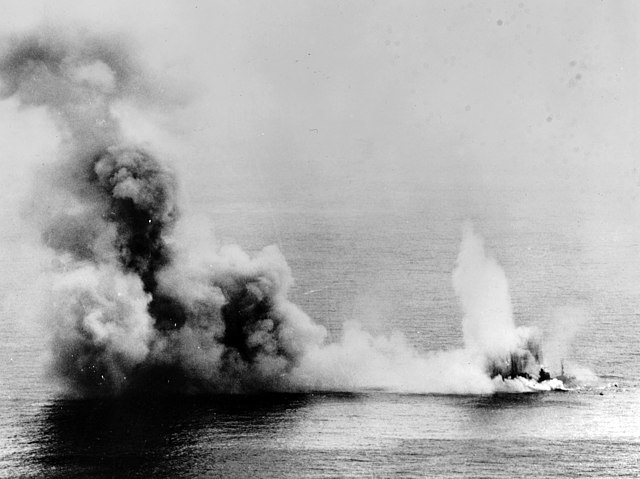 Photo: View of floating survivors and wreckage of the Japanese light cruiser Yahagi after she was sunk. Note the lifeboat on the left and the damaged floatplane. The photo was taken by a plane from the aicraft carrier USS Yorktown (CV-10), 7 April 1945 Photo: View of floating survivors and wreckage of the Japanese light cruiser Yahagi after she was sunk. Note the lifeboat on the left and the damaged floatplane. The photo was taken by a plane from the aicraft carrier USS Yorktown (CV-10), 7 April 1945 PHILIPPINE CAMPAIGN (1945) Bad weather hampers strikes N of the Philippines.Fighters fly 130+ sorties in support of ground forces at Solvec Cove, Villa Verde Trail, the Ipo and Marikina Rivers, and NE Laguna de Bay. B-24s again bomb Bunawan on Mindanao. Other B-24s and P-38s hit Jolo and B-24s bomb Bima Airfield on Sumbawa Island in the Lesser Sunda Islands. Unit moves: 311th Fighter Squadron, 58th Fighter Group, from San Jose, Mindoro Island to Mangaldan with P-47s; 550th Night Fighter Squadron, XIII Fighter Command (attached to 85th Fighter Wing), from Morotai Island, Moluccas Islands to Tacloban, Leyte Island, Philippine Islands with P-38s, P-61s and P-70s. VOLCANO AND RYUKYU ISLANDS CAMPAIGN Off Okinawa, high speed minesweeper Emmons (DMS-22), irreparably damaged by five kamikazes the previous day, is scuttled by high speed minesweeper Ellyson (DMS-19); tank landing ship LST-447 sinks as the result of damage inflicted by kamikaze the previous day, 26°09'N, 127°18'E. Motor gunboat PGM-18 is sunk by mine, 26°13'N, 127°55'E; while picking up PGM-18's survivors, motor minesweeper YMS-103 is damaged by mine, 26°13'N, 127°54'E. Also off Okinawa, kamikazes damage carrier Hancock (CV-19), 27°00'N, 130°00'E; battleship Maryland (BB-46), 26°40'N, 127°29'E; destroyers Longshaw (DD-559), 26°29'N, 127°41'E, and Bennett (DD-473), 27°16'N, 127°48'E; destroyer escort Wesson (DE-184), 26°48'N, 127°55'E; and motor minesweeper YMS-81, 26°35'N, 127°53'E; shore battery damages motor minesweeper YMS-427, 26°14'N, 127°52'E; tank landing ship LST-698 is damaged by grounding, 26°24'N, 127°45'E; tank landing ship LST-890 is damaged in collision with LST-788, 26°20'N, 127°45'E. Photo: A Kamikaze hits the U.S. Navy aircraft carrier USS Hancock (CV-19) off Okinawa on 7 April 1945 Photo: The U.S. Navy aircraft carrier USS Hancock (CV-19) smoking and turning to port after being struck by a kamikaze, 7 April 1945 Photo: The U.S. Navy aircraft carrier USS Hancock (CV-19) smoking and turning to port after being struck by a kamikaze, 7 April 1945 Photo: The U.S. Navy aircraft carrier USS Hancock (CV-19) afire after being hit by a kamikaze off Okinawa, 7 April 1945 Photo: The U.S. Navy aircraft carrier USS Hancock (CV-19) afire after being hit by a kamikaze off Okinawa, 7 April 1945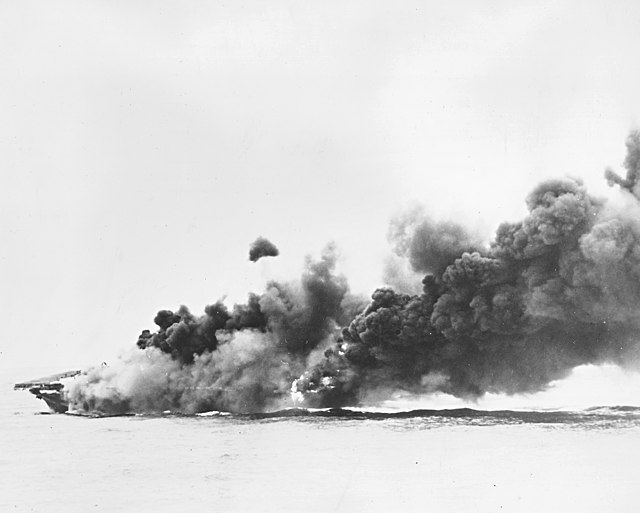 JAPAN American P-51 Mustang fighters, based on Iwo Jima, escort B-29 Superfortress bombers on a raid to Tokyo. ALASKA (Eleventh Air Force): A B-24 flies a radar-ferret mission along the coasts of Paramushiru and Harumukotan Islands in the Kurile Islands. UNITED STATES NAVY DEPARTMENT COMMUNIQUES, CINCPOA COMMUNIQUÉ NO. 324, APRIL 7, 1945 On April 6 and 7 (East Longitude Dates) the enemy attempted strong counterattacks against our forces operating in the vicinity of Okinawa. During the late afternoon and evening of April 6, a large force of enemy aircraft attacked our ships and shore installations in the vicinity of Okinawa. One hundred sixteen of these enemy aircraft were destroyed‑55 by our fighters and the remainder by our antiaircraft fire. The attacking enemy aircraft pressed their attacks in with desperation and succeeded in sinking three of our destroyers and damaging several destroyers and smaller craft. No larger fleet units were hit. Early on April 7, Navy Search Aircraft of Fleet Air Wing One sighted an enemy surface force which had left the Inland Sea and passing south of Kyushu had headed into the East China Sea. The force included the large battleship Yamato, the most powerful ship left in the Japanese Navy, an Agano class light cruiser, one other small light cruiser or large destroyer, and a number of destroyers. A fast carrier task force commanded by Vice Admiral Marc A. Mitscher steamed toward the enemy at high speed and during the middle of the day brought the Japanese Force under air attack. Our carrier aircraft which had destroyed 245 enemy aircraft on April 6, met no opposition over the Japanese ships but did meet heavy antiaircraft fire. At a point about 50 miles southwest of Kyushu they sank the Yamato, the light Agano class cruiser, the small cruiser and three destroyers. Three other destroyers were left burning. About three destroyers escaped from this attack. The Yamato was hit by at least eight torpedoes and eight heavy bombs. All the enemy ships were heavily strafed with rockets and machine guns. Our carriers lost seven aircraft in this action. During minor contacts on April 7, they and their aircraft shot down 30 enemy aircraft. The task groups participating were commanded by Rear Admirals F. C. Sherman, U. S. Navy, A. W. Radford, U. S. Navy, G. F. Bogan, U. S. Navy, and J. J. Clark, U. S. Navy. The Marine Third Amphibious Corps on Okinawa moved forward steadily in the northern sector throughout the afternoon of April 6. By 1800, it had made advances which placed its front lines across Ishikawa Isthmus from Chuda on the west coast to the mouth of the Kinbaru River on the east coast. In the south, strong enemy resistance developed during the day. From its' strong defensive positions the enemy employed machine gun, small arms, mortar and artillery fire against the Twenty‑Fourth Army Corps throughout April 6, and the following night. Army troops along the East Coast in the southern sector advanced about 2,000 yards during the afternoon of April 6, and occupied the town of Tsuwa. The enemy in the south was brought under heavy fire by our artillery throughout the day. Search Aircraft of Fleet Air Wing One attacked airfields in Kyushu, destroying four fighters on the ground, probably destroying three others and damaging about 15 more by strafing. Liberators of the Seventh Army Air Force bombed dock installations and buildings at Truk in the Carolines on April 5. Neutralizing raids on enemy bases in the Marshalls were continued on April 5 by planes of the Fourth Marine Aircraft Wing. UNITED STATES NAVY DEPARTMENT COMMUNIQUES, CINCPOA COMMUNIQUÉ NO. 325, APRIL 7, 1945 The Marine Third Amphibious Corps continued to drive northward against negligible enemy resistance on the Ishikawa Isthmus of Okinawa on April 7 (East Longitude Date). By noon of that date, the Marines had advanced about 3,000 yards to the vicinity of Nago Town on the west coast and Ora Bay on the east coast. The Twenty‑Fourth Army Corps in the south was moving through difficult terrain in which the enemy is fortified behind an extensive system of strong points, pillboxes, blockhouses and trenches. Carrier aircraft, ships' guns and heavy artillery continued to bombard enemy positions. A small group of aircraft attacked our forces early in the day. Twelve were shot down. A carrier task force of the British Pacific Fleet attacked airfields and other installations on Ishigaki and Miyako in the Sakishima group on April 6 and 7. British fighters destroyed five enemy aircraft in the air and three others on the ground. Further information on the action of fast carrier task forces of the U. S. Pacific Fleet on April 6 shows that our aircraft sank four small cargo ships and many small craft in the area of the Ryukyus and ‑destroyed two aircraft on the ground, this damage being in addition to that previously reported. On April 7, after attacking Japanese surface forces off Kyushu, one of our heavy fleet units suffered minor damage during an aircraft attack but is fully operational. Hellcat and Corsair fighters of the Fourth Marine Aircraft Wing bombed and strafed warehouses and other installations in the Palaus on April 7. UNITED STATES NAVY DEPARTMENT COMMUNIQUES, CINCPOA PRESS RELEASE NO. 63, APRIL 7, 1945 Additional information on the three‑day strike of the British Pacific Fleet on the Sakishima Group 31 March to 2 April (East Longitude Dates) shows extensive damage inflicted on enemy ground installations in those islands, destruction of 22 enemy aircraft and damage to nine others. Some major units of the British Pacific Fleet sustained slight damage from enemy aircraft during the attacks but all major units remained fully operational. PACIFIC Submarines Gabilan (SS-252) and Charr (SS-328) sink Japanese light cruiser Isuzu, transporting troops from Koepang, Timor, to Surabaya, off Soembawa Island Celebes, N.E.I., 07°38'S, 118°09'E. Submarine Tirante (SS-420) sinks Japanese auxiliary submarine chaser Tama Maru 10 miles east of Shokokusanto, southwest of Korea, 34°35'N, 125°20'E. Japanese fleet tanker Kamoi is sunk by aircraft, Hong Kong. Mine laid by USAAF B-29 (20th Bomber Command) sinks Japanese merchant cargo ship Hatsukari Maru off Wakamatsu harbor, 33°55'N, 130°50'E. Mine damages Japanese naval auxiliary Shinto Maru below Woosung, China. Japanese auxiliary submarine chaser No.43 Hino Maru is damaged by aircraft, south end of Hirato Jima, near Kyushu, Japan.
|
|
lordroel
Administrator
Member is Online
Posts: 68,014 
Likes: 49,411
|
Post by lordroel on Apr 8, 2024 2:48:12 GMT
Day 2037 of World War II, April 8th 1945Eastern FrontIn Austria, the Soviet forces push on west of Vienna despite German counterattacks. There is heavy fighting in the Austrian capital. In East Prussia, the Soviet attacks on Konigsberg begin to break through the defenses. Western Front (1945) - Western Allied invasion of GermanyMap: HQ Twelfth Army Group situation map, April 8th 1945 On the southern flank, troops of the French 1st Army take Pforzheim as they continue their drive to the southeast. US 7th Army units capture Schweinfurt. Other Allied armies farther north also advance. Photo: A Sherman tank passing through Hopsten, 8 April 1945 Photo: A Valentine Mk XI artillery OP tank passing through Hopsten, 8 April 1945 Photo: A Valentine Mk XI artillery OP tank passing through Hopsten, 8 April 1945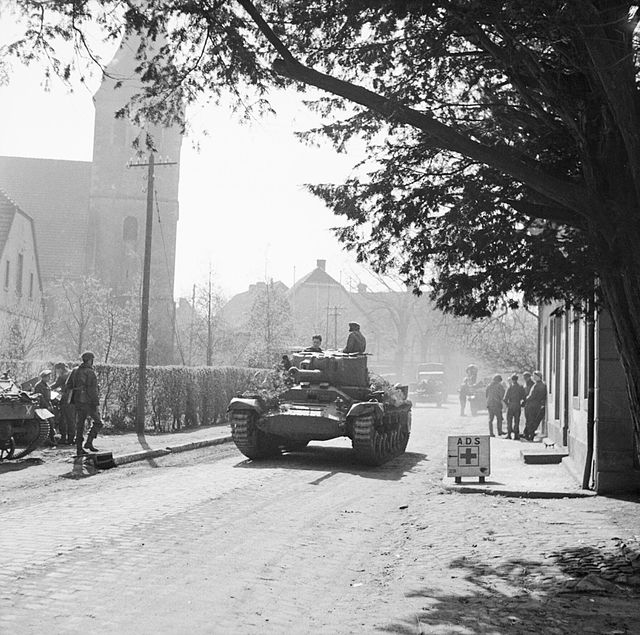 Photo: Infantrymen crouch close to buildings as tanks go down the streets of Konigshoffen routing out snipers. 8 April, 1945 Photo: Infantrymen crouch close to buildings as tanks go down the streets of Konigshoffen routing out snipers. 8 April, 1945
 Photo: A Humber scout car and trucks of 59th Heavy Regiment, Royal Artillery crossing a Bailey bridge at Dreierwalde, 8 April 1945 Photo: A Humber scout car and trucks of 59th Heavy Regiment, Royal Artillery crossing a Bailey bridge at Dreierwalde, 8 April 1945 Western Front (1945) - Liberation of the Netherlands Western Front (1945) - Liberation of the NetherlandsA British SAS brigade was dropped into eastern Netherlands as an advance force for Canadian units moving north. Air War over Europe The US Eighth Air Force flies Mission 932: 1,173 bombers and 794 fighters attack various targets in Germany; 9 bombers and 1 fighter are lost. 31 B-17s bomb the Derben oil depot and 73 attack Schafstadt Airfield; 213 bomb the Halberstadt marshalling yard while 73 attack the Stendal marshalling yard; Derben is hit visually and the others targets visually and with H2X radar; 4 B-17s are lost. Escorting are 239 P-51s. 86 B-17s hit the marshalling yards at Plauen, 101 hit the marshalling yards at Hof, 111 bomb the marshalling yard at Eger and 203 attack an ordnance depot at Grafenwohr; the attacks are made visually and with H2X radar; 5 B-17s are lost. Escort is provided by 235 P-51s. 51 B-24s attack the munitions depot at Bayreuth, 89 bomb the Blumenthal jet aircraft factory at Furth while 57 bomb Unterschlauersbach Airfield and 91 hit Roth Airfield. The escort is 245 P-47s and P-51s; 1 P-47 is lost. Around 620 Ninth Air Force A-20s, A-26 Invaders, and B-26 Marauders bomb the Munchenbernsdorf oil storage depot, the Sonderhausen communications center, Nienhagen oil refinery, Celle marshalling yard, and 8 city areas; fighters escort the bombers, attack an airfield, fly patrols and armed reconnaissance, and operate in conjunction with the US VIII, XII, and XX Corps in the Thuringer Forest and Erfurt areas. Fifteenth Air Force P-38s bomb the Garmisch railroad bridge and strafe rail traffic in the Munich, area. Fifteenth Air Force P-38s bomb the Rattenberg railroad bridge and strafe rail traffic in the Salzburg and Linz areas. 440 RAF aircraft - 263 Halifaxes, 160 Lancasters, 17 Mosquitos - of Nos 4,6 and 8 Groups dispatched to Hamburg. 3 Halifaxes and 3 Lancasters lost. This attack was intended for the shipyard areas but partial cloud caused the raid to become dispersed. Some damage was probably caused to the shipyards but, as an American raid on the yards had taken place a few hours earlier, damage seen in photographs could not be allocated between the two forces. This was the last major Bomber Command raid of the war on Hamburg. 231 RAF Lancasters and 11 Mosquitos of No 5 Group attacked the Lützkendorf oil refinery, which had escaped serious damage the previous night. The refinery was rendered 'inactive'. 6 Lancasters lost. 22 RAF Halifaxes of No 4 Group in a diversionary raid on Travemünde, 71 Mosquitos to Dessau, 28 to Berlin (where Oboe from forward ground stations was used for the first time) and 8 to Munich, 64 RCM sorties, 43 Mosquito patrols. No aircraft lost. Italian campaign British troops attacked the area between the southern tip of Lake Comacchio and the Fossa di Navigazione, known as 'The Wedge', in northern Italy. Photo: Churchill tanks advance along the Faenza-Russi road, 8 April 1945 Photo: A fascine is loaded onto a Churchill AVRE from a lorry, River Senio, 8 April 1945 Photo: A fascine is loaded onto a Churchill AVRE from a lorry, River Senio, 8 April 1945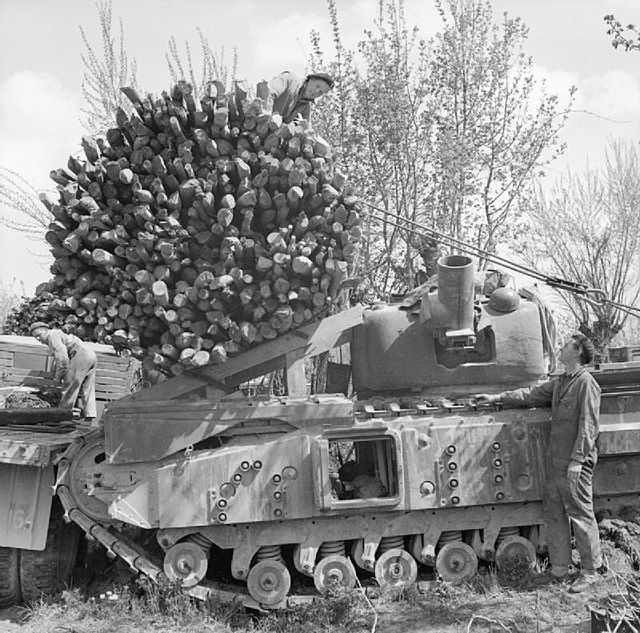 Photo: Tank spins around a corner, and the sign on the building points toward Massa. 8 April, 1945 Photo: Tank spins around a corner, and the sign on the building points toward Massa. 8 April, 1945
 Photo: As the 442nd Inf. Regt. (Nisei) pushes on Mt. Belvedere, tanks of the 756th Light Tank Bn. (Negro) fire in support with 75mm howitzers from Seravezza. 8 April, 1945 Photo: As the 442nd Inf. Regt. (Nisei) pushes on Mt. Belvedere, tanks of the 756th Light Tank Bn. (Negro) fire in support with 75mm howitzers from Seravezza. 8 April, 1945
 During the night of 7/8 April, US Twelfth Air Force A-20s and A-26s hit command posts and dumps; medium bombers, despite bad weather bomb railroad bridges at Salorno, San Michele all' Adige, Vo Sinistro, and Bondeno, a railroad fill and canal at Salorno, and gun positions at La Spezia; XXII Tactical Air Command fighter-bombers concentrate their efforts on the Brenner area communications (cutting lines in 31 places and damaging 4 bridges), oil fields in the central Po Valley, and points further north. 500+ Fifteenth Air Force B-24s and B-17s, with fighter escorts, attack communications in northern Italy, concentrating on the transportation system feeding into the Brenner Pass; bridges, viaducts, and marshalling yards are hit at or near Bressanone, Campodazzo, Vipiteno, Fortezza, Campo di Trens, Mezzocorona, Avisio, Brescia, Gorizia, Pordenone, and Ponte Gardena; a power dam at Ponte Gardena is also hit. Photo: B-17s of the 419th Bomber Sqdn., 301st Group, 5th Wing, 15th AAF, on the taxi strip before takeoff. 8 April, 1945
 United StatesPhoto: USS Huntington feels water for the first time as her hull slides into the Delaware river at the New York Shipbuilding Corporation in Camden, New Jersey, 8 April 1945 United StatesPhoto: USS Huntington feels water for the first time as her hull slides into the Delaware river at the New York Shipbuilding Corporation in Camden, New Jersey, 8 April 1945 Photo: The U.S. Navy escort carrier USS Kadashan Bay (CVE-76) at San Francisco, California (USA), on 8 April 1945. She is painted in Camouflage Measure 21. Several Lockheed PV patrol bombers are carried on deck Photo: The U.S. Navy escort carrier USS Kadashan Bay (CVE-76) at San Francisco, California (USA), on 8 April 1945. She is painted in Camouflage Measure 21. Several Lockheed PV patrol bombers are carried on deck Pacific War Pacific War CHINA (Fourteenth Air Force): In China, 31 P-51s knock out a bridge S of Shaoyang, destroy a section of track at Sincheng, and hit numerous road and rail targets of opportunity in the Yellow River areas and points to the S, from Shanhsien to Loning, at Hungtung, and S of Hei-Shih Kuan; 4 B-24s attack shipping targets of opportunity in the S China Sea and in Bakli Bay on Hainan Island and Yulin Bay, China and bomb Kowloon Docks in Hong Kong. The Japanese Army initiates a ground offensive against Paoching. The purpose is to drive 80 miles into Hunan Province and capture Chichiang Airfield. This turns out to be the last Japanese offensive in China. INDIA-BURMA (Tenth Air Force): 50+ P-38s and P-47s operating in C Burma battle areas attack troops, supplies, gun positions, and trucks at several points along and behind enemy lines, and sweep roads S of bomb line; transports maintain operations throughout the day. The 156th Liaison Squadron (Commando), 2d Air Commando Group, based at Kalaikunda, India with UC-64s and L-5s, sends a detachment to operate from Myitche, Burma. BURMA The forces of the British 14th Army have completed regrouping, following their successes at Mandalay and Meiktila, and are now ready for a final offensive against the remaining Japanese forces. The British 4th Corps is to advance down the Sittang Valley and British 33rd Corps by the Irrawaddy Valley. All of the units have been reorganized to make them more mobile. PALAU Seventh Air Force: 25 B-24s from Angaur Airfield bomb the Bunawan area on Mindanao. VII Fighter Command: During the night of 8/9 Apr, 6 P-61s from Iwo Jima, operating singly at 2-hour intervals, bomb Chichi Jima, Haha Jima, Ani Jima, and Ototo Jima. Twentieth Air Force): 2 missions are flown against airfields on Kyushu Island, Japan from which Kamikaze attacks are originating. Mission 60: 29 of 32 B-29s strike 2 airfields at Kanoya. Mission 61: 48 B-29s attack the airfield at Kokubu; 1 B-29 is lost. PHILIPPINE CAMPAIGN (1945) The US forces on Negros are reinforced by the landing of a second regiment, in the northwest of the island, near Bacolod. For the second consecutive day bad weather prevents attacks on the primary targets N of the Philippine Islands. B-24s and B-25s hit secondary targets including Chomosui Airfield in the Pescadores Islands, and on Formosa, Tainan and railroad yards, the towns of Takao, Toko, and Kaiko, and other scattered objectives. A-20s and fighter-bombers over Luzon support ground forces particularly in the areas E of Manila. B-24s join A-20s and fighter-bombers in support of ground forces on Cebu and Negros. Other B-24s bomb the N Davao Bay area on Mindanao and Jolo Island. Unit moves to Luzon: 33d Troop Carrier Squadron, 374th Troop Carrier Group, from Hollandia, New Guinea to Nielson Field with C-47s; 69th Fighter Squadron, 58th Fighter Group from San Jose, Mindoro Island to Mangaldan with P-47s. Off Okinawa, destroyer Charles J. Badger (DD-657) is damaged by assault demolition boat, 26°18'N, 127°39'E; destroyer Gregory (DD-802) is damaged by kamikaze, 27°07'N, 128°39'E; motor minesweeper YMS-92 is damaged by mine, 26°12'N, 127°53'E; tank landing ship LST-939 is damaged in collision with tank landing ship LST-268, 26°22'N, 127°44'E; tank landing ship LST-940 is damaged by grounding, 26°20'N, 127°45'E. VOLCANO AND RYUKYU ISLANDS CAMPAIGN On Okinawa, the forces of US 3rd Amphibious Corps, attacking northward on the island, have cut the neck of the Motobu Peninsula and US 6th Marine Division begins operations to clear it of Japanese forces. At sea, there are less intense Kamikaze attacks. UNITED STATES NAVY DEPARTMENT COMMUNIQUES, CINCPOA COMMUNIQUÉ NO. 326, APRIL 8, 1945 On the afternoon of April 7 (East Longitude Date) the Twenty‑Fourth Army Corps drove into heavily defended terrain in the southern sector of Okinawa and captured the villages of Uchitomari and Kaniku. The enemy resisted stubbornly from numerous pillboxes and blockhouses which are emplaced to take full advantage of the broken terrain. In the north, Marines of the Third Amphibious Corps continued to move northward rapidly against negligible opposition. Four enemy aircraft appeared in the Okinawa area on April 7 and all were shot down. On the following day Twenty‑Fourth Corps troops made small gains against heavy opposition in the south. By 1800 of that date the front line on their right had moved forward about 200 yards and on the left about 400 yards. Heavy artillery was used by the enemy throughout the night and day. Our troops are being supported by ships' gunfire, carrier aircraft and field artillery. In the northern sector of the island on April 8, Marines of the Third Amphibious Corps had moved 3,000 to 4,800 yards westward along Motobu peninsula by nightfall. Fighters of the Second Marine Aircraft Wing have begun to use the captured air fields on Okinawa. Major General F. P. Mulcahy, USMC, is present in command of the tactical air forces on shore at Okinawa. Nine enemy aircraft were destroyed on April 8 by various forces. By the end of April 7, 30,000 civilians were under care of the U. S. Military Government on Okinawa. Native housing is being utilized fully. Carrier aircraft attacked shipping and installations in the area of the Amami group on April 8. A small cargo ship was set afire and a lugger destroyed. PACIFIC British submarine HMS Stygian unsuccessfully attacks Japanese cargo vessel Enoshima Maru, 06°30'S, 113°08'E. USAAF B-24 (13th Air Force) attacks Japanese auxiliary submarine chasers southeast of the Celebes, sinking Cha 101 and damaging Cha 72, 04°43'S, 122°17'E. Mines (laid by USAAF planes) sink Japanese cargo ship No.12 Tamon Maru in Yangtze, near Shanghai, 31°16'N, 121°45'E, and damages escort destroyer Habushi ten miles below Woosung.
|
|
lordroel
Administrator
Member is Online
Posts: 68,014 
Likes: 49,411
|
Post by lordroel on Apr 9, 2024 2:49:22 GMT
Day 2038 of World War II, April 9th 1945Eastern FrontThe surviving German defenders of the Konigsberg fortress surrender to the Red Army forces. Some of the German troops in East Prussia continue to resist in the Samland Peninsula. Map: 1945 Königsberg Defense Dispositive Western Front (1945) - Western Allied invasion of GermanyMap: HQ Twelfth Army Group situation map, April 9th 1945 Western Front (1945) - Western Allied invasion of GermanyMap: HQ Twelfth Army Group situation map, April 9th 1945 In the attacks against the Ruhr pocket, US 9th Army units penetrate into Essen and reach the famous Krupp factories. Other British and American units, including some more from US 9th Army, are advancing near the Leine River to the east. Photo: 7th U.S. Army infantrymen advance up hill towards Wetzhausen, Germany, while tanks wait to move up with other troops. 9 April, 1945 Photo: 7th U.S. Army armor and infantry move to attack the town of Wetzhausen, Germany. 9 April, 1945 Photo: 7th U.S. Army armor and infantry move to attack the town of Wetzhausen, Germany. 9 April, 1945 Western Front (1945) - Liberation of the NetherlandsPhoto: Infantry of the Regiment de Maisonneuve moving through Holten to Rijssen, both towns in the Netherlands. 9 April 1945 Western Front (1945) - Liberation of the NetherlandsPhoto: Infantry of the Regiment de Maisonneuve moving through Holten to Rijssen, both towns in the Netherlands. 9 April 1945 Air War over Europe Air War over Europe Hamburg: 57 RAF Lancasters of No 5 Group attacked oil-storage tanks (40 aircraft) and U-boat shelters (17 aircraft of No 617 Squadron with Grand Slams and Tallboys). Both attacks were successful. 2 Lancasters were lost from the raid on the oil tanks. 591 RAF Lancasters and 8 Mosquitos of Nos 1, 3 and 8 Groups to Kiel. 3 Lancasters lost. This was an accurate raid, made in good visibility on two aiming points in the harbour area. Photographic reconnaissance showed that the Deutsche Werke U-boat yard was severely damaged, the 'Admiral Scheer' capsizes, while the 'Admiral Hipper' and 'Emden' are damaged beyond repair. The local diary says that all 3 shipyards in the port were hit and that the nearby residential areas were severely damaged. Photo: The German heavy cruiser ADMIRAL SCHEER capsized in the docks at Kiel after being hit by bombs during a raid by Avro Lancasters of Nos 1 and 3 Groups on the night of 9/10 April 1945 22 RAF Halifaxes in a diversionary raid to Stade, 44 Mosquitos to Berlin, 37 to Plauen and 24 to Hamburg, 45 RCM sorties, 37 Mosquito patrols, 70 Lancasters and 28 Halifaxes minelaying in Kiel Bay and the Little Belt. 1 Halifax from the diversion raid crashed in France. The Eighth Air Force flies Mission 935: 1,252 bombers and 846 fighters are dispatched to visually attack underground oil storage, an ammunition plant and 10 jet airfields; they claim 85-1-60 Luftwaffe aircraft; 7 bombers and 5 fighters are lost: 76 B-17s bomb a munitions plant at Wolfratshausen while 107 hit Oberpfaffenhofen Airfield and 139 attack Furstenfeldbruck Airfield. Escorting are 137 P-51s; they claim 4-0-10 aircraft on the ground. 89 B-17s attack an oil depot and 66 attack an airfield at Neuburg while 128 bomb Schleissheim Airfield; 3 B-17s are lost. The escort is 193 P-51s; they claim 1-0-3 aircraft in the air and 70-0-37 on the ground; 3 P-51s are lost. 212 B-17s bomb Riem Airfield at Munich; 10 others hit the secondary, the marshalling yard at Ingolstadt; 3 B-17s are lost. 149 P-51s escort; they claim 6-0-4 aircraft on the ground; 1 P-51 is lost. 109 B-24s bomb Lechfeld Airfield, 96 attack Memmingen Airfield, 88 hit Leipheim Airfield, 62 bomb Landsberg Airfield and 33 hit Landsberg East landing ground; 1 B-24 is lost. 193 P-51s escort claiming 4-0-5 aircraft on the ground. A large American B-17 bomber raid on Munich demolishes the runway at Riem and damages six Me 262s of JV 44. During the night of 9/10 April, the Eighth Air Force flies Mission 937: 14 B-24s bomb Stade Airfield using PFF methods; 5 Mosquito's escort the bombers. 700+ Ninth Air Force A-20s, A-26 Invaders and B-26 Marauders strike marshalling yards at Jena and Saalfeld, oil targets at Bad Berka and Dedenhausen, ordnance depots at Naumburg and Amberg-Kummersbruck, and several targets of opportunity; fighters escort the bombers, attack several airfields and a fuel storage facility, fly area patrols and armed reconnaissance, and support the III Corps along the Lenne River, the 3d Armored Division east of the Weser River toward Nordhausen, the VIII Corps in the Arnstadt area and the XII and XX Corps in the Thuringer Forest and around Erfurt. 150+ Fifteenth Air Force P-38s bomb and strafe railroad bridges at Rattenberg, Seefeld, and Telfs, Austria and Rosenheim, and to the south near the Austro-German border, and also hit rail lines in the Munich-Rosenheim. Italian campaign The Allied spring offensive begins with attacks by British 8th Army (General McCreery). Initially, the Polish 2nd Corps advances along Route 9 toward Imola supported by British 5th and 10th Corps the right and left flanks. The objectives of the offensive include Ferrara and Bologna while the US 5th Army, which is scheduled to begin operations on April 14th, is to strike at Bologna and past Modena to the Po River. Photo: Men of 2nd Bn., 370th Inf. Regt., move through Prato, past 75mm howitzer of Cannon Co., 442nd Regt. 9 April, 1945 Photo: The only sign of life in Massa is these wiremen who are trying to get through communication with the infantry. 9 April, 1945 Photo: The only sign of life in Massa is these wiremen who are trying to get through communication with the infantry. 9 April, 1945 Photo: Traffic gets snarled up on narrow, one-way road in Prato. In foreground are men of Cannon Co., 442nd Inf. Regt. 9 April, 1945 Photo: Traffic gets snarled up on narrow, one-way road in Prato. In foreground are men of Cannon Co., 442nd Inf. Regt. 9 April, 1945 Twelfth Air Force A-20s and A-26s on intruder missions during the night of 8/9 April, bomb bridges, vehicles, and targets of opportunity in the Po River Valley and northeastern Italy; during the day B-25s and XXII Tactical Air Command fighter-bombers [in conjunction with RAF Desert Air Force fighter-bombers and Mediterranean Allied Strategic Air Force heavy bombers] blast gun positions, troop concentrations, enemy HQ, and strongpoints in the Lugo-Imola area in support of a British Eighth Army offensive; other XXII Tactical Air Command fighter-bombers hit communications in northern Italy (including the Brenner line) and methane plant and ammunition and fuel dumps in the west central Po Valley. 825 Fifteenth Air Force B-24s and B-17s in close coordination with the British Eighth Army, pound gun positions and other forward military targets southeast of Bologna, in the area immediately west and southwest of Lugo; 88 P-51s provide target cover. 90+ P-51s escort supply (to northern Italy) and transport missions and support tactical aircraft attacking positions in the Imola area; other airplanes continue reconnaissance operations. A Liberty ship loaded with aircraft bombs blows up in Bari harbor killing 360 and injuring 1730. GermanyPastor Dietrich Bonhoeffer, Admiral Canaris (former chief of the Abwehr) and Major General Oster are hanged at the Flossenburg Concentration Camp. United StatesPhoto: The U.S. Navy destroyer escort USS Lowe (DE-325) underway at sea on 9 April 1945. She is painted in Camouflage Measure 32, Design 3D Photo: The U.S. Navy destroyer escort USS Moore (DE-240) coming alongside the escort carrier USS Core (CVE-13) in the Atlantic Ocean on 9 April 1945. She is painted in an Camouflage Measure 32, Design 3D modified Photo: The U.S. Navy destroyer escort USS Moore (DE-240) coming alongside the escort carrier USS Core (CVE-13) in the Atlantic Ocean on 9 April 1945. She is painted in an Camouflage Measure 32, Design 3D modified Pacific War Pacific War CHINA (Fourteenth Air Force): In China, 9 B-24s bomb the docks at Canton and Kowloon in Hong Kong and attack targets of opportunity at Bakli Bay on Hainan Island; 8 B-25s bomb Sinyang railroad yards and nearby targets of opportunity; 13 other B-25s knock out a bridge N of Hsuchang and hit various targets around Laohokow, Sichuan, Sinyang, Likuanchiao, Lichen, and along the Han River; and 19 P-51s hit targets of opportunity in or near Neihsiang, Laohokow, and Sichuan. 2 P-38s blast trucks in the Dien Bien Phu area of French Indochina; the 91st Fighter Squadron, 81st Fighter Group, based at Fungwanshan with P-47s, begins operating from Hsian. INDIA-BURMA (Tenth Air Force): 70+ P-38s and P-47s attack troops, supplies, gun positions, and general targets of opportunity along and behind the C Burma battleline around Mong Pawn, Wan Htum, Pang po, Kyawkku, Mong Hko, Hanhwe-Mu, Laihka, and other points; transports complete 415 sorties to forward areas. GUAM Seventh Air Force: 17 Guam Island-based B-24s pound Marcus Island airfield and defensive installations in the N Pacific. 22 B-24s from Angaur Airfield hit a troop concentration at Kabacan, Mindanao. VII Fighter Command: 16 P-51s from Iwo Jima bomb and strafe military installations at Chichi Jima during the early morning. (Twentieth Air Force): Mission 62: During the night of 9/10 Apr, 16 B-29s mine Shimonoseki Strait between Kyushu and Honshu Islands, Japan without loss. SOUTHWEST PACIFIC AREA [Far East Air Force]: Several B-24s on armed reconnaissance missions hit China and Indochina coastal targets. PHILIPPINE CAMPAIGN (1945) In the Sulu Archipelago, the US 163rd Infantry Regiment, of US 41st Division, lands on Jolo. There is no Japanese resistance. Other 41st Division units land on Busuanga in the Calamian group. Photo: Patrol from the 164th Inf. Regt. starting out to set up an OP in Jap-held territory. Cebu island, P.I. 9 April, 1945 A-20s and fighter bombers support ground forces at Balete Pass, Baguio, and Solvec Cove areas and at several points in SW Luzon, and attack Japanese forces in the Legaspi area. B-24s and fighter-bombers support ground forces on Cebu and on Negros. VOLCANO AND RYUKYU ISLANDS CAMPAIGN On Okinawa, there are unsuccessful attacks by US 24th Corps around Kakazu along the Japanese held Shuri Line. At sea there are less intense Kamikaze attacks. However, in two days of the Japanese suicide strikes have badly damaged 3 destroyers and 2 other ships. Off Okinawa, escort carrier Chenango (CVE-28) is damaged by crash of F6F (VF 25) on flight deck; kamikaze damages destroyer Sterett (DD-407), 26°47'N, 128°42'E; destroyer Porterfield (DD-682) is damaged by friendly fire, 26°34'N, 128°28'E; high speed transport Hopping (APD-51) is damaged by shore battery, 26°15'N, 127°55'E, as is tank landing ship LST-557, 26°14'N, 127°57'E; attack cargo ship Starr (AKA-67) is damaged by premature explosion of assault demolition boat, 26°20'N, 127°44'E. Destroyers Mertz (DD-691) and Monssen (DD-798) sink Japanese submarine RO 56, 45 miles east of Okinawa, 26°09'N, 130°21'E. UNITED STATES NAVY DEPARTMENT COMMUNIQUES, CINCPOA COMMUNIQUÉ NO. 327, APRIL 9, 1945 About half of Motobu Peninsula was brought under U. S. control by Marines of the Third Amphibious Corps on Okinawa on April 9 (East Longitude Date). A general advance of 3,000 to 4,000 yards was made during the day against opposition which continued to be scattered and ineffective. Advance element of the Third Corps on Ishikawa Isthmus were reported in the vicinity of Kushibaru Town. The Twenty Fourth Army Corps made small local gains in the southern sector against enemy opposition which continued to be heavy. The volume of enemy small arms and machine gun fire on the southern front increased during the day of April 9, and mortar and artillery fire continued to be heavy. Heavy gunfire from fleet units was concentrated on enemy installations in southern Okinawa during the day resulting in destruction of guns, emplacements, barracks, and small craft. Carrier air craft from the Pacific Fleet and both Army and Marine artillery supported the attacking U. S. Army troops. During the evening of April 9 about 10 enemy aircraft attacked our forces in the area of Okinawa. Seven were destroyed. Army Black Widow night-fighters attacked targets in the Bonins on the nights of April 8 and 9. Army Mustangs of the Seventh Fighter Command made daylight attacks on enemy installations in the Bonins on the same dates. Ammunition dumps, storage dumps, buildings and other installations in the Palaus were destroyed on April 8 and 9 by Corsair fighters and Avenger torpedo planes of the Fourth Marine Aircraft Wing. A single search Privateer of Fleet Air Wing Two bombed installations on Wake Island on the night of April 8. On the same date Helldiver bombers of the Fourth Marine Aircraft Wing continued neutralizing attacks on enemy positions in the Marshalls. UNITED STATES NAVY DEPARTMENT COMMUNIQUES, CINCPOA PRESS RELEASE NO. 65, APRIL 9, 1945 During the heaviest aerial attacks on our forces around Okinawa on 8 April (East Longitude Date), Vice Admiral Richmond Kelly Turner, U. S. Navy, received the following report via. voice radio from a minesweeper under his command "We have been hit twice in attacks by two aircraft but we splashed the third one. Six wounded in action. We are now taking a damaged destroyer in tow." PACIFIC Twenty USAAF B-29s mine Shimonoseki Straits. Submarine Parche (SS-384) sinks Japanese minesweeper W.3 as she is escorting transport (ex-armed merchant cruiser) Ukishima Maru northeast of Sendai, 39°07'N, 141°57'E. Later, Sunfish (SS-281) attacks Ukishima Maru at the entrance to Yamada Bay, 39°30'N, 142°05'E. Although Sunfish claims damage, Ukishima Maru reaches port unscathed. Submarine Spadefish (SS-411) damages Japanese merchant cargo ship Ritsu Maru off west coast of Korea, 37°21'N, 125°08'E. Ritsu Maru attempts to run aground to facilitate salvage, but sinks before she can accomplish her goal. Submarine Tirante (SS-420) attacks Japanese convoy TAMO-53 in Yellow Sea, sinking army tanker Nikko Maru and damaging Coast Defense Vessel No.102, 36°50'N,123°55'E; transport (ex-seaplane carrier) Kiyokawa Maru evades Tirante and ultimately tows the damaged Coast Defense Vessel No.102 to safety. USN land-based aircraft attack Japanese shipping in Kwangchow Bay, China, sinking cargo vessel Minko Maru, 21°26'N, 111°20'E. Mines damage Japanese training ship (ex-armored cruiser) Izumo and fast transport T.19 off Okurokami Island.
|
|




















































































































































































